Kew Gardens Visitor Information
mitakag / Getty Images
The Royal Botanic Gardens, Kew was awarded UNESCO World Heritage Site status in July 2003 due to its work on history and development of garden landscapes and its role in science and plant research.

Quick Facts
Size of the gardens.
The Gardens are 300 acres. To get an idea of walking times between landmarks see the Kew Gardens map (pdf). If you are visiting with small children be prepared to double walking times.
How Much Time?
It is suggested that most people take around three hours to explore the whole of the length of the Gardens. (It is about one mile across and takes about 40 minutes to walk across.) We usually stay the whole day and still never see everything. If you have time, spend the whole day at Kew. Don't rush it; stay longer, have lunch, and enjoy your visit.
Overhead Noise
Kew Gardens is on the Heathrow Airport flight path. Noisy planes go overhead every few minutes. Initially this is distracting but, honestly, you soon get used to it and stop noticing them.
Photographer's Paradise
Kew is a photographer's paradise. You will see lots of people with cameras ranging from the cheap disposables to amazing long lenses on professional equipment. Most people walk around holding their camera and a map so if your camera has a neck strap do use it. As with any photo opportunity make sure you have all you need for a day away from the shops: extra batteries, film (if not digital), and an empty memory card or lots of space (for digital).
Exhibitions
Kew has a history of outdoor sculpture exhibitions and some of the best have been David Nash at Kew and Moore at Kew.
Getting to Kew
Use Journey Planner to plan your route by public transport.
By London Underground
Nearest Tube Station : Kew Gardens. Take the District Line towards Richmond.
Approx. Travel Times: 15 minutes from Earl's Court and 30 minutes from Westminster on the District Line to Kew Gardens Station (Zone 3).
Top Tip: If steps are a problem for you, for example, if you are traveling with a child in a buggy, go to Richmond station (it's only one more stop) and come back on the Eastbound train to Kew Gardens. This way you can avoid the steps and bridge over the train tracks.It's a ten-minute walk from Kew Gardens Station to Kew Gardens Victoria Gate.
Train services (South West Trains) from Waterloo, via Vauxhall and Clapham Junction, stop at Kew Bridge station.
Planning Your Trip to Kew Gardens
Kew is open 363 days of the year (closed for Christmas ) so you can visit all year round. The plants vary throughout the seasons but that is what makes more than one visit so interesting. Before you visit you can get lots of useful information from the Kew Gardens website, such as the Parent's Survival Guide.
Wear a jacket that is easy to remove when inside the glasshouses as these buildings are hot and humid. Wear flat shoes as narrow heels will go through the holes in the grated floor in the Palm House.
You will be given a free Visitor's Guide when you arrive. This includes a map and information on facilities. The Visitor's Guide is updated regularly due to the seasonal changes at Kew Gardens and is usually only valid for three months as the botanical world changes so fast.
Toilets Upon Arrival at Victoria Gate
Toilets are the other side of Victoria Plaza (go through and come out the other side). There are more toilets and another baby changing station around the corner along the side of the lake (less than a minute away).
Kew Explorer Bus Tours
If you really are short of time you can see Kew in under an hour on the Kew Explorer. There is an additional charge for this hop on-hop off tour of Kew with 8 stops. Tours are daily and run every hour from Victoria Plaza. I haven't tried this tour but it looks like fun. It includes a running commentary of the sights.
Walking Tours
There are daily walking tours, usually two a day, lasting 60 minutes. You need to register at the Guide Desk just inside Victoria Plaza at least 15 minutes before the start of the tour. There are also often other seasonal tours available so check at the Guide Desk for information.
Kew Gardens Rules
- no climbing trees
- no ball games
- no bikes and scooters
- guide dogs only
Kew Gardens Opening Times
- Open Daily, Closed 24 and 25 December only.
- Closing times vary throughout the year
- Dates are approximate. Check Kew Gardens website for exact dates this year.
Fire Alarm Tip
All public indoor areas have regular fire alarm testing. Check doors to indoor areas for fire alarm testing notices.
More Tea for Your Money
A paper cup of tea in the Victoria Plaza is the same price as a pot of tea (2 cups) in the Pavilion Restaurant.
Ramp Access to Temperate House
Disabled access is available at the back of the Temperate House.
Best Picnic Spots
- Next to the River Thames , near the Badger Sett, marked as a View Point on the free map. There are bench seats available and plenty of space to laze on the grass.
- In front of Queen Charlotte's Cottage is a good quiet picnic spot, as it has even ground and some shaded areas, although the nearest toilets are about 10 minutes walk away, near the Waterlily Pond.
- Near the Waterlily Pond is another good spot with bench seating.
Kew Gardens Ticket Information
- Visit this attraction for free with a London Pass
- Buy the London Pass now (Buy Direct).
There are different Winter and Summer ticket prices. Children (under 17) go free. For the latest prices see the Kew Gardens website. You can also buy Kew Gardens tickets through Viator. Concessions are available for 60+, students 17+ in full-time education, long-term disabled, unemployed.
Kew Gardens Shopping and Eating
- Victoria Plaza Shops:
- Garden Shop - plants and objects for your garden
- Book Shop - botanical and garden-related books
- Cook Shop - exclusive sweets, teas, coffees and condiments
- Gift Shop - wide range of unique mementos
- White Peaks Children's Shop - pocket money toys, fun games and small toys
All purchases from Kew Gardens shops help to support Kew's vital science-based conservation work throughout the world.
- Victoria Terrace Café: This is right next to the Victoria Gate which is the entrance/exit you use when traveling by tube or train. It serves tea, sandwiches, cakes, and snacks and is open the longest of all the cafes. Top Tip: A paper cup of tea in the Victoria Plaza is the same price as a proper pot of tea (2 cups) in the Pavilion Restaurant.
- Pavilion Restaurant: This would be my first choice for lunch or a snack as it has a wide choice of well-priced hot and cold meals, a lovely choice of cakes, and that pot of tea. It's located near the Temperate House and the Pagoda, so in the southern part of the Gardens, and has a large outdoor seating area. This venue is most popular with regular visitors. Note there are extra toilets nearby on the edge of the Gardens).
- White Peaks Café: The menu here has improved dramatically and I've seen hot carved roast in a bap as well as children's lunch boxes.
- The Orangery Restaurant: Enjoy seasonal dishes in this elegant Grade 1 listed building, built in 1761.
Visiting Kew Gardens With Children
The best news is children under 17 go FREE to Kew Gardens! The Gardens are 300 acres. To get an idea of walking times between landmarks see the Kew Gardens map. It's suggested a five-year-old will take 15 minutes to walk from the Victoria Gate to the Xstrata Treetop Walkway.
Buggy Access
Kew's landscape has many paths and most buildings have ramped access. The only areas that are not accessible with buggies are:
- Xstrata Treetop Walkway (there's a buggy park at the bottom)
- Galleries in both the Temperate House and the Palm House
- The Waterlily House
- The Aquatic Display in the Palm House (no problem in the Princess of Wales Conservatory)
- Queen Charlotte's Cottage
Check the Kid's page of the Kew Gardens website for events and activities. Here are some tips and fun ideas:
- Climbers and Creepers: Kew's interactive play area. Amazing fun for 3- to 9-year-olds. Explore the Gardens first as once the kids get here they won't want to leave! Don't start your visit with Climbers and Creepers, though, or you'll never get to see the gardens!
- Treehouse Towers: Kew's outdoor play area, next to Climbers and Creepers.
- Aerial walkways in the Palm House and the Temperate House.
- King William's Temple (behind the Palm House). Great for echo practice!
- Evolution House: Beware of the wet floor from the noisy waterfall. This area is meant for kids so they can learn about plant evolution.
- Stag Beetle Loggery: Not much to see.
- Giant Badger Sett: You can walk through the underground tunnels.
Kew Gardens Highlights
- Xstrata Treetop Walkway: Xstrata Treetop Walkway is 18 meters high and offers the chance to explore the tree canopy and views across London.
- The Palm House: Palm House is the stunning glass house near to the Victoria Gate entrance. At one end you can see the world's oldest pot plant, a Cyrad, and at the other end look at the sealing wax plant which turns red at the top. The Palm House is very humid - look up for the high steam jets. The plants are divided into areas of the world. Beware of overhanging plants on the walkways. Use the ornate wrought iron spiral staircase up to the gallery and down to the aquatic display.
- Princess of Wales Conservatory: Opened by Princess of Wales on 28 July 1987, the design now seems rather '80s and dated. There's an aquatic display on the lower level. Buggy access via sloped walkways with wide low steps – not wheelchair-friendly. ( Top Tip: the Aquatic Display in the Palm House is better.)
- Temperate House: The world's largest surviving Victorian glass structure. It took 38 years to build. As you enter the Main Block there is a 'wow factor'. It has a stunning high ceiling and the plants are huge. It is not uncomfortably hot, like the Palm House. In the center, you can see the world's tallest indoor plant, a Chilean Wine Palm.
- Queen Charlotte's Cottage: Queen Charlotte (1744-1818) used this as her summerhouse to picnic with her family. The surrounding 37 acres were known as the 'Queen's Cottage Grounds' and was a game reserve.
- Kew Palace: Kew Palace is the smallest and most intimate of the royal palaces. There is an additional charge to visit.
- The Davies Alpine House: Bizarre glass structure, reminiscent of the new Wembley Stadium .
- Pagoda Tree: This is a bit surreal as it's grown sideways. From China, it is grown in Buddhist Temple grounds
Xstrata Treetop Walkway at Kew Gardens
The Xstrata Treetop Walkway at Kew Gardens opened in May 2008 and at 18 meters high, it offers visitors the chance to explore the tree canopy and see magnificent views across London including the London Eye , which was designed by the same architects (Marks Barfield Architects). No extra ticket is required once you have paid your entrance to Kew Gardens. (Remember, under 17s go free.)
There is no other treetop walkway that starts underground but it makes sense to learn about the roots of trees before winding your way up to the treetops. The roots are the most important part of a tree but they couldn't be exposed so you can see interesting animatronics and a wonderful bronze sculpture of tree roots. This area is open all the time and it is expected that wildlife will go in at night so all exhibits have been built to withstand the elements.
Unfortunately, the lift has never worked so you will have to climb the steps up to the 200-meter long treetop walkway. There is a classroom platform which would be a fabulous place for a lesson!
The structure is made from weathered steel and will be maintenance free for 100 years and is expected to last 500 years! The Xstrata Treetop Walkway can accommodate 3,000 visitors a day and is a major highlight when you visit.
Stay Cheaper By Staying Close to - Not in - London
Charlotte Guide: Planning Your Trip
Sightseeing on the Number 11 London Bus
New York Botanical Garden: The Complete Guide
How to Travel From London to Birmingham by Train, Bus, and Car
20 Best Things to Do in London When It Rains
How to Enjoy a Quick Layover in London on a Budget
Westminster Abbey
17 Best Romantic Things to Do in the United Kingdom
London's Best Toddler-Friendly Attractions
What to Do and See During One Week in London
A Visitor's Guide to Hampton Court Palace in London
Visitor's Guide to the Luxembourg Gardens in Paris
26 Free Things to Do in London, England with Kids
London's Best Afternoon Tea Venues
The Top 20 Things to Do in London
The Ultimate Guide to Visiting Kew Gardens
Kew gardens ultimate guide.
Don’t let the word “gardens” fool you, because Kew’s Royal Botanical Gardens are more than just collections of pretty flowers to snap photos of. As a matter of fact, the Kew Gardens are actually a living, breathing collection of some of the most stunning botanical art on the planet, and are a must-see for any visitor to London (whether you’re a nature fanatic or not).
With over 300 acres to explore, Kew Gardens is one of the biggest living plant collections in the world, and even contain the largest display of seasonal flowers in Britain. Not just limited to flowers, the Kew Gardens also contain historic glasshouses, rare specimen trees, serene woodlands, and even playground areas for children to play in.
The Kew Gardens were first created in 1759, and showcase some of the best gardening art from the 18th to 20th centuries. Not only has it become one of the most popular tourist attractions in London, it’s also an environment where plant scientists can study plant diversity and economic botany as well.
Kew Gardens Highlights
Kew Gardens are not simply a place to wind down after a free tour or day of sightseeing. These gardens pack a punch! From waterfalls, lilypads and crocuses (two million of them to be exact), to plant tunnels, treetop walkways and bamboo gardens, one could easily spend an entire afternoon walking around the many attractions in the Kew Gardens and still not see all there is to see.
In May, the Kew Gardens spring to life (literally) and the blooming of bluebells are especially popular among visitors; but it’s during the summer months when the Kew Gardens are perhaps at their most beautiful. During these months, visitors can breathe in the smell of aromatic plants (like lavender, thyme, rosemary, sage and oregano, just to name a few), and also see a collection of Mediterranean fruits and vegetables (including nine different types of aubergine!)
Out of all the different types of plants and flowers species located in the Kew Gardens, none are as famous or as popular as the 250-year-old Old Lions, which are the oldest trees at Kew Palace.
The Bamboo Gardens (located at the historic Japanese Minka House which dates back to the early 1900s) are another fan-favourite, as here you can see the largest collection of bamboos in the UK.
Past visitors also highly recommend a stroll along the Treetop Walkway, which provides visitors with a bird’s eye view of the Kew Gardens from 59 feet up in the air.
Special Tips
Getting There
Visiting kew gardens.
The majority of past visitors leave Kew Gardens wishing they had more time to explore its many acres, so try to reserve at least a full afternoon to spend at the gardens (or two hours minimum). You may be walking for hours on end, so make sure you wear comfortable walking shoes, and warm clothing during the winter months.
All of the important flowers, trees and plants throughout Kew Gardens have identification labels so you can read more information on them during your visit However, it still may be a good idea to get an official guidebook to read as you’re walking through the gardens; (you can pick up the official guidebook at the Kew Gardens’ entrance). Visitors are also given a map which highlights all the attractions throughout the gardens, and even child-friendly attractions to visit as well.
Be aware that there are four entrance gates to the Kew Gardens which may be confusing for first-time visitors:
- The Victoria Gate is the closest entrance to the Kew Gardens underground station, and is located relatively close to the Palm House and the Princess of Wales Conservatory. Free daily guided tours start from Victoria Gate, and the nearby Victoria Plaza has a café, lockers and toilet facilities as well.
- The Elizabeth Gate is the closest gate to the Kew Bridge rail station, and is convenient for visitors who are using boat services from Westminster.
- Brentford Gate is just across from Kew’s Ferry Lane car park, and is close to the White Peaks Cafe and the Climbers and Creepers play area. Also close by are the Palm House and the Princess of Wales Conservatory.
- Lion Gate is the closest entrance to Richmond Station, and is the only gate at the southern section of the gardens; (thus it is the furthest away from attractions like the Palm House, the Princess of Wales Conservatory and the Climbers and Creepers children’s play area). It is relatively close to the Kew’s Pagoda, as well as the Pavilion Restaurant, and it tends to be less crowded even during the summer months.
Be aware that bicycles, animals and tree-climbing are all strictly forbidden inside the gardens, and perhaps it may go without saying, but avoid touching any of the plants or wildlife at all costs.
Visitors are allowed to have picnics anywhere in the Kew Gardens, except for in the glasshouses or on planted areas. No furniture or barbecues will be allowed past the entrance gates.
When to Visit
Admission into the Kew Gardens cost:
- £15 for adults (or £16.50 with a donation) at the door, or £14 if you purchase your ticket online beforehand.
- For seniors, students or visitors with a disability, tickets cost £14 at the door, £15.50 with a donation, or £13 online.
- For children (ages four to 16), tickets cost £3.50 at the gate, or £2.50 online
- There are also family tickets available which range from £19 to £34 at the gate, or £18 to £32 online.
The Kew Gardens are open every day throughout the year (except December 24th and 25th), and the gates open at 10 a.m.
If you wish to visit Kew Gardens, you might be interested in the many free tours in London that depart daily.
Free Tours in Your Language

- Czech Republic
- Northern Ireland
- United Kingdom
- El Salvador
- South Africa
- Work with me
- Cookie Policy
- Privacy policy
Everything you need to know about visiting Kew Gardens in London
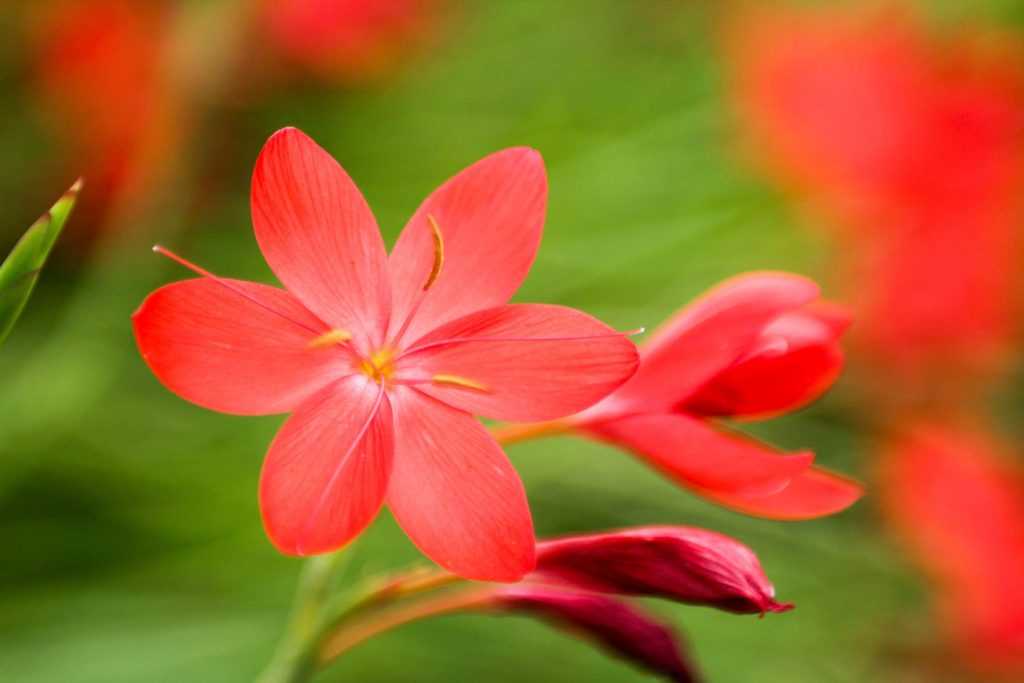
Updated: October 2019
If you are looking for a getaway from the busy London or just want to spend a day out in nature with your family, then a visit to Kew Gardens is the perfect answer. I have created for you the perfect guide with all the attractions of the Royal Botanical Gardens and everything you need to know about where to buy your ticket from and how to get there, to make your visit easier.
Where is Kew Gardens
Kew Gardens is situated in the South West of London, in the beautiful neighbourhood of Richmond upon Thames. Being the largest UNESCO world heritage site in London and more than 250 years old, Kew Gardens is the home of the Millennial Seed Bank, the biggest wild plant seed bank in the world. The Kew Estate occupies an area of 121 hectares home to over 30,000 plants. You can find here large flower and vegetables gardens, woodlands, lakes and ponds, conservatories, natural reserves and wildlife.
When is the best time to visit Kew Gardens
Kew Gardens is open every day from 10am until 6pm (from the end of March until the end of October). For the rest of the closing times (due to the shorter days), you can check the schedule here . Kew Gardens is great to visit in any season, including in winter, when they have some amazing light shows. During the year there are several exhibitions and events that transform completely Kew Gardens. You can see a list with what’s on this season here .
How long to spend at Kew Gardens? I would say a day is not enough and you would want to return if you want to see the entire Kew Gardens and palace.
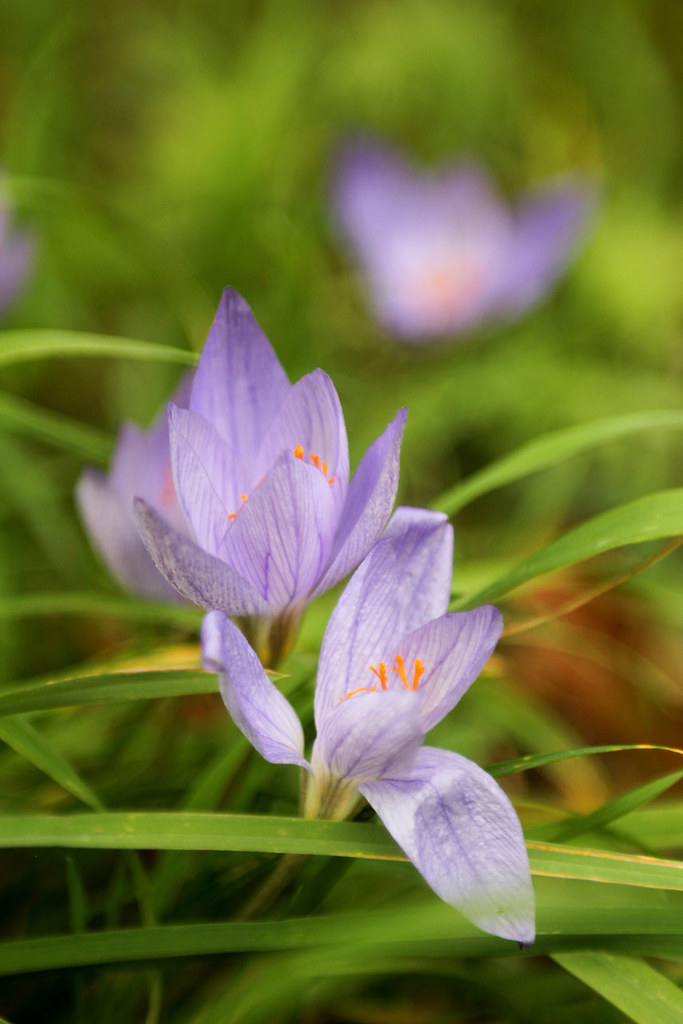
How to get to Kew Gardens
You can reach Kew Gardens very easy from central London by tube, the overground, bus or train. If you plan on traveling by tube, Kew Gardens is on the District line, in zone 3 (£3.30 one way with an Oyster or contactless card). The station is 500 meters from Victoria Gate.
If you choose to travel by train, South West Trains run services from Waterloo station via Clapham Junction and Vauxhall (£4.40 for a one-way ticket). The train station is 800 meters away from Elizabeth Gate.
Buses 65 (Ealing Broadway), 391 (Fulham), 267 (Fullwell) and 237 (White City) connect different parts of London to Kew Gardens as well.
In summer, there is a boat service that runs from Westminster Pier to Kew Pier (500 meters from Elizabeth Gate).
Parking at Kew Gardens: If you arrive by car, there is a parking at Kew Gardens, on Ferry Lane, near Brentford Gate – TW9 3AF. Parking at Kew Gardens costs £7/day for cars and it is free for mopeds and motorcycles. There are some limited free parking spaces on Kew Road after 10AM and keep in mind that restrictions do apply for most residential roads around the area. If you arrive by bicycle, there are bike racks at all four gates.
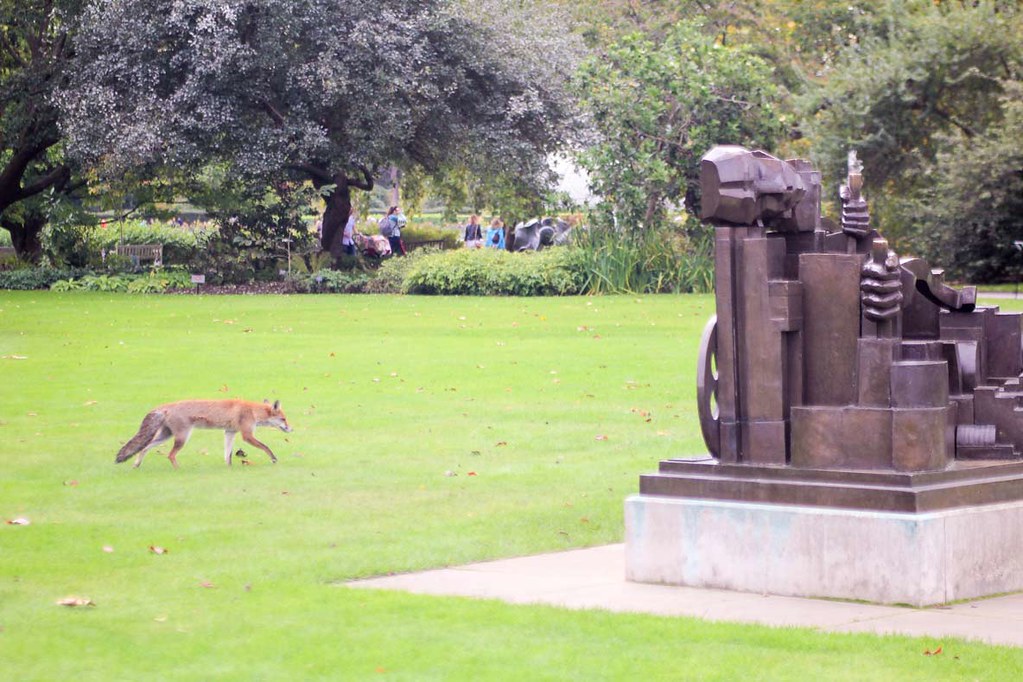
Where to buy your ticket for Kew Gardens
The Kew Gardens entrance fee is £13.50 when you buy it online, from the official Kew Gardens account from Get Your Guide . Note that you can’t buy tickets on the Kew Garden’s website directly. The cheapest place to buy your Kew Gardens and Palace ticket is online, where you can save up to 27% off the gate price. Not only that it’s cheaper but you will also skip the line at the gate, which in summer and during the weekends can get quite long. Click here to buy your ticket online.
In order to skip the queue make sure to print your ticket. For mobile tickets you will need to pass by the till, and the queue can be long during summer weekends. I know that many people are searching on Google if there is a Kew Gardens free entry and the answer in no, in order to visit Kew Gardens you do need to purchase a ticket.
How to plan your visit at Kew Gardens
Even if you are looking just to spend a day out in nature, planning is essential when visiting Kew Gardens because of the big number of attractions and the large area it occupies. You will receive a map of the gardens together with your ticket, but to make things easier, you can also download it from here .
It is hard to say how long to spend at Kew Gardens because it is such a big place. Depending on the purpose of your visit, you will find some suggested routes on the map. However, I will tell you all about the attractions at Kew and how to organise your time so that you can make the most out of your visit. I have started my visit to Kew Gardens from Victoria Gate and headed to the attractions from the East, finishing in the West hours later. I did take my time and enjoyed the strolls through the different gardens and conservatories, chased butterflies (for photos) or gazed at the carnivore plants have their hourly “shower”. I’ve even met some of the permanent residents: a courageous fox, a few curious ducks, a mamma squirrel with 2 baby squirrels behind her and a lonely peacock.
There are a few cafes and restaurants inside Kew Gardens but you are always welcomed to bring your own food if you prefer a picnic under the trees.
The Hive is probably Kew Garden’s most ambitious project, a masterpiece of scientific research resulting in an incredible visual and sound experience. Stepping inside The Hive is like experiencing the inside of a real beehive, with all the sounds and lights triggered by the actual honeybee activity inside the Kew. This makes every moment inside The Hive different.
The Hive was first built for the UK’s pavilion at the 2015 Milan Expo, by Wolfgang Buttress. It is 17 meters tall, it weighs 40 tonnes and it is built from 170,000 of aluminium parts with 1000 led lights.
Because it’s such a popular attraction, I would recommend making your way to The Hive as soon as you arrive at Kew Gardens (the earlier the better). It is a truly fascinating experience.
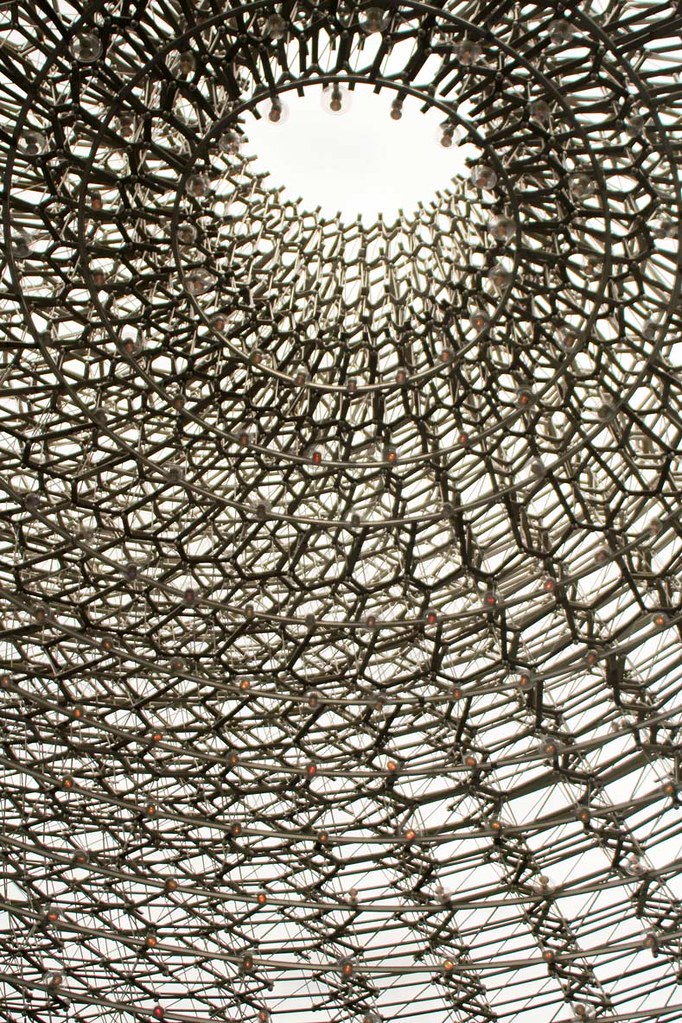
The Treetop Walkway
The Treetop Walkway is a very exciting “climb” for the entire family, especially for children. The metal structure is 18 meters above the ground, 200 meters long and sways in the wind. The views from up there are pretty awesome, over the forest canopy. Some parts of the walkway pass through the branches of the chestnut and oak trees, on which you can observe different birds and insects.

The structure of the walkway was made in such a way that the rust made it look like it blends perfectly with the environment next to it. At the bottom you will find the Rhizotron, an underground laboratory where visitors can learn about how trees grow.
There are 118 steps up to the walkway.
The Palm House
Inside the Palm House you will discover a world of rare and even extinct plants (in the wild) that are growing here due to the efforts of the Kew scientists.

You will find here trees that are at the base of many products that we consume every day: the rubber tree, the Cocoa tree, the Pepper tree (I didn’t even know that pepper grew in a tree!), the sugar cane, the African oil palm or the coffee tree.
The building itself dates from 1844 and it’s an iconic Victorian building made from glass and iron, resembling the hull of a ship. This is because the architects have used techniques from the ship building industry when they designed the glass house.
Davies Alpine House
The Alpine House is quite the masterpiece of architecture if we take in consideration that it was built in such a way that 90% of the ultraviolet light of the sun passes through to the plants, in has an automatic system of blinds that go down when the temperature is too high outside and the air is cooled down though a system of pipes underneath the building.
There are over 200 alpine plants here, which is the wild are usually growing at altitudes of 2000+ meters.
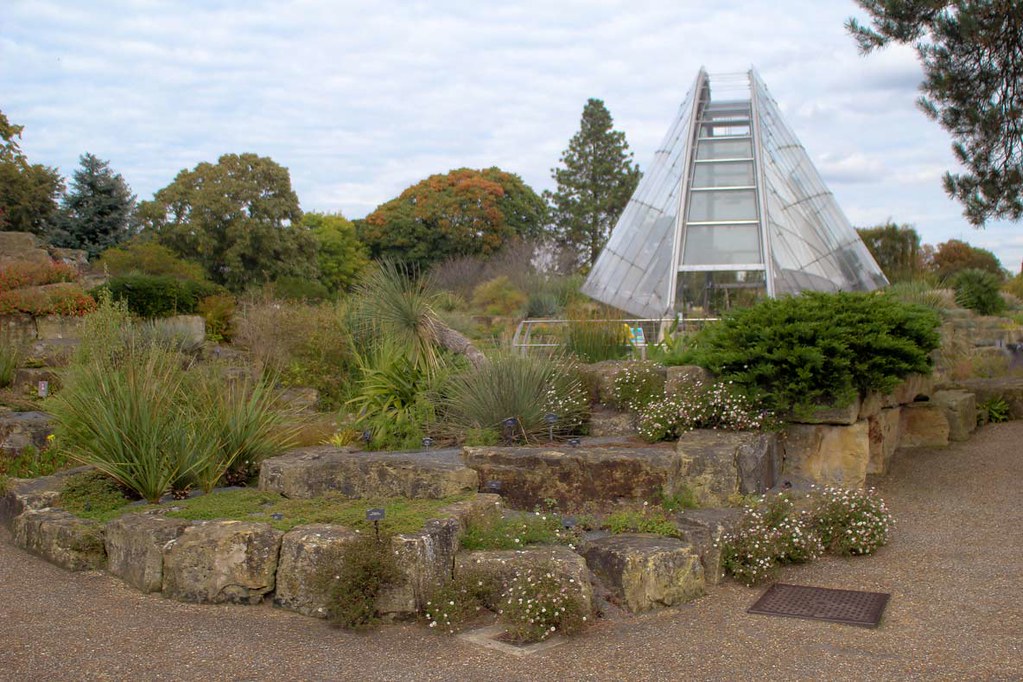
The Temperate House
The Temperate House is currently closed for restauration and it will be opened sometimes next year, after 5 years of works. Inside the Temperate House there are collections of very rare and threatened species of plants. Some of the plants you will see here have been extinct in the wild and only live at Kew. Such a plant is the Encephalartos woodii (The South African cycad).
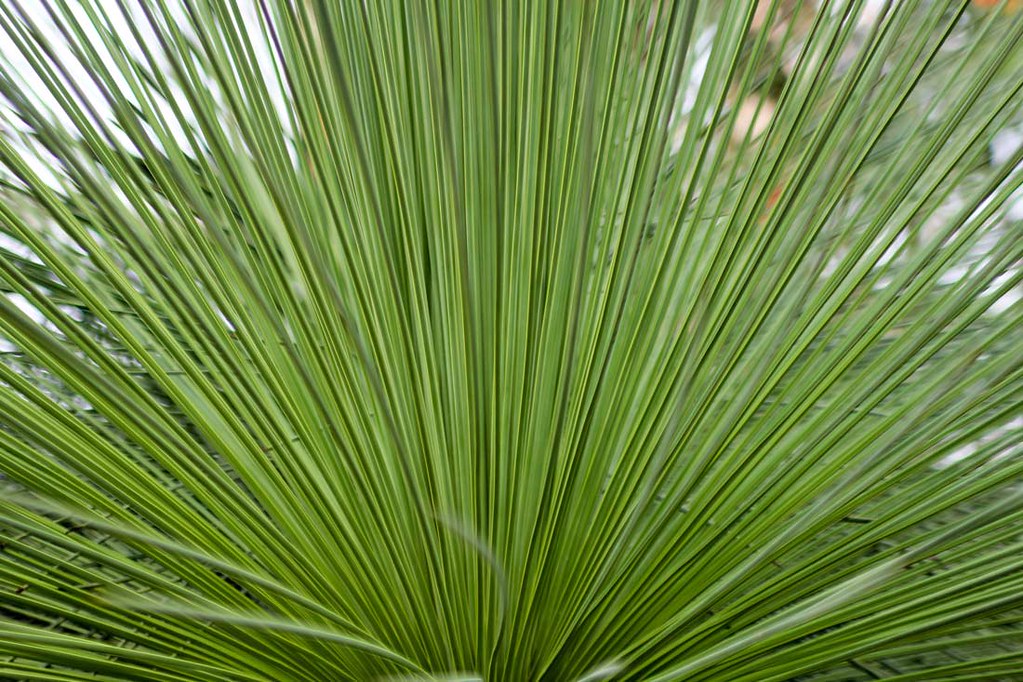
The Waterlily House
Have you ever seen a giant waterlily? Me neither, before visiting Kew Gardens. The Waterlily house is the most humid greenhouse from Kew Gardens and is the home of many heat loving plants. It was interesting to learn how the waterlilies from Amazon can grow so big that they can support a child’s weight. Of course, it is not recommended (or allowed) to let your child jump on them, but still it’s amazing how much strength these plants hold on their leaves.
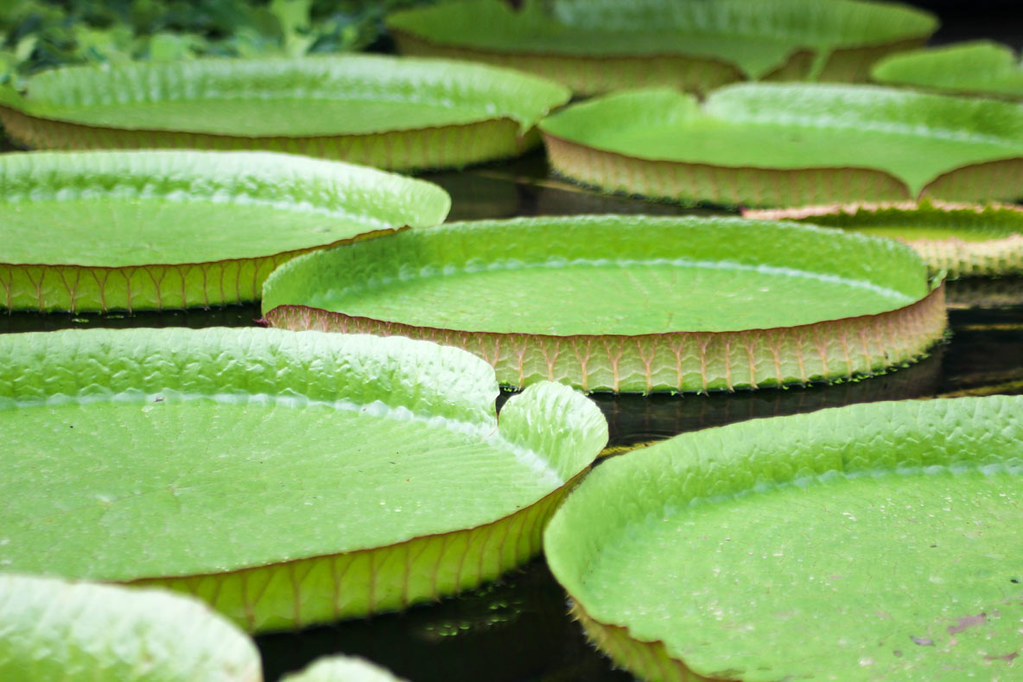
The Princess of Wales Conservatory
Stepping into the Princess of Wales Conservatory is like entering the jungle from an exotic destination, like Malaysia or Indonesia. The first thing you notice is the high humidity and the warm temperature. But no wonder, this conservatory is home to many tropical plants, cacti and orchids. You will also find here a large collection of carnivore plants, out of which I recognised the Venus Fly Trap, which I once tried to grow in my own apartment.
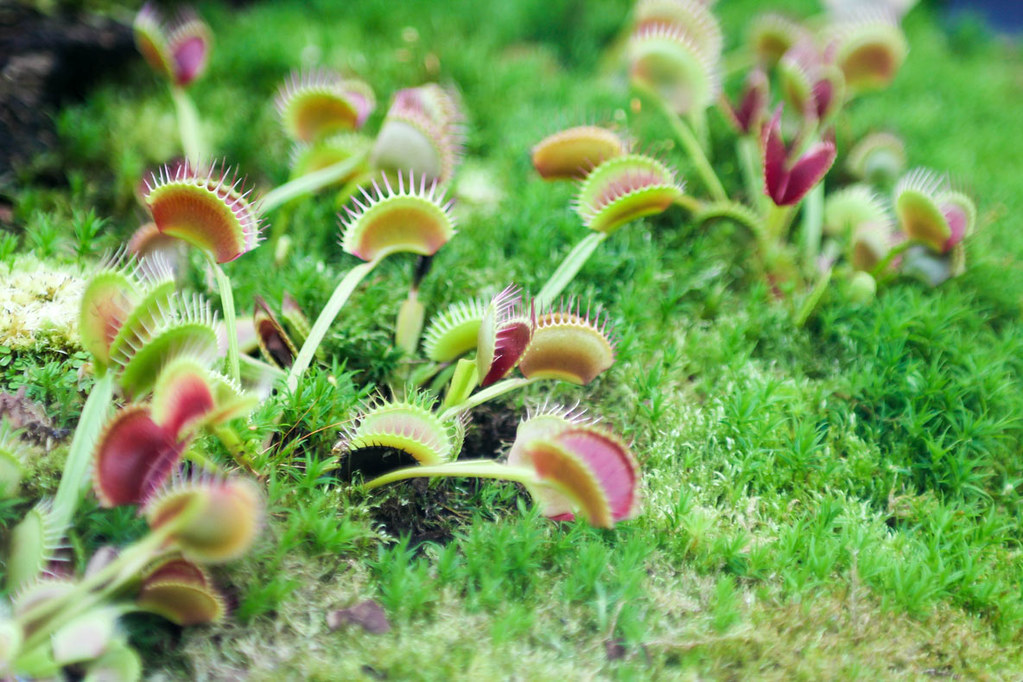
An interesting fact is that below the conservatory there is a time capsule buried by Sir David Attenborough, with seeds of basic crops, endangered plant species but also a few books on conservation. The capsule will be opened in 2085.
The Arboretum
One fantastic fact about Kew Gardens is that the trees planted here are cleaning the air in London, with over 8.6 tonnes of carbon dioxide absorbed each year. There are around 14,000 trees in the Royal Botanical Gardens, some of them as old as the garden itself, dating all the way back from the 18 th century. The trees are planted in groups according to their species (over 2,000), with some very rare and ancient ones. The tallest tree at Kew Gardens is a coastal redwood, measuring 39,3 meters high, while the oldest ones are the Japanese pagoda tree (around 250 years old), the Lucombe Oak and the black locust tree.

Strolling inside the oak forest made me feel that I was in a different place, not in London but Canada or somewhere in North America.
The Plant Family Beds and the Kitchen Garden
This was one of my favourite parts of the garden to walk in. Even if it was autumn when I visited and not many species were still blooming, I enjoyed all the colours and the pretty butterflies flying from one flower to another.
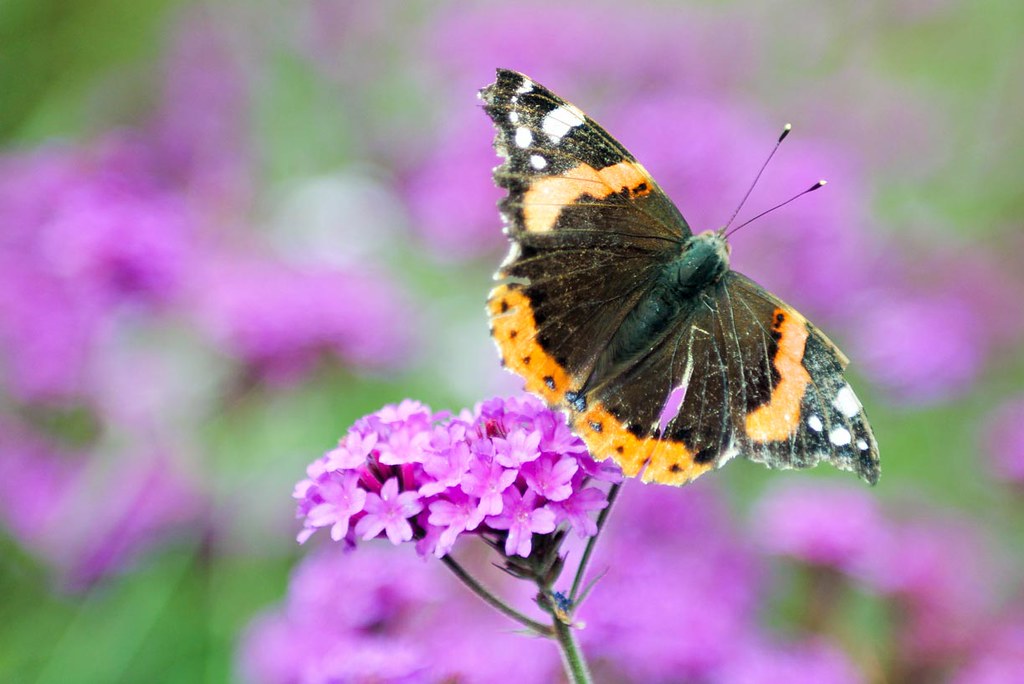
The plant family beds are found in any botanical garden in the world and represent the arrangement of plants according to their relationship with each other. The scientists at Kew have been researching about the way plants relate to each other through their DNA and molecular characteristics.
Next to the Plant Family Beds is the Kitchen Garden, an area where fruits and vegetables have been grown all the way back since 1759, for King George III. Today there are over 250 different fruits and vegetables growing in the garden. I was delighted to see apples, pumpkins, a few giant cabbages and some turnips.
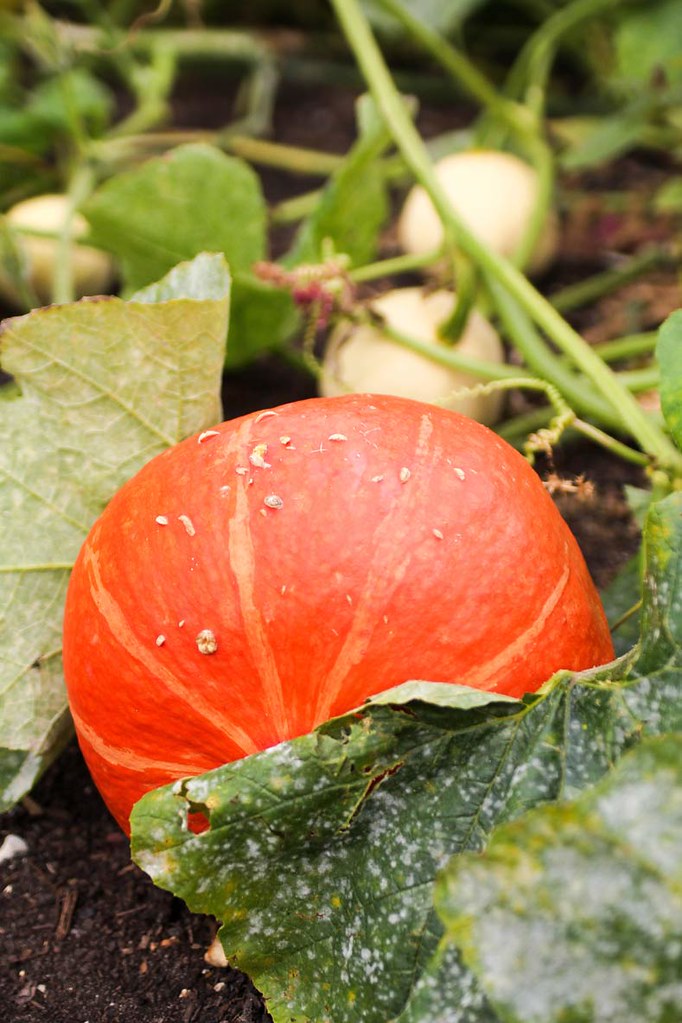
The Rock Garden
I didn’t really know what to expect from the Rock Garden until I found myself going downhill, through a path surrounded by colourful plants growing on high sandstones. The rock garden is a representation of the Pyrenean mountain habitat, a 150 meters valley with the path passing through simulating the course of a river. The rock garden is the home of over 3,000 alpine plants originally from Europe, South and North America, Asia, Africa and the Mediterranean climate, Australia and North America.

The Kew Palace and the Queen’s Garden
Kew Palace is the smallest British royal Palace and it is best known as the temporary “refuge” of King George III, the place where he was locked during his “madness” period. Beforehand however, the palace was used by the King and his family as a summer residence.

The Palace was built in 1631 but a Dutch Architect and this is why it looks like a piece of Netherlands on UK soil. If you look closely over the front door, you will notice a lover’s knot with the initials C and S on it. They stand for Samuel Fortrey, the Flemish merchant who built the palace and his wife, Catherine de Latfeur. The symbol of their love stands there even 400 years after their death!
Currently the Palace is closed for winter.
In the rear of the Kew Palace you will find a charming little garden with plants that used to grow in the 17 th century. Most of them are medicinal plants and on the label next to them you will find what they were used for and a quote from an herbal book.
Queen Charlotte’s Cottage
King George III has built this cottage for his wife, Charlotte, in the 18 th century. The cottage was used as a resting place during their walk and had a small menagerie in the back where exotic animals like kangaroos or black swans were held.
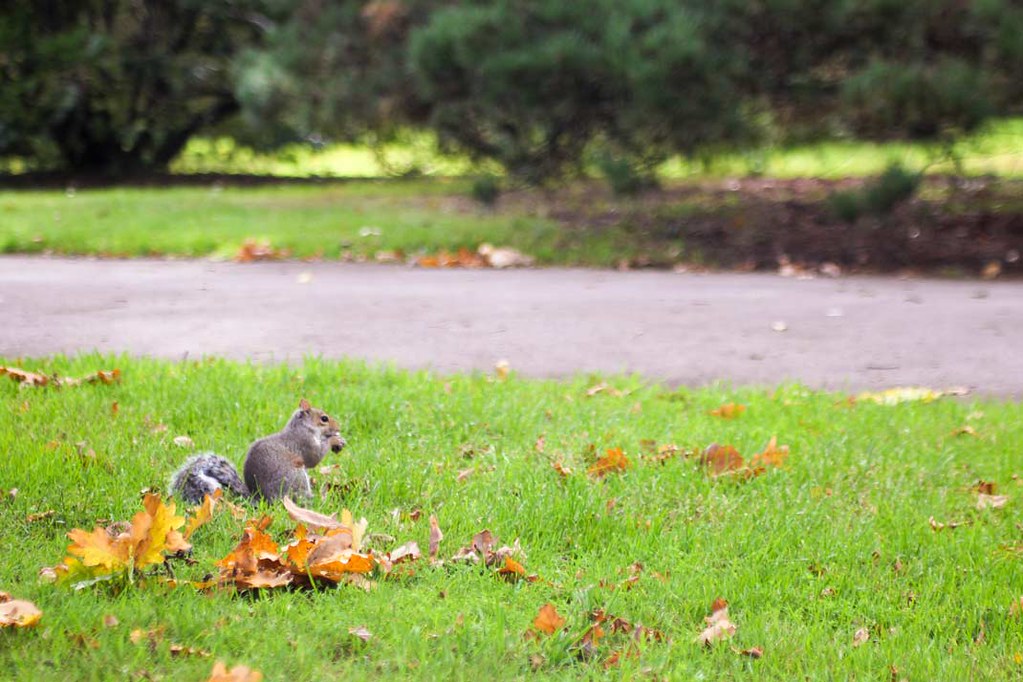
The Minka House and the Bamboo Garden
Towards the back of Kew Gardens, after walking through the beautiful quiet forests, in the middle of the bamboo garden you will find the Minka House, an original traditional Japanese farmhouse. The house dates from the early 19 th century and it was used by Yonezu family from Okazaki City, in central Japan. It was donated to Kew Gardens after the last member of the family died.
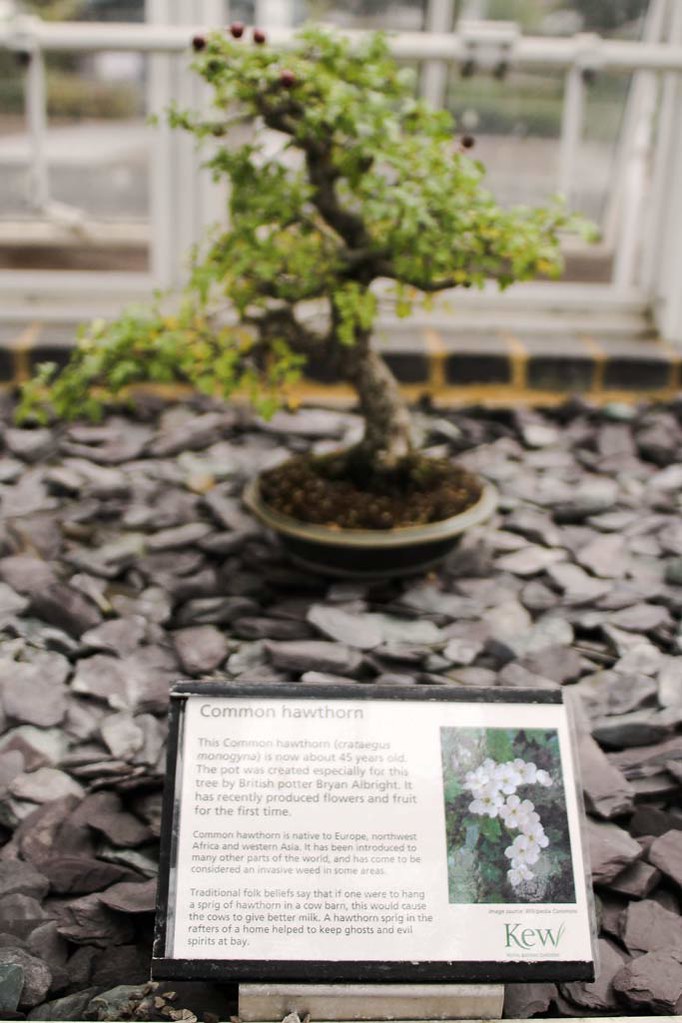
The Minka houses were used by farmers, merchants or artisans and they were built with a low roof to protect them from rain and snow but also to keep them shade from the hot summers. They were divided into 2 areas: the floor of compacted earth and a raised platform for sleeping, with a built-in hearth for cooking and heating.
The Bamboo Garden is one of the UK’s largest collection, with around 1200 species growing around the Minka House.
The Great Pagoda
Unfortunately, the Pagoda was still under renovation when I visited Kew Gardens but rumours say that it’s supposed to open again to the public next year.
The Pagoda has been built in 1762 as a copy of the Chinese Ta. Back then it was such an unusual building in Europe that people didn’t believe it would stand up for long. However, it did and now the 10-storey high tower is one of the garden’s landmarks.
The pagoda is decorated with 80 wooden dragons and covered in ceramic tiles. A local tale says that the dragons used to be made from gold but have been sold by Kind George IV to cover his debt. Historians say that this is not true, the dragons were carved in wood from the beginning but overtime, they have rotten.
The Japanese Garden
Next to the Grand Pagoda you will find the beautiful and peaceful Japanese Garden, split into three areas: The Garden of Peace, The Garden of Activity and The Garden of Harmony. All three are leading up towards the Chokushi-Mon, a four-fifths scale replica of the gate from Kyoto’s Nishi Hongan-ji temple.

The Garden of Peace is created to resemble a traditional Japanese garden, with stone lanterns and a dripping water basin. The Garden of Activity symbolises the world, with elements reminding us of the sea, the mountains and the waterfalls. Between them stands the Garden of Harmony, linking them through shrubs and tocks representing the mountains of Japan.
The Sackler Crossing
Crossing the Sackler bridge I couldn’t not notice the beautiful reflections of the autumnal colours of the trees, in the water. It looked like the two entities are blending into each other, not knowing anymore which is the lake and which is the land. This is because the trees surrounding the lake are Chinese tupelo, known for their dramatic colour change in autumn.

The Slacker Crossing is made out of black granite, with bronze posts which from a distance give the impression of a solid wall. The bridge crosses the lake in an S shape, mimicking the rounded banks of the lake.

Rhododendron Dell
If you are wondering what a rhododendron is, you are not alone. I was asking myself the same thing while looking at the map of Kew Gardens and wondering if I should make my way all the way to the other side or now. To answer the question, yes, do make your way up there because rhododendrons are beautiful woody flower shrubs which grow up high in the mountains. The most common of them is the azalea, a flower we all know.
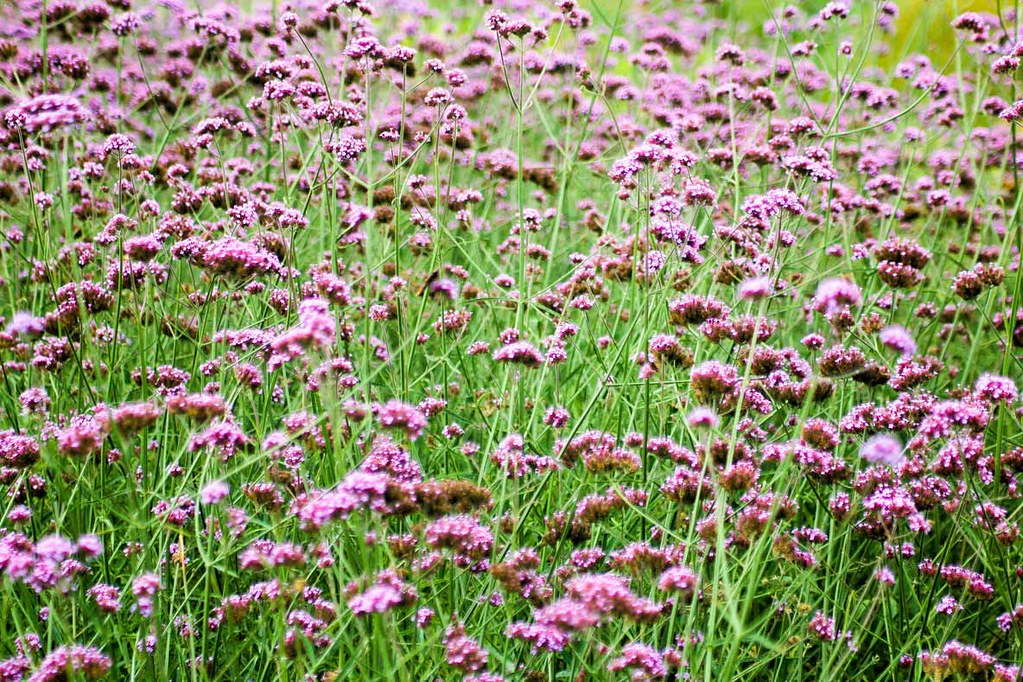
The rhododendron represents over 1000 different species of plants, out of which you can find hundreds at Kew Gardens. They are best seen in late spring, when they are all in full bloom.
The Woodland Garden and the temple of Aeolus
The original temple of Aeolus was built out of wood on an artificial mound, offering beautiful views over the gardens. However, by the middle of the 18 th century it has been rebuilt in stone because the wood had rotten. The temple was dedicated to the Greek God of Winds.
The temple is surrounded today by oaks and maple trees and led to by a path through a carpet of primulas and blue poppies.
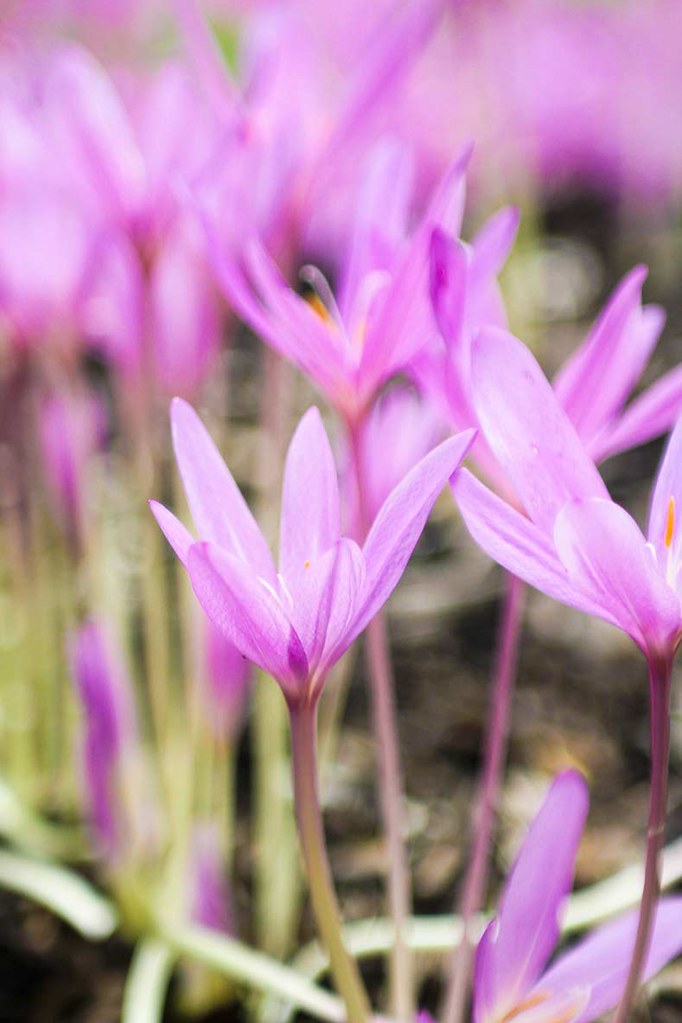
The Marianne North Gallery
This gallery is dedicated to Marianne North, the daughter of an MP who travelled alone in South America, Asia, South Africa and America to paint plants. Back in her days it was very unusual for a woman to travel alone. The gallery has 832 paintings, all belonging to Marianne North.
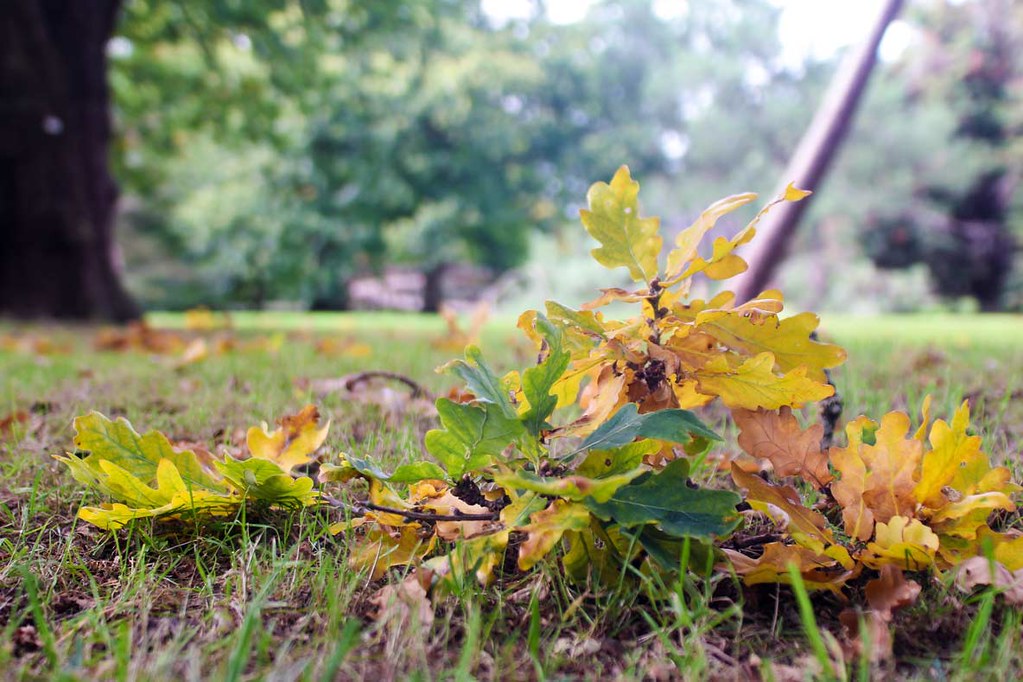
The Shirley Sherwood Gallery
Next to the Marianne North Gallery you will find the Shirley Sherwood collection of botanical art, one of the largest in the world. The oldest piece is in the museum dates from 512 and represents an illustrated copy of the Dioscorides’ de Materia Medica, a book written between 50AD and 70AD by a Greek physician from the Roman army, Pedanius Dioscorides.
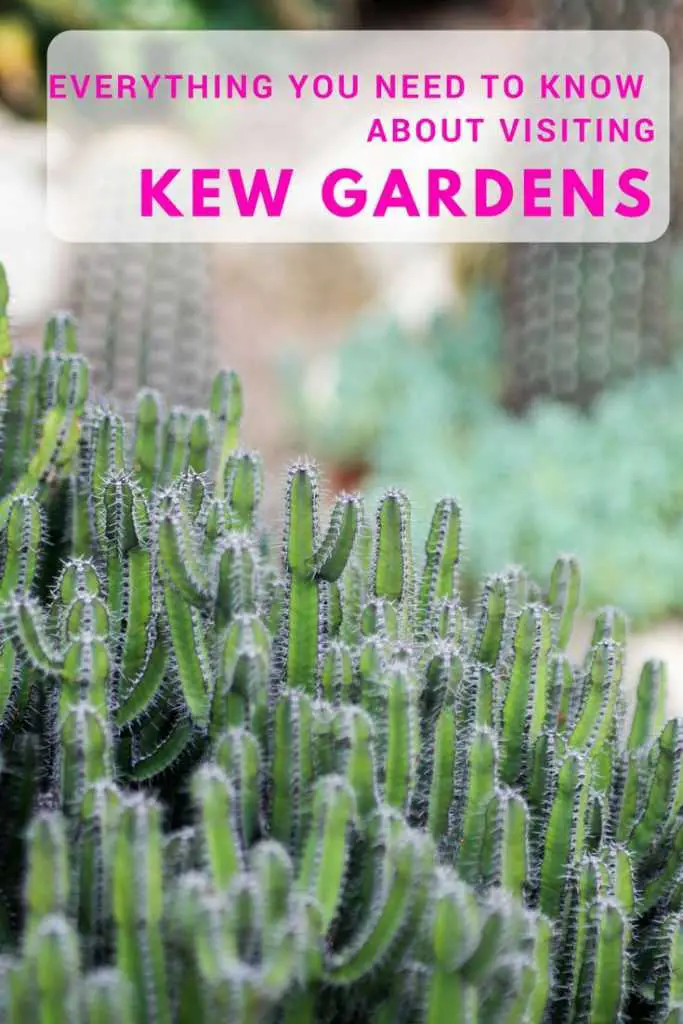
Disclaimer: This post has been written in collaboration with Attraction Tix .
Some of the links on this website are “affiliate links.” This means that if you click on the link and do a purchase, I will receive an affiliate commission at no extra cost for you. This helps me keep my website running and continue to share my traveling knowledge with you. I thank you for booking your flights or hotels using the links on my website. Regardless, I only recommend products or services I use personally and believe will add value to my readers.
Related Posts:

Traveler. Dreamer. Cat lover. Wondering around the world with my backpack and my camera. Contributing to make the world a better place.
110 thoughts on “ Everything you need to know about visiting Kew Gardens in London ”
I live just a few miles up the road from Kew Gardens and haven’t been since I was a young child and barely remember it (entrance cost 1p back then!), however we are visiting this weekend and very much looking forward to it. I’d forgotten just how enormous it is. My late aunt worked there pressing flowers which she loved. Your guide has been useful in deciding what to see during our visit (basically as much as possible but definitely The Hive, treetop walk, Pagoda, Palace etc etc). Think we could do with two whole days! Your pictures are wonderful and I’m sure I will be taking many this weekend. Anyone wanting a lovely lunch or proper afternoon tea whilst visiting the gardens, there is a gorgeous olde worlde tea room across the main road called Newens (Maids of Honour) that I highly recommend. It gets very busy though as it’s so popular with tourists and locals alike. By the way, anyone thinking Kew is amidst the hustle and bustle of central London, it isn’t, it’s on the outskirts, in suburbia ;). There are many beautiful, open green spaces in London and its suburbs.
Wow, as a Northener, I had no idea that there was so much to do and see at Kew Gardens. It looks wonderful and I really want to visit after reading your guide and looking at your beautiful photographs. It’s definitely going to be on my must-see list of places x
Oh wow, this is such an informative guide – you have covered so much! The photos are beautiful. I have always wanted to go to Kew but so far not made it. Hopefully one day! X
I’m so glad that I found this! I am visiting London on December and I will definitely go to Kew Gardens. I am putting it to a list of places I must visit in London. 🙂
This looks like a beautiful place to visit. If I am ever in London I will have to stop by.
Its so nice to visit some places like this. Peaceful and relaxing. London is on our bucketlist and we will definitely find this place there.
Leave a Reply Cancel reply
Your email address will not be published. Required fields are marked *
This site uses Akismet to reduce spam. Learn how your comment data is processed .
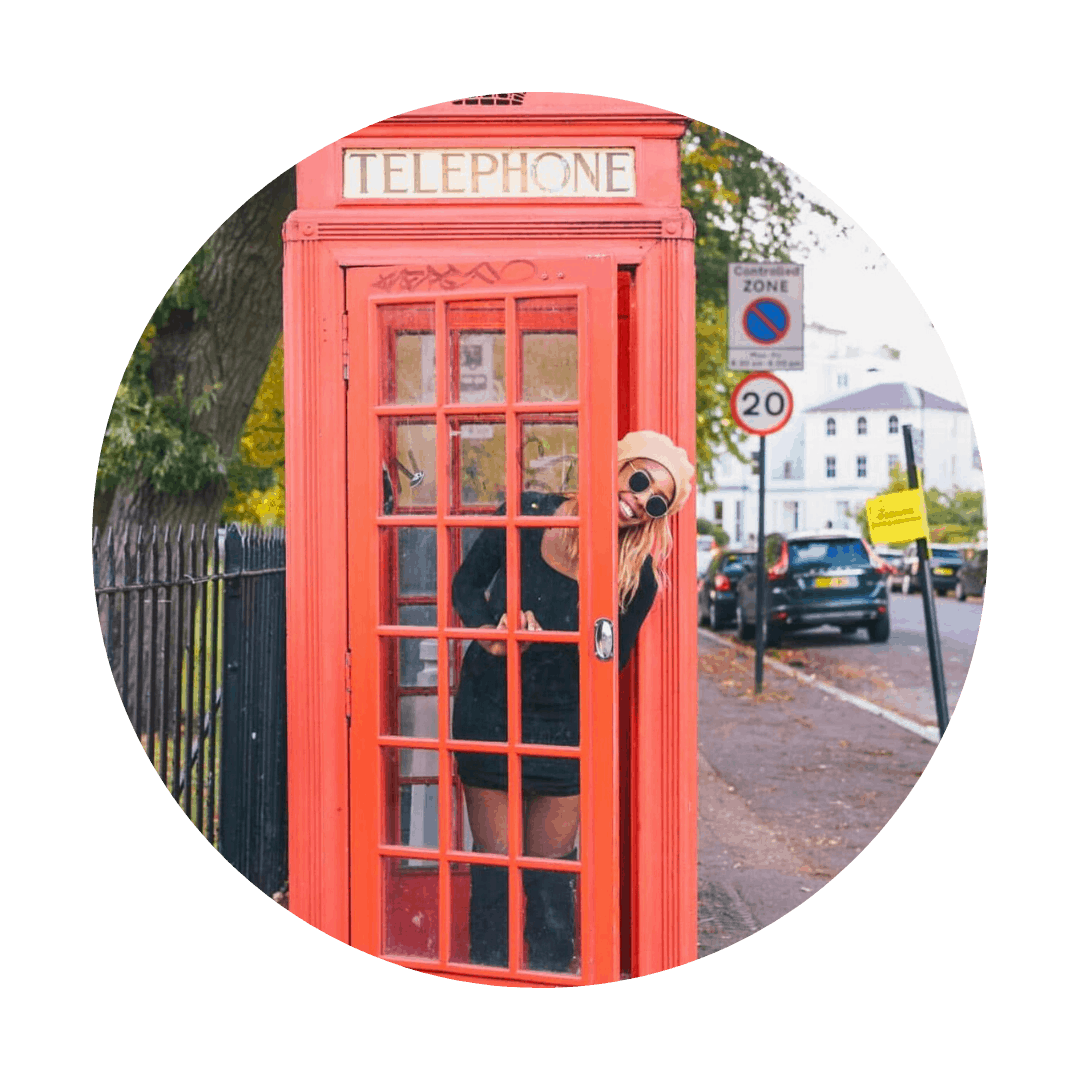
Hi, I'm Candace
Candace Abroad
A London & Travel Blog

London , London Parks, Gardens & Mews , London Tours & Experiences , London Travel Tips & Inspiration · January 30, 2024
The Best Kew Gardens Tips: A Local’s Guide (2024)

Table of Contents
Looking for the best Kew Gardens tips? Look no further! Here’s your ultimate guide to the UNESCO World Heritage Site — from a Londoner!
This post may contain affiliate links. Check out my Disclosure & Privacy Policy for more information.
London may be known as ‘the Big Smoke’, but it’s also the home of the largest and most diverse botanical and mycological collections in the world. You guessed it – Kew Gardens !
And if there’s one thing we Londoners cherish, is a city oasis. So it’s no wonder it appeals to seasoned botanists, plant enthusiasts, and even the rookies that are just eager to change the landscape for once.
Are you one of them? Well, lucky for you, as a long-time local, I’m full with insider tips that’ll let you step into a world of exotic plants like the seasoned explorers.
We’ve got plenty of ground to cover, so don your adventurous hat and join me as I spill the tea about experiencing Kew Gardens like a real pro!
The Best Kew Gardens Tips to Visit Like a Pro

Kew Gardens in a Nutshell
🪷 Overview: Nestled about 30 minutes from Central London, it’s a UNESCO World Heritage Site that exists since 1759 and has over 30,000 different plant and seed species from around the world.
📍 Location : Conveniently located at Richmond (TW9 3AE), it’s just a stone’s throw away from the Kew Gardens station (which has its own pub!).
🕙 Opening Hours : The gates open wide every day from 10am, giving you all the daylight you need to explore its treasures. Closing times depend on the season, starting from 4pm during winter until 7pm during summer (last entry is always one hour before closing).
🎫 Tickets : A modest fee aids in the preservation of this green oasis — and it’s worth every penny! Adult tickets start from £12 for off peak weekdays until £24 for peak weekends. Kids under 4 go free and tickets for those under 15 start at £4. There are also concessions available. Check all prices here.
P. S. – Entrance is also included on The London Pass , so if you’re visiting London and planning to go to many tourist destinations, this could save you loads!
⏳ Suggested Duration: I’d highly recommend spending at least 3 hours here, giving you plenty of time to wander, lose yourself, and even take a well-deserved break at one of the cafés and restaurants.

Photo courtesy: Kew Gardens
Planning Your Visit to Kew Gardens

When planning your visit to this green paradise, timing and researching is everything. Here’s the most important things to consider!
Best Time to Visit
For the best Kew experience, try to visit during spring (late March to early June). Nothing can match the vibrant colours, delightful scents, and the cheerful song of birds — it’s an absolute treat for the senses!
Summer (June to August) definitely comes second, although autumn (September to mid November) is magical considering you get to see the changing of the seasons.
And while winter (late November to late February) isn’t the best time to go, consider tickets are cheaper. Plus, you can join the UK’s most acclaimed festive trail !
Regarding times, if you fancy a bit of peaceful solitude, drop by in the early morning or late afternoon, when the park is blissfully serene. It’s ideal for a leisurely stroll or a quick snap for the gram without the crowds photobombing your shot.
Plan a Route
Being an experienced local, I strongly suggest plotting your route in advance to make sure you don’t miss out on the best things to see here (more on that later).
Seeing the map for the first time might seem a bit overwhelming for first-time visitors, but don’t panic! The garden’s extremely user-friendly layout won’t let you stray too far.
Consider Guided Tours
Now if you prefer a touch of narrative to your visit, consider joining one of the daily guided tours for an introduction to the Gardens (at 11am and 1:30pm). It’s an excellent way to discover lesser-known tales of the site, enjoy expert insights about the flora and fauna, and even pick up a gardening tip or two.
If you’re visiting during winter, the winter highlights walking tour is an amazing opportunity to discover the plants that come (more) alive during the season.
How to Get to Kew Gardens

Like (almost) anything in London, getting to Kew Gardens is a breeze thanks to the public transport and great connections. Pick your method!
By Tube : Hop into the District line to Kew Gardens station. The Victoria Gate entrance is merely 500m away (and the walk in the neighbourhood is lovely!).
By Train: If you’re travelling from Central London or Surrey, the Southwest Trains from Waterloo offer a smooth ride to Kew Bridge station. From there, it’s a 10 minute walk to the Elizabeth Gate. Or you can go to Richmond station and pop in the 65 bus or the District Line.
By Bus: The iconic red buses also reach the gardens; the 65 stops close to Lion Gate, Elizabeth Gate and Victoria Gate, the 110 stops near Kew Gardens station and Elizabeth Gate; and the 237 and 267 stop at Kew Bridge station.
By Car: For those enjoying the pleasure of their own wheels, you can find plenty of street parking around Kew, but do it responsibly and respect the locals, please. There’s also a carpark near Brentford Gate, which costs £7 for a full day’s use.
By River Cruise: Eager to make a huge entrance? Sailing into Kew by river cruise is as splendid as it gets. Companies like Thames River Boats offer trips from Westminster Pier straight to Kew.
Top Things to See at Kew Gardens

Brace yourself for a fantastic and long list of things you can’t miss while in Kew Gardens. Grab a map, you’re going to need it!
The tiniest royal palace in the UK is in Kew Gardens, where you can have a fascinating peek into royal family life back in the days. The gardens surrounding it? Gorgeous, of course!
The Palm House
This mesmerising iron and glass structure houses a mind-blowing collection of rainforest plants. It’s an exotic world amidst a misty environment!
The Temperate House
The world’s largest Victorian glasshouse is full with some of the rarest temperate zone plants, including ornamental blooms that make it a top favourite amongst plant lovers.
The Tree Top Walkway
For a sky-piercing perspective of the gardens, ascend the 18-metres-high structure that puts you in a privileged position only birds can enjoy!

The Japanese Minka House and Pagoda
This corner of Kew adorned with Japanese style architecture embodies a zen-like serenity, a refreshing break from the quintessential English garden.
The Princess of Wales Conservatory
Want a tour around the world? This is the place! Part greenhouse, part adventure, you can find species from ten different climate zones under one roof, from cacti (my favourite!) to orchids.
The Waterlily House
Channel your inner Monet at Kew’s hottest and most humid house, filled with vividly colourful waterlilies and lotuses. These floating beauties create a dreamy atmosphere that’s truly Instagram-worthy!
Queen Charlotte’s Cottage
Take a leisurely stroll off the beaten paths and discover this rustic royal retreat that was donated by Queen Victoria with one special request – the landscape must be left in an uncultivated state.

An innovative multi-sensory experience awaits inside a gigantic lattice structure, mimicking a real beehive (the nature one, not Beyonce’s) using speakers and LEDs.
Davies Alpine House
End your Kew exploration on high—quite literally. This architectural marvel houses a variety of alpine flora meticulously pruned and cared for.
Kew Gardens Tips to Explore Like a Pro

Kew Gardens tips to visit like a pro involves more than knowing where to go and what to expect. It requires you to be extra savvy when packing for the day!
1. Prepare for the Weather
I’ve asked this before, and I’ll ask it again. When is it not going to be about the weather in London!? Don’t panic, though, in this case is more about considering a light jacket. Easy to fling off in the warmth of the greenhouses or to cosy up when outside.
2. Wear Comfortable Shoes
When you’re on a mission to conquer all the floral delights at Kew, choose footwear that’s kind to your soles. Believe me, you’ll walk more than Jane from Tarzan in the jungle.
3. Bring Everything You Need
Pack a (light) bag with essentials for your adventure: a water bottle, sunscreen, a few snacks to refuel, and a portable charger if capturing the sights of Kew is on your ‘to-do’ list.
4. Check Their Upcoming Events
Don’t forget to dice into their calendar of upcoming events , The gardens serve up a charming mix of music concerts, art installations, yoga sessions, food festivals, and so much more!
5. If you’re coming with kids…
For the little explorers, Kew is an amazing playground. From the Climbers and Creepers play area to interactive family trails and activities; compile a list of must-see clusters to let the kids genuinely enjoy, engage, and become mini environmental champions.
Where to Eat in Kew Gardens

A Kew Gardens exploration takes time, so you’ll need a break. Why not stop at one of their amazing cafes and restaurants, or bring your own picnic to the gardens?
On-site Cafes and Restaurants
Family Kitchen : Offering a no fuss menu, this one’s set to appeal the youngest of the adventurers in your party. You’ll enjoy pizzas, sandwiches and even ice cream in a relaxed and up-beat environment.
Pavilion Bar and Grill : Splurge on some sizzling grills and salads at the inviting sun-kissed terrace overlooking the beautiful gardens—alfresco dining with style!
The Orangery : For something fast and informal, head here to enjoy coffee, cakes, and light meals. Available for either take away or eat in.
The Botanical Brasserie: This one’s an all-day formal dining with modern British cuisine, offering everything from breakfast, lunch to afternoon tea.
Victoria Plaza Café: Perfect for a coffee break throughout the day! Look out for their reusable cup scheme, as they’re hoping to save over 20 thousand single-use cups.
Picnic Areas and Rules
Replete with sprawling greens and never-ending blue skies, Kew Gardens can be your perfect picnic postcard setting. But you need to be careful to avoid causing any disruption!
You can use any grassy area to do your picnic, but these don’t include those by the restaurants, buildings and glasshouses. Some of my favourite spots are The Arboretrum , the Palm House Pond and Cedar Vista (with gorgeous views of the Pagoda).
To ensure a zero-impact picnic, it’s not allowed to bring barbecues or picnic furniture . You should also bring a picnic bag to pop your rubbish and dispose responsibly.
Alcohol is permitted (with moderation!), and while music isn’t, you can still bring a pair of headsets to enjoy your favourite tunes.
Shopping at Kew Gardens

Ready to head off? Don’t forget your souvenir! The last Kew Garden tip is to invest some time (and money!) at the end of your day here.
Kew Gardens’ gift shops and plant nurseries are a delightful treasure hunt, where you’ll find everything nature-inspired.
From exclusive botanical prints to Kew-inspired ceramics and delicate jewellery, a book collection that pleases the youngest and oldest, and a vast collection of scents in aromatic candles, fragrant soaps, and indulgent botanical skincare.
Oh! And how could I forget!? Of course you can add a new member (or hundreds!) to your plant family at home, be it an exotic orchid, a cacti variety, or even a bonsai!
Honestly, you can add a whole extra hour to exploring them, as the marvels are infinite here.
Kew Gardens FAQs
Q: is it worth going to kew gardens.
A: Absolutely! Kew Gardens is an explorer’s dream in London, an oasis full of botanical surprises and just a fun adventure overall.
Q: How long should you spend at Kew Gardens?
A: With over 300 acres of enchantment to uncover, you’d ideally want to spend an entire day at Kew Gardens, if not more. But if you need to keep it tight, consider 3 hours as a minimum.
Q: What is the best time of day to visit Kew Gardens?
A: The early morning hours, just as Kew Gardens opens its gates, often gift its visitors with dew-kissed greenery, chirping birdsong, and fewer crowds—a mesmerising start to the day!
Q: What’s best to see at Kew Gardens?
A: It’s difficult to pick! But consider paying a visit to the largest Victorian glasshouse in the world, the exhilarating tree-top walkway, the Princess of Wales Conservatory, and the fascinating Hive installation.
Q: Can you walk around Kew Gardens for free?
A: While Kew Gardens nurtures an open spirit of discovery, it’s not a free-for-walk space; a ticket purchase is required to contribute to its ongoing maintenance and preservation initiatives. But trust me, it’s worth it.
Q: What is Kew Gardens like?
A: Kew Gardens is like walking in what paradise is usually described like. It’s a place with endless trails of sounds, smells, colours and textures, both on the ground and in the sky. A sensory journey paralleled by none!
Thanks for reading my Kew Gardens Tips Guide. If you enjoyed it, let me know on Instagram !
Check out more london guides:.
- 50+ Beautiful Parks and Gardens in London To Explore ASAP!
- 5 Magic Things to do in Richmond Park, London
- Where to See Gorgeous Spring Flowers in London
- 5 Best Things to do in Holland Park, London (+ Map!)
- 19 Best Secret Things to do in London
- Your Ultimate Summer Guide to London
Happy Londoning,

Get on the List
You’ll also love.

Latest from Instagram
Follow @candaceabroad
Moving to London? Check out my Digital Moving Guide!

join the monthly newsletter
Subscribe for itinerary inspiration, travel inspo & exclusive content straight to your lovely inbox.
Affiliate disclosure
Theme by 17th Avenue Designs
Disclosure & Privacy Policy
Copyright © 2024 Candace Abroad Theme by 17th Avenue
Kew Gardens In London – A Complete Guide
Posted on Last updated: 23 March 2024
Categories England , London
Beautiful Kew Gardens, London’s largest World Heritage Site, is not just home to an enormous collection of plants. Here’s a guide to visiting.
Table of Contents
How To Get To Kew Gardens
Kew Gardens is located on the outskirts of the city of London in the Borough of Richmond Upon Thames.
Parking is limited, so it’s recommended that you use public transport to get there.
From central London, Route 65 stops close to the following Kew Garden entrances – Lion Gate, Elizabeth Gate and Victoria Gate.
Route 110 stops near Kew Gardens station and Elizabeth Gate. Routes 237 and 267 stop at Kew Bridge station.
All single bus routes are presently £2 and the journey time varies depending on traffic.
It takes approximately half an hour to reach Kew Gardens by train from central London.
You can get a South Western Railway train from London Waterloo or, for the fastest train from London to Kew Gardens, hop on at Clapham Junction.
Kew Bridge Station is the nearest to Kew Gardens. From Kew Bridge, you’re just 800m from the Elizabeth Gate entrance.
Tickets start at £6.40 one way.
Kew Gardens Station is the nearest tube station to the garden. This station is just 500m from the Victoria Gate entrance at Kew Gardens.
You can take one direct tube, on the District Line, from London Victoria to Kew Gardens Underground Station. Tubes leave every 15 minutes and the journey takes approximately 30 minutes.
Tickets cost between £2 – £5.
For those short on time, or those that prefer everything to be organised for them, there are some awesome tours on Get Your Guide available to book in advance.
Also, for all tourists visiting London, I recommend purchasing a Go City London Pass .
These are a great way of saving money when visiting multiple tourist attractions during your stay in London.
Kew Gardens Entrance Fee
1st February to 31st October (Peak)
Adults: £21.50 (£17 in advance).
1st November to 31st January (Off Peak)
Adults: £14 (£12 in advance)

Kew Gardens Opening Times
Kew Gardens is open every day, except for 24th and 25th December.
Monday – Friday: 10am to 7pm
Saturday – Sunday: 10am to 8pm
Last entry is an hour before closing time.

Best Time To Visit Kew Gardens
Spring and summer are the most popular times to visit, as this is when you will see the most vibrant and eye-catching floral displays.
Also, the weather is more likely to be nice at this time of year, making it enjoyable to walk through the grounds.
Spring is especially recommended for the carpet of bluebells in the woodland and the beautiful blossoms as you stroll down Cherry Walk.
However, if you like it a little quieter, autumn offers some wonderful woodland walks and the opportunity to witness the changing seasons and rich autumnal colours. As well as the fungi!
Winter is probably not the best time to visit the outdoor gardens but there’s still plenty to look at in the expanse of greenhouses.
You are allowed to take your own picnic into Kew Gardens and it makes for the perfect place to enjoy some ‘al fresco’ dining when the weather is nice.
Don’t forget your camera – there’s plenty of great London photo opportunities !
What To Pack
Photography Camera
Reusable Water Bottle
Lightweight Rain Jacket

Kew Gardens History
The origins of Kew Gardens can be traced back to 1772, when the royal estates of Richmond and Kew were merged.
Stunning Kew Palace is the oldest building within the gardens. It was used as the summer home of King George III in the 18th century.
Over the years, many more buildings, including the Great Pagoda, the Orangery, the Palm House and the Temperate House, have been erected. With the latter now being the largest Victorian glasshouse in existence.
In 1840, the gardens were adopted as a national botanical garden. Following which, the size of the grounds has gradually been extended to todays 300 acres full of more than 50,000 plants.
In addition there are over 7 million preserved specimens, many of them gathered by well known scientists and explorers like Charles Darwin and David Livingstone.
Interestingly, five of the original trees planted at the outset of the gardens are still standing and known as the ‘Five Lions’.
Restoration, maintenance and development are a constant at Kew Gardens and it has had more than a few set backs over the years. Including the Tea House being burned down in 1913 by suffragettes and hundreds of trees being lost in the great storm of 1987.
However, in July 2003, Kew Gardens made it onto the UNESCO list of World Heritage Sites.

What To Expect At Kew Gardens
World famous Kew Gardens is London’s largest UNESCO World Heritage Site and is on many peoples bucket list of best things to do in London.
Officially known as Royal Botanic Gardens Kew, it is also home to the world’s largest and most diverse collection of living plants.
There’s plenty to explore, including stunning themed gardens, enormous glasshouses and fascinating treetop walkways. As well as the opulent Kew Palace, the Great Pagoda and a botanical art gallery and library.
So, even if you are not a super-keen horticulturist, Kew Gardens still has plenty to offer including some stunning architecture, artwork and literature.
However, you can’t fail but be impressed by the amazing colours, smells and diversity of plants as you walk through the grounds of Kew.
Covering an area of over 300 acres, you’ll probably need 3-4 hours at least to make the most of the gardens, with lots of people choosing to stay all day.
If you are going to spend the day out here on your London itinerary , you could always take a picnic to enjoy in the beautiful surroundings.
Alternatively, if you don’t fancy packing a picnic, there are a variety of on-site cafes and restaurants serving up some tasty cuisine.
From the Family Kitchen serving pizza, salads and sandwiches to the more formal Botanical Brasserie and everything in-between, there’s plenty of choice.
There are also several gift shops filled with beautiful homeware, books, stationery, gifts and souvenirs if you want a memento from your visit.
Entry prices vary depending on the time of year. For more info see Kew Gardens Admission Ticket .
Fun fact : Kew Gardens has its own police force, Kew Constabulary, which has been in operation since 1845!

Where To Stay In London
The London EDITION
The London EDITION is located in central London’s Fitzrovia district, with Oxford Street, Theatreland and Piccadilly Circus all within a 10-minute walk.
Inside, there is a Michelin star restaurant, 2 cocktail bars, a 24-hour front desk, free WiFi and free use of the on-site fitness centre for all guests.
With a view of the vibrant city, each en suite room come with a flat-screen TV and air-conditioning. An iPod docking station, bathrobes and a mini-bar are also provided.
Each evening, the restaurant offers a contemporary British menu using fresh, British produce.
Corus Hotel Hyde Park
Set within a 20-minute walk from Royal Albert Hall and boasting a stylish, spacious piano lounge , Corus Hotel Hyde Park features modern rooms with free WiFi.
The hotel is just a 10-minute walk from Paddington Station, offering a direct train link to Heathrow Airport.
The cosy, air-conditioned bedrooms at Corus Hotel have private en-suite bathrooms and satellite TVs with on-demand movies. Rooms also feature work desks, tea/coffee facilities, iron and ironing boards.
The conservatory brasserie serves a modern European menu using seasonal produce.
Olio Bar offers light snacks and beverages, and overlooks Hyde Park.
The Queens Hostel
Featuring free WiFi, The Queens Hostel offers accommodation in London, just a 2-minute walk to Queens Park Rangers football stadium.
Guests can enjoy the on-site bar. Rooms come with a shared bathroom.
You can play tennis at this hostel, and the area is popular for golfing.
For more places to stay in London, you can check the latest prices on Booking.com .
Planning Your Trip
Book your flight.
Use Skyscanner to find a cheap flight.
They search websites and airlines around the globe to find you the best possible routes and prices.
Book Your Accommodation
Use Booking.com to find the best accommodation deals.
They consistently return the cheapest rates on everything from guesthouses to hotels for all of your budget needs.
Don’t Forget Travel Insurance
Use SafetyWing to find the best travel insurance for you.
They provide travel and medical incident insurance built specifically for digital nomads.
Travel insurance will protect you against illness, injury, theft, and cancellations.
Book Your Tours & Activities
Use GetYourGuide to book your activities in advance.
They sell the best tours, excursions and activities to attractions around the world.
Conveniently book, download and access your tickets on the move all from your mobile.
Book Your Rental Car
Use RentalCars.com to find the best deals on rental cars in the area.
They compare all major car rental companies and allow you to easily book the perfect vehicle for your trip.
Buy Those Last Minute Bits
Use Amazon to buy everything you need for your adventure.
They offer next day delivery and you can use my travel packing checklist to make sure you haven’t forgotten anything.
Pin It For Later

Wim Harrington
Thursday 29th of February 2024
Hi Charlie, my father studied as a horticulturalist at Kew Gardens. He is past away now, but Kew was the key to his career, as the Head of Parks Department for the London Borough of Hounslow and a judge at the Chelsea flower show. Do you have any details on Kew as a “University” for students? When did it start / end this role? Any facts you have - much appreciated!
The Secret London Guide To Kew Gardens
Kew Gardens is a tranquil escape from the chaotic capital city - and it'll be even more relaxing now you've found this handy guide!
The most beautiful botanical garden in the city and home to the most diverse collection of plant life in the world; Kew Gardens is well worth travelling the entire breadth of the District Line for. Here’s the Secret London lowdown.
What should I see at Kew Gardens?
There is a lot to see and do in Kew Gardens. Below are some of our top picks of things to see, but there’s also plenty of grounds to explore outside the cosy confines of the greenhouses. Completing a circular route is about an hour’s walk , so pop on your comfiest shoes and see what wonders you discover throughout the 326-acre site .
The Palm House

Travel to the depths of the rainforest without having to leave Zone 3 inside Kew’s iconic Palm House . It’s home to luscious tropical trees, which, thanks to a rather Instagram-friendly iron staircase, can be gawped at from above. It also sits next to a pretty lake and ornate flower beds. What’s not to love?
Get your tickets for Kew Gardens, here!
The temperate house.
View this post on Instagram A post shared by Kew Gardens (@kewgardens)
Kew’s impressive Temperate House is, in fact, the world’s biggest Victorian glasshouse. Home to 1,200 rare and threatened species of plants from Africa, Australia, New Zealand, the Americas, Asia and the Pacific – and doesn’t it just look bloomin’ gorgeous?
The Princess of Wales Conservatory
Kew Gardens’ most modern greenhouse is this multi-talented marvel. A leafy labyrinth of enchanting ecosystems, it’s actually a cluster of ten separate spaces, each climactically-optimised for different families of plants. One moment you’ll be in a dry, cacti-filled environment, and the next, in a hot and humid rainforest paradise. Get you a greenhouse that can do both, as they say – okay, nobody actually says that.
Davies Alpine House

Around the corner, this petite-yet-curvy little greenhouse protects some of the most resilient plants in the entire garden. Expect cool, dry and windy conditions in here – as these are the conditions in which the little guys flourish.
Treetop Walkway

Got a head for heights? If so, this could be just the thing for you. 18 metres above the ground, the Treetop Walkway will give you – quite literally – a birds-eye view of the glorious gardens and everything they have to offer. Although not for the faint-hearted, it’s one of the most unique ways to experience London’s natural beauty.
Convinced? Remember to book in advance to avoid disappointment.
The great pagoda.

Carry on climbing with a stroll over to the simply stunning Great Pagoda . Dating back to 1762, it was created as a gift for a princess – I guess mine must be lost in the post. At ten storeys high; the 253 steps within will offer you views across the ground from the summit but note that it is currently closed until later this spring.
View this post on Instagram A post shared by Ailbhe Phelan (@ailbhephelan)
At 17 metres tall, The Hive is a stunning piece of contemporary art and – understandably – one of the most photographed features in the entire gardens. 1000 LED lights glow and a musical symphony help recreate life inside a beehive – but on a human scale.
Originally known as the ‘Dutch House’, Kew Palace is the only surviving part of a larger palace, where George III once spent his summers back in the late 1700s. The oldest building in the gardens and full to the brim with rustic charm.
When should I visit Kew Gardens?
Kew Gardens is open all year round and honestly, there’s not really a bad time to go. Well – unless maybe it’s chucking it down with rain . Head there for springtime blooms or crispy autumn leaves ; all the greenhouses are warm, regardless.
One popular time to visit is Christmas , when the gardens are illuminated with fairy lights, lasers, colourful spotlights and other festive displays. This is a separate offering to the regular garden openings, taking place after hours, so there’s no greenhouse access or chance to wander off into the darkened forests. There’s also a weeklong music festival, Kew the Music (see what they did there?!) running there this summer.

Anything else I should know before I visit?
There are four separate entrances to Kew Gardens : Victoria Gate (TW9 3JR), Lion Gate (TW9 2DF), Elizabeth Gate (TW9 3AE) and Brentford Gate (TW9 3AF). The car park can be found at the Brentford Gate. The nearest stations are Kew Bridge, Kew Gardens and Richmond.
There are a variety of cafes and restaurants at Kew Gardens, each serving up delicious grub using seasonal and local produce.
Kew Gardens is open daily from 10am – 5pm (last entry at 4pm). Ticket prices start from £4 per child and £12 per adult. Find out more and plan your visit here .

The Royal Botanic Gardens at Kew
TYPE IN YOUR SEARCH AND PRESS ENTER
- Kew Tourism
- Kew Holiday Rentals
- All Kew Hotels
- Kew Hotel Deals
- Business Hotels Kew
- Family Hotels Kew
- Romantic Hotels in Kew
- 5-stars Hotels in Kew
- 4-stars Hotels in Kew
- 3-stars Hotels in Kew
- Boutique Hotels in Kew
- Quiet Hotels in Kew
- Hotels with Complimentary Breakfast in Kew
- Kew Non-Smoking Hotels
- Kew Hotels with Air Conditioning
- Charming Hotels in Kew
- Things to Do
- Restaurants
- Holiday Rentals
- Travel Stories
- Add a Place
- Travel Forum
- Travellers' Choice
- Help Centre
How long do I need to allow to get around Kew...
- Europe
- United Kingdom (UK)
- England
- Greater London
- Richmond-upon-Thames
- Kew
- Things to do in Kew
- Royal Botanic Gardens, Kew
Royal Botanic Gardens, Kew Questions & Answers

How long do I need to allow to get around Kew Gardens?
You really need a full day to see most of it. I was there from the gates opening at 10 and left at 4 and saw everything I wanted to, knowing I would come back later in the year

You wont do all of it in a full day
Hi ,we took about 3to4 hours. It was a great day. Good luck.

I would recommend at minimum 4 hours more would be better. There is loads to do there and there is a bit of walking between one thing and another. You can picnic in the grounds or grab lunch from several locations.
what time does kew close on a sunday
It would take a life time as it is always changing through the season and the changes made by Kew I have done about nine trips and only scratched the surface.

All day! but take as long as u like.
at the moment the gardens have some works on going. there will be some areas that you can't see. usually it will take one day but with the works on going, 4 hours will be enough
We took solid 5-6 hours..they got many beautiful places to take pictures
Browse nearby
Ask a question.
Get quick answers from Royal Botanic Gardens, Kew staff and past visitors.
Day Trip To Kew Gardens, London | Ultimate Guide By A Local
Last Updated on February 23, 2024 by Goya
Welcome to the ultimate guide to a day trip to Kew Gardens, London , by yours truly — a local and a Kew member who frequents the botanical gardens often.
As a longtime resident of Kew, I have had the pleasure of enjoying the beautiful scenery and engaging with the diverse array of flora and fauna that the gardens have to offer. In this guide, I will share my insider knowledge to help you plan the perfect day trip to Kew Gardens that will leave you captivated by the beauty and tranquillity of this natural wonderland.
Whether you’re a seasoned nature enthusiast or simply looking for a serene escape from the bustle of the city, this ultimate guide is your key to an unforgettable adventure in Kew Gardens. So grab your walking shoes and let’s get started!
Table of Contents
Kew Gardens in a Nutshell

What is Kew Gardens and Where Is It Located?
Nestled in the quaint borough of Richmond-upon-Thames , in southwest London , Kew Gardens is one of England’s most beloved attractions. With more than 300 acres of grounds filled with lush greenery and awe-inspiring botanical displays, Kew Gardens is a true paradise for nature lovers.
Upon arrival, visitors are treated to an amazing array of flora and fauna from every corner of the globe, as well as historical monuments that date back to the 18th century. As you explore this blissful sanctuary, you’ll find yourself surrounded by a vibrant community of gardeners and horticulturists who are passionate about preserving and protecting the park’s rich heritage for generations to come.
Map of Kew Gardens
Before embarking on your Kew Gardens adventure, it’s essential to have a detailed map of the park’s vast and intricate grounds:

History of Kew Gardens
Kew Gardens has a long history dating back to the 16th century when privately owned gardens were tended there. In 1731, the site was acquired by Frederick Louis, Prince of Wales, and later by Augusta, the Dowager Princess of Wales , who established an exotic plant garden in 1759. The gardens rapidly grew to over 3,400 plant species by 1769. Sir Joseph Banks managed the gardens from 1772 to 1819, during which the collections expanded to include plants from all over the world .
Under the leadership of Sir William Jackson Hooker and his son Joseph Dalton Hooker, the gardens became a hub for scientific research and the exchange of plant specimens, further cementing their worldwide reputation.
The UK’s government purchased the gardens in 1840, and by the early 20th century, the gardens increased in size to encompass the current 300 acres (120 hectares) of land.
In 2003, UNESCO recognised Kew Gardens as a World Heritage Site .
Is Kew Gardens Worth Visiting?
The answer is a resounding yes! Whether you’re interested in uncovering centuries-old secrets or simply want to appreciate some breathtaking views, a visit to Kew Gardens will not disappoint. There are over 50 different gardens and structures within its boundaries, so there’s something for everyone. The Palm House and the Temperate House alone are worth seeing. While strolling through their maze-like interior you can admire an impressive collection of plants from all over the world.
DID YOU KNOW? Kew Gardens is one of the few places in London where you can find peacocks !
Top 11 Things To See At Kew Gardens
#1: the great pagoda.
Nestled within Kew Gardens is a true marvel of architecture and engineering, the Great Pagoda. Standing tall at 163 feet, it is hard to miss the imposing structure with its 80 golden dragons adorning the roofs. Completed in 1761 as a gift for Princess Augusta, the founder of the Gardens, it was one of several Chinese-style buildings designed by the architect, Sir William Chambers. Though it was initially constructed as a “folly,” a decorative structure without any practical purpose, it has since become an integral part of Kew’s history.
Once a royal retreat, the Great Pagoda’s height allowed for a stunning bird’s eye view of London, and its unique silhouette could be seen from miles around. Today, visitors can climb the 253 steps to the top of the Pagoda and marvel at the breathtaking view of the city, just as the royals once did.
Visiting Kew Gardens is an unforgettable experience, and the Great Pagoda is undoubtedly one of its most treasured gems. Rich in history and architectural beauty, the Pagoda will leave any visitor on a day trip to Kew Gardens awestruck and inspired.

Opening times: Daily from 11 am (Last entry 4 pm) Nearest entrance: Lion Gate
#2: The Japanese Landscape
The Japanese Landscape is a breathtaking fusion of three distinct gardens — the harmonious Garden of Peace, the dynamic Garden of Activity, and the tranquil Garden of Harmony. Designed in 1996 by Professor Fukuhara of Osaka University, the gardens showcase a perfect blend of art, nature, and human ingenuity and lead the visitors to a serene and wholly unique environment.
The Garden of Peace, accessible through the main entrance, is a haven of tranquillity. Here, you can pause beside a slowly dripping water basin, step across ornate stepping-stones over a meandering stream, and admire the beauty of manicured greenery and traditional Japanese lanterns.
The Garden of Activity, an exciting space meant to evoke the feeling of natural waterfalls, mountains, and the sea, is a remarkable sight to behold. You can experience the zen of the raked gravel, and let large rocks inspire the feeling of water flowing and tumbling.
The Garden of Harmony combines the two environments, uniting the movement of water and the peacefulness of the natural environment. You can get lost in the beauty of carefully planted shrubs and the neatly clipped hedges of Rhododendron ‘Mother’s Day’ and Japanese anemone, representing mountainous landscapes and rock formations.

Nearest entrance: Lion Gate
#3: The Temperate House
You can discover the world’s unique plant life in Kew’s Temperate House, a glittering cathedral of horticulture. Home to 10,000 individual plants from 1500 plant species originating from six of the world’s temperate zones including Africa, Asia, Australia, the Pacific Islands, and the Americas, this house underwent a glorious five-year renovation and reopened to the public in 2018.
Built to provide a habitat for temperate plants, all species within the Temperate House require temperatures above 10°C to survive. Many of these plants are rare and threatened, and the house tells the story of how Kew and global partners are working to preserve them for future generations.
With its rich history of over 250 years of plant expertise, the Temperate House stands as Kew’s icon and the beating heart of plant science. So, don’t miss a visit to this spectacular house that’s been voted ‘Best UK National Treasure’ at the 2018 National Geographic Traveller Magazine Reader Awards, on your day trip to Kew Gardens.
Opening times: Daily, 10 am to 5 pm Nearest entrance: Lion Gate
#4: The Treetop Walkway
The Treetop Walkway is a unique pathway that reveals the hidden secrets of woods and forests. Here, you can:
- Take to the skies and explore Kew’s treetops on the 18-meter-high pathway through the branches of sweet chestnut, beech, horse chestnut, and oak trees that border the walkway.
- Or observe the complex ecosystem of the trees’ uppermost branches, buzzing with life, including birds, insects, lichen, and fungi.
- Take a closer look at the microscopic elements of trees and how they grow, at ground level.
Opening times: Daily, 10 am to 6 pm (last entry 5.45 pm) Nearest entrance: Lion Gate
#5: Woodland Walk
Step away from the manicured grounds of Kew and into a wild, untamed paradise full of life and vibrant beauty. Explore the Woodland Walk at Kew, a raised trail that hugs the River Thames and takes you on an awe-inspiring journey through the Natural Area (37 acres of classic woodland) gifted to Kew by Queen Victoria. Delight in the rustic charm as you meander along this shady path lined with tall grasses, wildflowers and whispering trees; marvel at the kaleidoscopic flutter of butterflies, dragonflies and damselflies as they engage in a captivating aerial ballet. Lose yourself in this tranquil oasis – all without disturbing its habitat – for an unforgettable nature experience.

#6: The Palm House
Discover the magical rainforest of Kew’s Palm House. Explore its dense vegetation and uncover ancient treasures, like the oldest pot plant in the world or the disease-fighting periwinkle. From rubber trees to African oil palms and cocoa trees, these plants provide huge value for their fruit, timber, spices or medicine. Rainforest plants cover only 2% of the Earth’s surface yet make up 50% of species – vital for sustaining life on Earth. Use your visit to this living laboratory as a chance to glimpse tropical regions around the world and support Kew scientists’ research into medicine and sustainable cropping.

Opening times: Daily, 10 am to 5 pm Nearest entrance: Victoria Gate
#7: The Marianne North Gallery
Admire the artistic masterpiece, the Marianne North Gallery in Kew Gardens, with more than 800 remarkable paintings that invite you to enter a world of botanical beauty. As you take a leisurely stroll through this atmospheric space, be enchanted by North’s collection of vibrant 19th-century botanical art. She was a woman ahead of her time, unafraid to break convention; travelling the world solo to capture the mysterious elegance of exotic plants from every corner of the world. Capturing these ethereal moments with her brush, she defied Victorian flower painting traditions and documented the dramatic landscapes she visited and the plants that captivated her. Now, visitors have the unique opportunity to experience North’s vast collection in all its glory – an unforgettable journey through nature’s magnificent creations.

#8: The Princess Of Wales Conservatory
Take a journey of wonder through the Princess of Wales Conservatory, an exquisite glassy labyrinth leading you to ten magical climate zones . Uncover other-worldly plant species like the Venus Flytrap and Pitcher Plant as they remain in suspended animation awaiting their next meal. Traverse from sun-scorched deserts to lush tropical forests; spiky cacti and succulents transition into orchid-filled havens full of steamy mist. In the wet tropics, witness the mesmerising beauty of a giant waterlily opening its luminous white blooms at sunset, pollinated by morning’s light and abloom with dazzling hot pink petals. Prepare for a captivating experience that is sure to delight your senses.
Opening times: Daily, 10 am to 5 pm Nearest entrance: Elizabeth Gate
#9: The Hive
On your day trip to Kew Gardens, don’t forget to admire the creative genius of The Hive , an awe-inspiring, open-air installation designed by UK-based artist Wolfgang Buttress, where you can embark on an immersive experience that celebrates Britain’s honeybees and their powerful role in sustaining life as we know it while admiring its magnetic beauty from every angle.
Step into The Hive and feel the drama of life inside a real beehive come alive as you enter the imposing 17-metre-tall structure and discover first-hand its bustling inner workings. Let thousand LED lights which respond to the vibrations of bees that exist in the gardens enchant you; marvel as a symphony of sound in C – the same key that bees hum along – fills your ears. A unique opportunity to explore the secret life of bees on a human scale, The Hive is a space to celebrate their powerful role in sustaining life as we know it – and admire its magnetic beauty from every angle.

Nearest entrance: Elizabeth Gate
#10: The Davies Alpine House
Step into the world of alpine plants and explore Davies Alpine House at Kew Gardens. Witness first-hand the resilient nature of these plants as you wind your way through an immersive display of bright purple campanulas, bold pink dianthus, ferns, fragrant lavenders and other unique species adapted to survive in the high-altitude territory. Delight in their beauty while learning how they can survive in conditions from the Arctic to the Alps or the Andes – in the wild, they spend winter dormant and dry, taking advantage of melting snow come spring.
Discover the genius behind this energy-efficient structure – designed to recreate the dry, cool, windy conditions alpines need to thrive without air conditioning and wind pumps. These two back-to-back arched building creates a stack effect that draws warm air out whilst below ground an efficient concrete labyrinth cools the air that is recirculated around it; all set against a stunning backdrop of low-iron glass for maximum light transmission. Enjoy a unique opportunity to explore these remarkable plants surrounded by breathtaking views.
Opening Hours: Daily, 10 am to 5 pm Nearest entrance: Elizabeth Gate
#11: Bamboo Garden and Minka House
Follow the undulating paths of Kew Gardens and uncover a hidden sanctuary in its deepest corners, where nature’s tallest grasses tower in abundance and an old, traditional Japanese farmhouse waits patiently to take you back in time. The Bamboo Garden is home to 130 bamboo species from China, Japan, the Himalayas and the Americas – with dramatic leaf shapes, cascading fountain-like foliage and durable plastic barriers to contain the rapid growth of some invasive species.
Meaning ‘houses of the people’, ‘Minka’ describes the simple homes that flourished throughout Japan until the mid-20th century. Bushes of sacred bamboo are planted around Kew’s Minka House — former home to the Yonezu family before their main house was bombed in 1945 — believed to dispel bad dreams.
An impressive feat of unsung architecture awaits as you wander inside. Gaze upon its intricate patterns; examine how its wood has weathered with age; imagine life within these walls when it was alive with the laughter and traditions of generations gone by. Revel in this romantic treasure trove where history collides head-on with culture for an unmissable experience.
Nearest entrance: Brentford Gate
Planning Your Visit
Here you can find the opening hours, the different ways to access the gardens, the best time to visit, and where to grab a bite to eat during your day trip to Kew Gardens. So keep on reading to discover everything you need to know about planning your day trip to Kew Gardens!

#1: Kew Gardens Opening Hours
Kew Gardens Opening Times 2023
1 April to 30 April 2023
Daily, 10 am* to 7 pm (last entry 6 pm)
1 May to 31 August 2023
Monday to Friday, 10 am to 7pm† (last entry 6 pm)
Saturday, Sundays & Bank Holidays, 10 am to 8pm† (last entry 7 pm)
†The Gardens to close early at 4 pm on 27 July and 10 August for Summer Cycle and 5 pm from 11 to 16 July for Kew The Music
1 to 30 September 2023
Daily, 10am‡ to 7 pm (last entry 6 pm)
‡The Gardens to open later at 11 am on 9 and 10 September due to Richmond Runfest
1 to 28 October 2023
Daily, 10 am to 6 pm (last entry 5 pm)
29 October to 13 November 2023
Daily, 10 am to 4 pm (last entry 3 pm)
Kew Gardens Opening Times 2023/24
14 November 2023 to 7 January 2024
Daily§, 10 am to 3 pm (last entry 2 pm)
§The Gardens to be closed on 24 and 25 December
8 January to 31 January 2024
1 February to 29 February 2024
Daily, 10 am to 5 pm (last entry 4 pm)
1 March to 31 March 2024
#2: Getting To Kew Gardens
By Tube or Overground: Kew Gardens has its own station ( Kew Gardens ) on the District Line that connects it directly to central London stations such as Waterloo and Victoria Station. The station is 500m from Victoria Gate.
By Train: South West Trains run services from Waterloo through Vauxhall and Clapham Junction to Kew Bridge station, which is 800m away from Elizabeth Gate via Kew Bridge. Alternatively, Richmond Station has a lift and level access and visitors can take the 65 bus (in the direction of Ealing Broadway) to Lion or Victoria Gate.
By Bus: Visitors travelling to Kew Gardens by bus can take Route 65, which stops close to Lion Gate, Elizabeth Gate and Victoria Gate. Route 110 also stops near Kew Gardens station and Elizabeth Gate. Routes 237 and 267 stop at Kew Bridge station.
By Boat (Westminster Pier to Kew Gardens ) : If you would like to visit Kew Gardens by boat, Thames River Boats operate a special service from Westminster Pier to Kew Pier. Elizabeth Gate, the closest entrance to Kew Pier, is only a 0.2-mile walk away across Kew Green. Timings for this service are 11 am and 2.30 pm from Westminster and 12.30 pm, 3.30 pm and 5 pm from Kew.
By Car: There is limited parking available near the Brentford Gate for those who plan on driving to the gardens.
Bicycle racks are available at all four gates of Kew Gardens, with the racks at Elizabeth Gate and Victoria Gate located inside the gates behind the booths.
Kew Gardens Gates
There are four main gates that provide access to Kew Gardens. These are the Elizabeth Gate, Brentford Gate, Victoria Gate, and Lion Gate. You can refer to the map for their exact locations.
#3: Best Time To Visit Kew Gardens
Wondering when is the best time to visit the Kew Gardens? Well, that depends entirely on what you want to see; if you’re looking for vibrant blooms then April through May or September through October are your best bet.
In the summer months, visitors can take part in daily activities such as guided walks, talks and children’s activities, as well as special events such as the annual summer music festival Kew the Music and open-air performances by Theatre on Kew .
On the other hand, in wintertime, the gardens host Christmas at Kew — a festive annual event and a London Christmas highlight , offering visitors a chance to explore the gardens amidst a magical winter wonderland setting. The event features various light shows, installations, and interactive experiences tailored around a festive theme. The breathtaking light shows, from laser displays to stunning illuminations, create an enchanted experience.
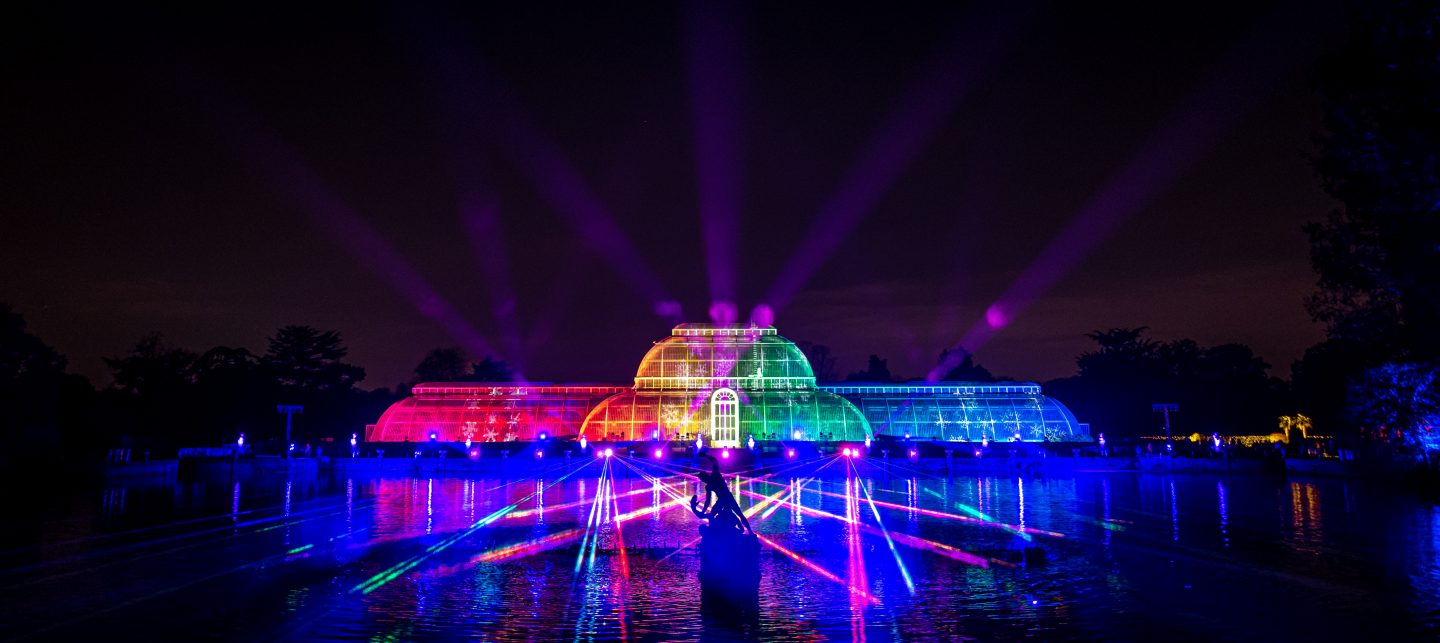
NOTE: Visitors should be aware that some areas may be closed during extreme weather conditions so always check before planning your visit!
#4: Where to Eat at Kew Gardens?
Kew Gardens offers a wide range of dining options to suit all tastes and budgets. Whether you’re looking for a quick snack or a more extravagant dining experience, you’ll find plenty of options to choose from on your day trip to Kew Gardens:
- The Botanical Brasserie: This is Kew Garden’s flagship restaurant located in a magnificent Grade 2 listed building overlooking the pond and Palm House. It offers a quintessentially British dining experience featuring delicious seasonal dishes made with locally sourced ingredients, as well as traditional afternoon tea.
- The Orangery: Set in a stunning 18th-century building, The Orangery offers light bites and delicious cakes in elegant surroundings. [*Closed for refurbishment until late Spring 2023.]
- Pavilion Bar and Grill: For a more relaxed dining experience, the Pavilion is an excellent choice. Situated in a picturesque spot overlooking the lake, this bar and grill offer a range of delicious barbecue dishes and refreshments.
- Victoria Plaza Café: If you’re looking for a quick bite, the Victoria Plaza Café is the perfect spot. Located in a peaceful area of the park, this charming cafe offers a selection of sandwiches, cakes, and drinks that you can enjoy indoors or outdoors.
- Family Kitchen & Shop: From stone-baked pizzas and hearty salads to freshly prepared sandwiches, mouthwatering dishes from the hot counter and delicious ice cream served up by an expert team of chefs, this is the perfect hangout for the whole family.

Additional Information & Insider Tips
Accessibility at kew gardens.
Kew Gardens is proud to be welcoming and accessible to all visitors. Whether you are an individual with hidden impairments or a group visiting with a disability, the team at Kew Gardens will do their best to ensure your visit is as enjoyable as possible.
Their accessible facilities include ramped access points, wheelchair hire and a complimentary wheelchair assistant service, specialised tours and activities, and dedicated changing places.
For further information on accessibility ahead of your day trip to Kew Gardens, you can refer to their website .
Kew Gardens Membership
Becoming a Kew Gardens Member allows you to enjoy exclusive access to their world-renowned botanic gardens all year round. With the membership, you will not only get unlimited entry to Kew, but you will also benefit from discounts at Kew shops, cafes and events, be eligible for priority booking on special events throughout the year, receive complimentary admission to Kew’s partner gardens across the UK, and help support the vital research that takes place at Kew.
As a Kew Gardens Member, I especially enjoy having the freedom to enter the gardens whenever I feel like taking a relaxing walk. As part of our Family Membership (two adults) , we are also able to bring one family guest each, plus up to four children (aged 4 to 15) – making it perfect for days out with family and friends. With unlimited free entry to both Kew Gardens and Wakehurst , discounts in shops and cafes and priority booking on special events throughout the year, membership is definitely worth the investment for anyone who plans to visit the gardens more than once a year!
Little Known Facts About Kew Gardens
- At the world-renowned Royal Kew Gardens lies a remarkable specimen, the oldest pot plant in the world . Collected in 1775 by Frances Masson during one of Captain Cook’s voyages from South Africa, this Jurassic cycad (Encephalartos altensteinii) is kept safe inside Kew’s Palm House.
- The Gardens are home to the smallest royal palace in the country; the Grade I-listed Kew Palace.
- The paddock next to Queen Charlotte’s Cottage was home to a menagerie of exotic animals from 1792. This included colourful Tartarian pheasants and the very first kangaroos to arrive in Britain .
- Two planes have crash-landed in the Gardens throughout its history . In 1928, a single-seater Siskin aircraft came down near Syon Vista but the pilot managed to escape unharmed with the help of his parachute. Another crash happened in 1938; an aircraft pulling an advertising banner had to make an emergency landing near the Palm House but there were no casualties.
- Kew Gardens has its own Police Force , and at some point also had its own Kew Fire Brigade (now covered by Richmond Fire Brigade).
- Day trip to Kew Gardens left you asking for more? Well, lucky for you, you can actually hold corporate and private events, or even get married at Kew !
Insider Tips
- Prefer your meals more al fresco ? No problem — You can pick up some food and drinks from Gail’s, Tesco, Starbucks, or The Good Wine Shop Kew by the Kew Gardens tube station, and have a picnic in any green space you fancy. Don’t forget to bring your picnic blanket!
- Limited in terms of mobility, or simply prefer being given a lay of the land beforehand? Then, you may want to jump on the Kew Explorer land train that takes visitors on a guided tour of Royal Kew Gardens.
- Waterlily House , one of the most beautiful spots in the Kew Gardens in my opinion, is closed every winter due to reduced natural light levels and cold temperatures making it too challenging to cultivate tropical water lilies. So if you want to marvel at these delicate flowers floating atop lily pads, you will need to visit in the summertime.

FAQs | Visiting Kew Gardens
Why visit kew gardens.
Kew Gardens is home to an impressive array of plants and trees, many of which are rare or endangered. It is also one of the world’s leading botanical research facilities and holds more than 8 million specimens from around the globe. The gardens contain a wealth of historical buildings and structures such as greenhouses, pagodas, treehouses and water features that create an idyllic atmosphere for visitors.
How Long Does It Take to Walk Around Kew Gardens?
It takes around 2-3 hours to walk around the Kew Gardens, that is of course with a minimal amount of stops. I would recommend spending at least four hours exploring the Kew Gardens. There is plenty to do and see, so you will have lots of opportunities to take in the stunning scenery while you walk around. You can even bring a picnic or grab lunch from one of the eateries located throughout the grounds. A bit of extra time spent here (and ideally turning it into a day trip to Kew Gardens) will give you a chance to really enjoy your day!
How Long to Spend at Kew Gardens?
It depends on your interests, but a visit to Kew Gardens can last anywhere from two hours to a whole day. Generally, visitors should spend at least 3-4 hours exploring Kew Gardens.
Can You Take Dogs to Kew Gardens?
Unfortunately, the gardens are not pet-friendly. Only registered disability assistance dogs are allowed in the gardens.
How Much Are the Tickets to Visit the Kew Gardens?
Ticket prices depend on the ticket type and the time of visit. For detailed information, you can visit this page which has the latest information.
Is Kew Gardens Free to National Trust Members?
If you are a member of the National Trust, please note that Kew Gardens is not included in your membership and requires an additional general admission fee.
When Do the Kew Gardens Open?
Kew Gardens’ opening hours vary depending on seasonality or events, however generally they open between 10 am-5 pm daily (last entry: 4 pm), and longer during summertime.
Is There a Gift Shop at Kew Gardens?
Yes, there are 4 gift shops in Kew Gardens: Victoria Plaza Shop (the biggest), Pavilion Shop , Galleries Gift Shop and Family Kitchen & Shop .
Final Thoughts: Day Trip To Kew Gardens
With its stunning landscapes, diverse plant life, historic charm and endless opportunities for exploration, there’s no wonder why Kew Gardens continues to attract tourists all year round!
Whether you’re visiting London or just looking for a peaceful escape from everyday life — a day trip to Kew Gardens won’t disappoint! So why not plan your next visit today and experience firsthand how this royal botanical garden brings centuries-old history alive with its beautiful gardens and captivating sights awaiting discovery?
Looking for more London tips and recommendations? Check out these posts:
- For all your foodie’s wishes: London Restaurants
- Visiting around Christmas? Then you may want to check out the best things to do & see in London at Christmas .
LIKE THIS POST? WHY NOT SHARE IT WITH SOMEONE WHO WOULD LOVE A KEW GARDENS DAY TRIP?

Welcome to my little corner for all things London, travel, food and wine! Why not join me on Instagram where you can follow my travel- and food-capades in real-time? Or leave a comment/send a message? I would love to hear from you! Lots of love, GG
Let's be travel friends!

Popular Posts
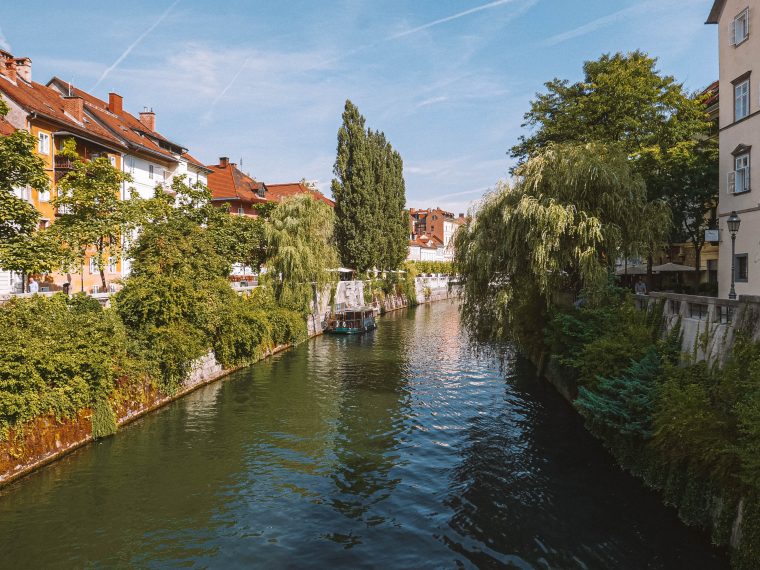
Living Life In The “SLO” Lane: The Ultimate Ljubljana Guide
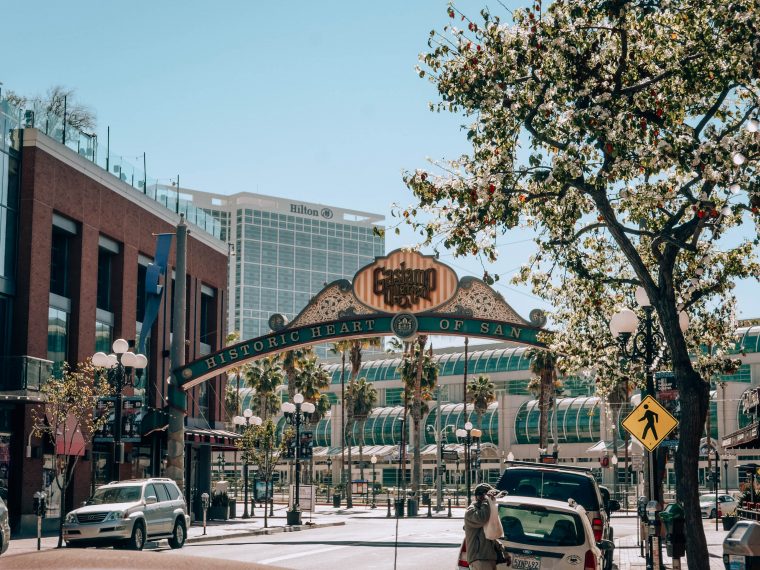
Solo Trip to San Diego: Best Things To Do Alone [+ Day Trips and FAQs]
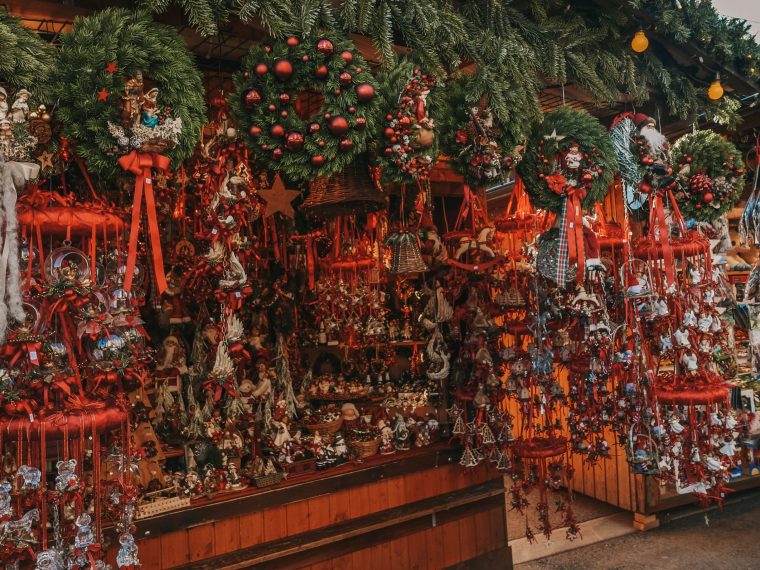
Christmas in Vienna: The Ultimate Guide
Related posts.

A Quick Guide to 7 Best Slovenia Highlights: Ljubljana & Beyond

Visit Ptuj: Slovenia’s Timeless Treasure and Oldest Town is Calling You!

13 Insider Tips to Experience Istanbul Like a Local
Leave a comment.
OMG! I had no clue Kew Gardens is so big. I went years ago and don’t remember it being that big, haha. I definitely need to visit again.
Oh, it is huge and yes, definitely well worth another visit – especially now when everything is in bloom or in summertime when they will start hosting a number of events!
- Shop My Faves
- Privacy Policy
Let's stay in touch!
Subscribe to GG Newsletter for e-mail updates and exclusive stories.
You can unsubscribe anytime. For more details, please review the Privacy Policy.
Welcome to the club!
Hey there, I am so glad that you chose to join me on this journey!
Your welcome e-mail is on its way (Can't find it? Please check your spam folder as they can sometimes be mislabeled) . To make sure your GoyaGaleotta.com e-mails are delivered, please add [email protected] to your e-mail contacts.
Lots of love,
What are you searching for?

How to reach, timings, and tips to visit Kew Gardens London
Things to do in London London Attractions Landmarks in London Kew Gardens London
Fancy a treetop view encompassing birds, insects, fungi and lichen amidst the branches? Wonder how does it feel to be inside a real beehive? Well, the Kew Gardens offers you this and more botanical wonders inside. In 300 acres, the natural haven offers galleries of botanical art, glasshouses, various gardens, eateries and more.
Kew Gardens London
Located in the Kew district of the London Borough of Richmond upon Thames in southwest London, the Royal Botanic Gardens, is the largest UNESCO World Heritage site in London. Also known as Kew Gardens, it is also the largest botanical collection in the world.
Featuring 18th to 20th century landscaping techniques and elements, the Kew Gardens house the most diverse botanical and mycological collections in the world, representing nearly 95% of the vascular plants and 60% of the fungi.
The Kew Gardens is a leading conservation and scientific lab, and home to plant scientists who study more about plant diversity.
Kew Gardens - In a Nutshell
Kew gardens - things to know, kew gardens opening hours.
Weekdays: 10am - 7pm with the last entry at 6pm. Weekends: 10am - 8pm with the last entry at 7pm.
Must-see at Kew Gardens
Queen Charlotte's Cottage The Temperate Glasshouse Pagoda Xstrata Treetop Walkway
Kew Gardens Address
Royal Botanic Gardens, Kew Road, Richmond, London TW9 3AB, United Kingdom. Get there
Which Kew Gardens tickets should you buy?
Depending on whether you're a history lover, nature enthusiast or architecture admirer, your itinerary may vary. Hence it is important to plan ahead, skip the lines and book the best experience.
You may choose to book one of Headout's pre-planned tours , crafted combining the best experiences including the Kew Gardens in a package or book your Kew Garden tickets individually on the Headout app for just €11.

- Stop to smell the roses, away from the bustling city, at London's serene Kew Botanical Gardens.
- Wander through the wide stretches of lush green gardens and feel at peace.
- Featuring a host of conservatories, art galleries, and restaurants, there's plenty for you to engage yourself with.
- Discover the 120 hectares of gardens, the plethora of plants and trees from varying biomes.
- Explore the 2 upcoming exhibitions this year, the Secret World of Plants & Japan.
- All visitors to Kew Gardens aged 16 and over are requested to check-in using the NHS COVID-19 app upon arrival.
- Choose between standard and advanced booking options.
- The advanced option lets you book tickets up to 48 hours before your visit date.
Why visit Kew Gardens?
- With many galleries and natural retreats inside, Kew Gardens has a lot to vouch for.
- The rare and extinct species residing in the Kew Gardens are a wonder to look at and can exclusively only be found here. The Library inside contains 750,000 volumes and illustrations and is great way to learn about the plant families, their evolution and conservation.
- All the structures found inside have historical significance, and the tales behind them are fascinating. From chinoiserie to glass structures, the buildings are also architecturally diverse in nature.
- While he colourful blooms are a visual treat, the gardens can be the calm to the chaos of the outside world, and is a great way to connect back to nature.
In short, Kew gardens is the best bet if your looking for an educating and entertaining trip, in the cocoon of nature.
Plan your visit
Best time to visit the kew gardens.
Spring (April to May) is when the garden start showing signs of new blooms and starts displaying its eye-catching flora collections. Summer (June to August) is the time when the flowers and deciduous trees are in its best form.
Autumn , though not the best season to see the flowers, the crowds are lesser, and you get to experience the changing seasons. Even though the garden thrives inside the greenhouse, it is suggested to skip the visit in Winter .
It’s worth checking the website to find out what each season has to offer in detail.
Kew Gardens Opening hours
Kew Gardens open every day except for the 24th and 25th December .
On weekdays they are open from 10am - 7pm with last entry at 6pm.
On weekends they are open from 10am - 8pm with last entry at 7pm.
From 1 May to 30 September 2022, they do early openings for members at 8am.
The closing time may vary depending on seasons (due to the shorter days).
Getting to Kew gardens
- 65 (stops near to Lion, Elizabeth, and Victoria Gate)
- 110 (stops near to Kew Gardens station and Elizabeth Gate)
- 237 and 267 (stops at the Kew Bridge station)
By Tube Just a 15-minute walk away, the nearest station is Kew Gardens station (in Zone 3) which is located just 500m from the Victoria Gate.
By Train The closest station is the Kew Bridge Station, which is 800m from the Elizabeth Gate entrance.

All About Kew Garden Entrances
History behind the gardens.
Tracing its origins to the 18th century, the Kew Gardens were different estates belonging to the members of the Royal Family. It was Princess Augusta who created the first botanical garden with the assistance of Lord Bute and architect Sir William Chamber. King George III joined his estates of Richmond and Kew in the year 1802, and with the assistance of William Aiton and Sir Joseph Banks he started working on the landscape of the estates.
When the ownership of Kew Gardens was transferred from the Crown to the Government in the year 1840 due to negligence for years, it was renamed and taken in as the national botanical gardens and then expanded to start the Kew Gardens under its director William Hooker and its first curator John Smith.
Now the Kew Gardens are home to the Palm House which is ‘the world's most important Victorian glass and iron structure’, the Temperate House which is ‘the largest Victorian glasshouse’ in existence, and many more attractions created over the years.
The Kew Gardens were officially recognised among the World Heritage Sites in the year 2003.
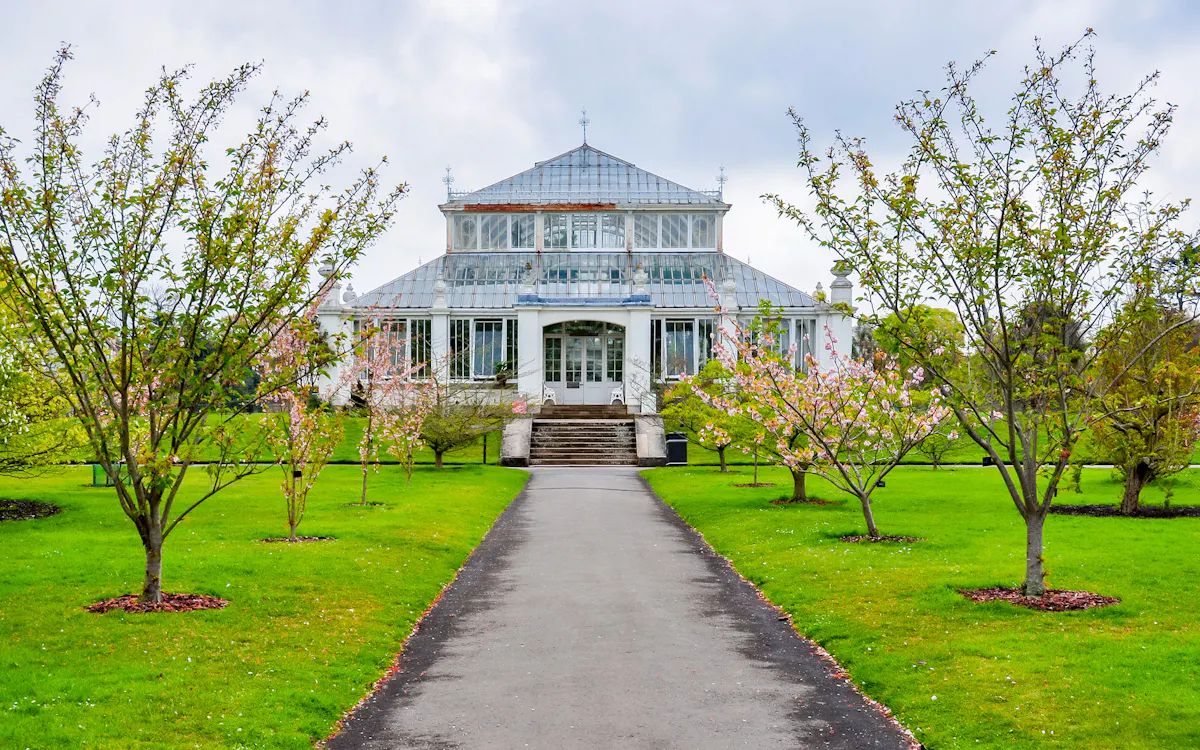
Top things to see at Kew Gardens
1 queen charlotte's cottage.
The 17th century cottage was a rustic retreat for the royal family to rest, drink tea or have picnics while visiting the gardens. The paddock adjacent to the cottage once housed many exotic animals including the first kangaroos to arrive in the country, now extinct quagga, a pair of black swans, and buffaloes. You can see the Queen’s own collection of Hogarth prints in the print room downstairs or view Princess Elizabeth’s, the Queen’s daughter’s floral and bamboo artwork in the tearoom.
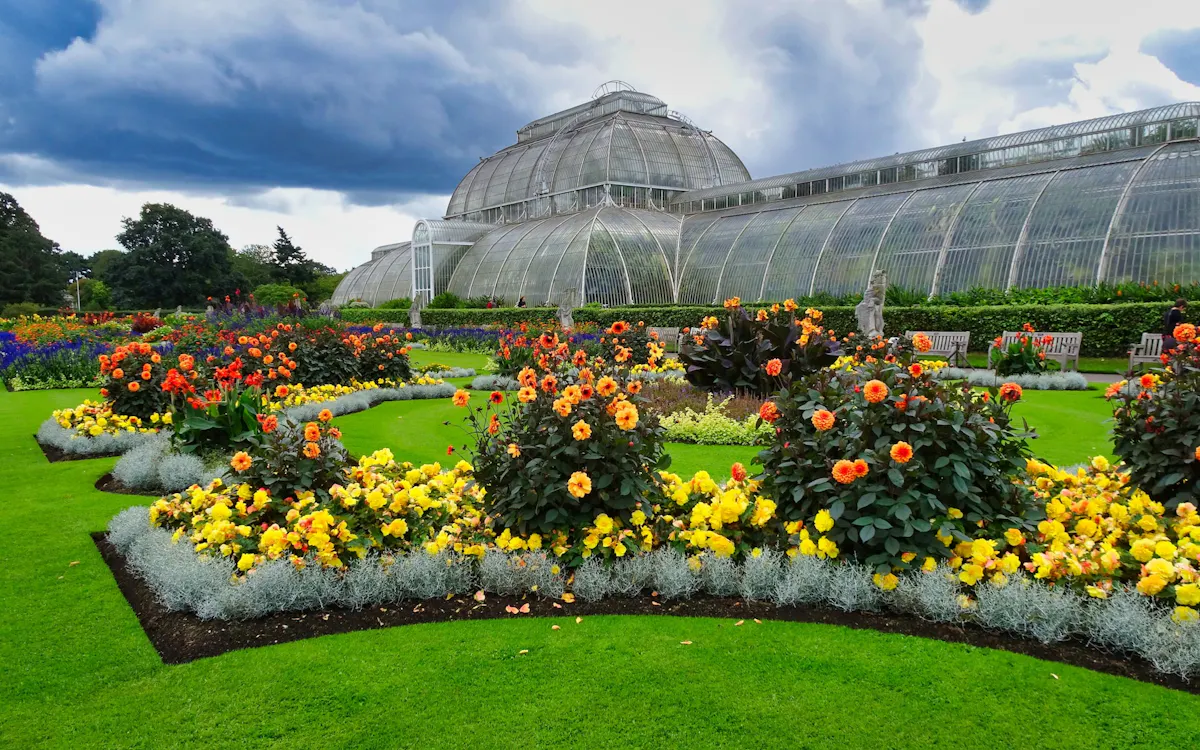
2 The Temperate Glasshouse
The glasshouse is home to the world’s rarest and most threatened temperate plants, including 6 species that are extinct and in the red list. The world’s largest surviving Victorian glasshouse covers a massive 4,880 square metres and its tallest peak is at 19 metres high.

With Chinese Chippendale railings and curved roofs, the chinoiserie building was entirely designed by the Swedish-Scottish architect Sir William Chambers. Built in the 18th century, it was a gift to Princess Augusta, who had employed him to construct many features in the garden. Offering the earliest and one of the best bird’s eye views of London, the Pagoda also holds exhibits on the building’s history.
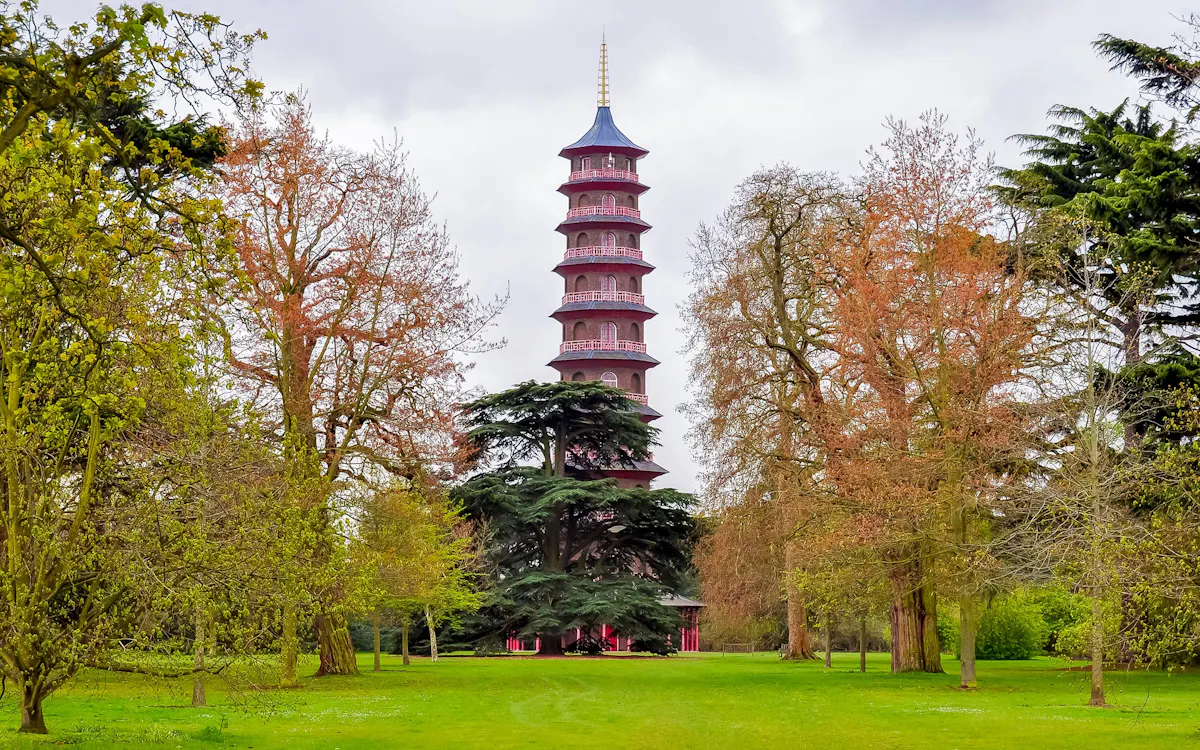
4 Xstrata Treetop Walkway
Offering a magnificent bird’s eye view of forest canopy, the walkway is one of Kew Garden’s most popular attractions, especially to those who love a kick of adrenaline. Standing 18 metres tall and 200 metres long, the walkway is designed to slightly sway in the wind to give a more immersive experience through the foliage.
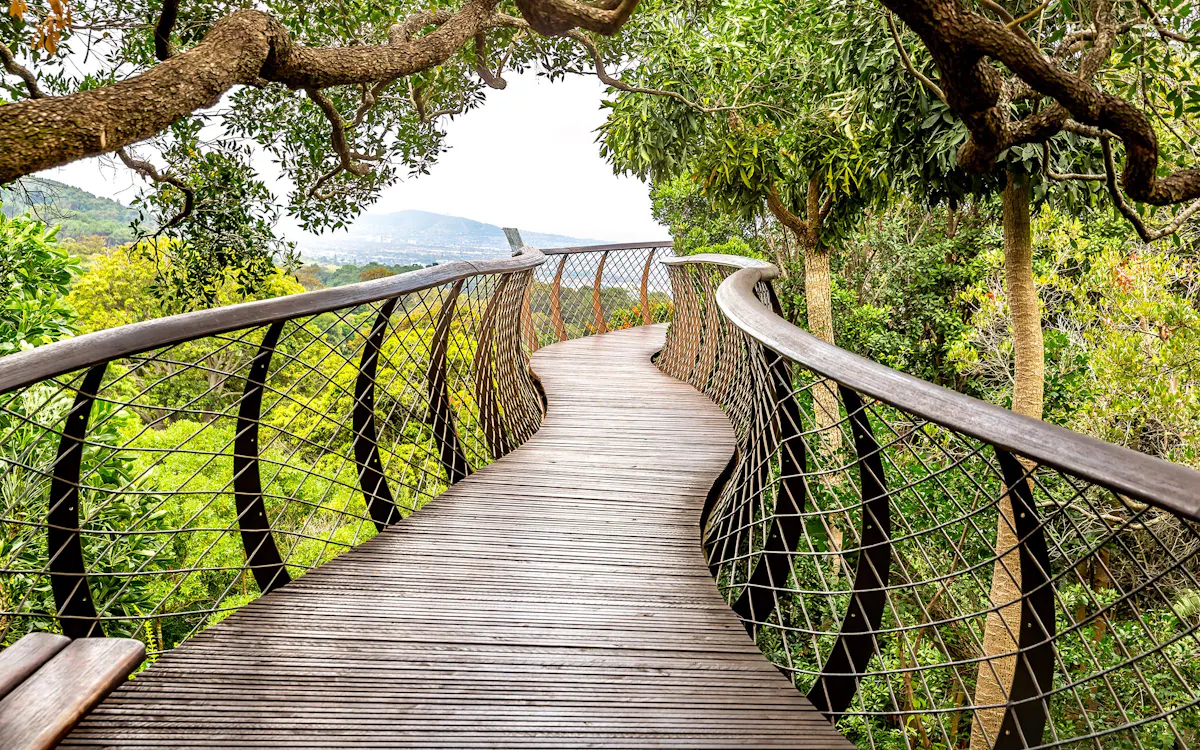
5 Palm House
Home to an exquisite collection of endangered and extinct plants including the cocoa tree or the African oil palm, you get to experience a slice of rainforest in the Palm House. Constructed in 1844, the greenhouse resembles an upturned hull of a ship as the architects borrowed ideas from the ship building industry to construct it. The humid environment inside creates the perfect environment for the lush plants and is home to the oldest pot plant in the world (more than 250 years).
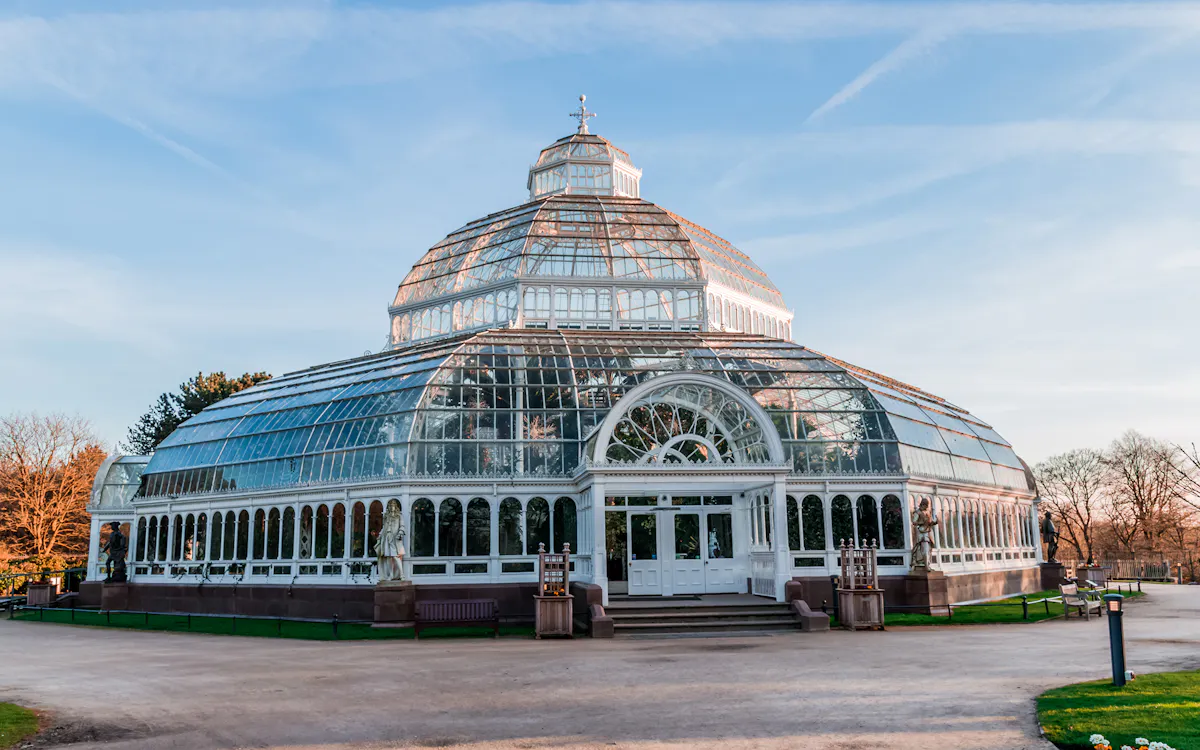
The mesmerising geometric installation, standing tall at a towering 17 metres tall, features an immersive visual and auditory experience recreating the life inside a beehive. With 1,000 LED lights that glow according to vibrations of bee and 170,000 aluminium parts, the structure mimics the real visual effects of an actual beehive in Kew Gardens. A calming and serenading symphony of vocals and cello, all in the key of C is played to create a soundscape inspired by the hum of the bees (Scientists discovered bees buzz in the key of C).
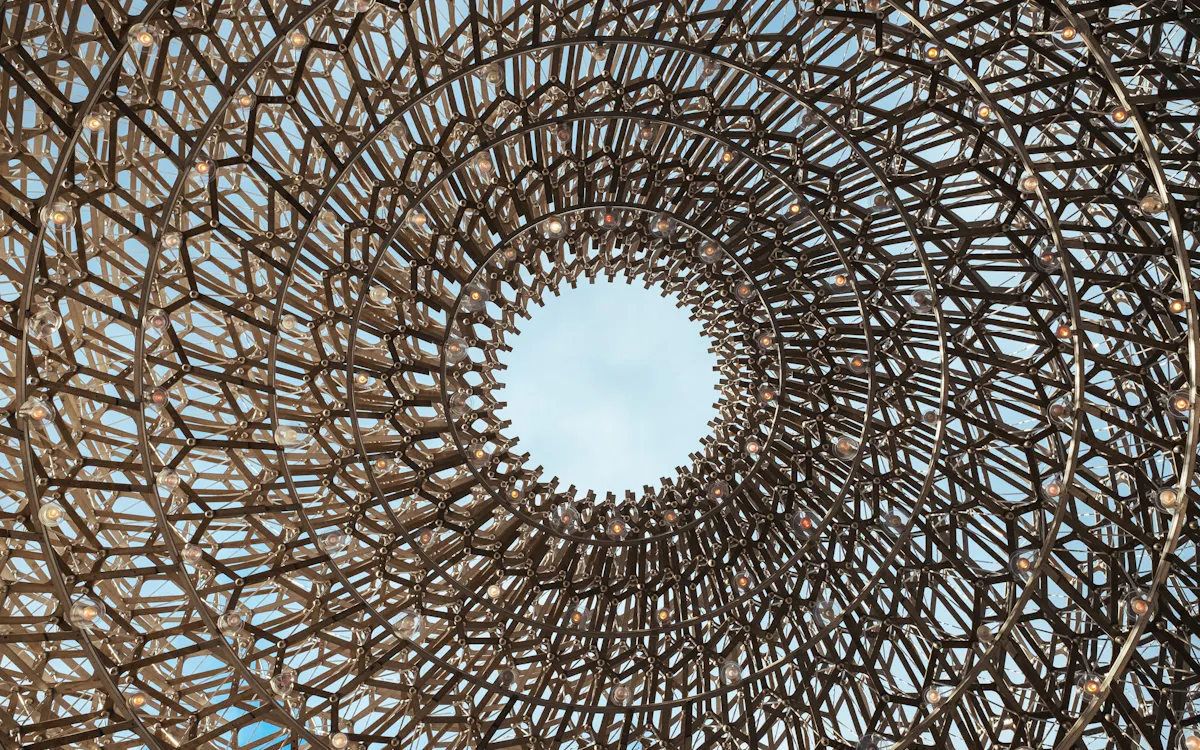
7 Kew Palace
Known as the smallest palace in the whole country, it was originally built in 1631 for Samuel Fortrey a silk merchant. The Dutch house is one of the few surviving structures in the Kew Palace complex, along with the former brewhouse, housekeeper's cottage, and kitchen. Except for the kitchen, all the structures are open for public. In the 1720s, George II and Queen Caroline lived there. Later the palace became a refuge for George III when he was experiencing mental illnesses and Queen Charlotte who was taken in ill and passed away in the palace. Reflecting the intimate life of the royal families, the palace is a tale in itself.

8 Waterlily House
Featuring a circular pond spanning over 10 meters, the Waterlily house is the most iconic and second oldest of Kew Garden’s glasshouses. This glasshouse was specifically made to breed the giant Amazon waterlily (Victoria amazonica). The pond is also home to the Santa Cruz waterlilies (Victoria cruziana) known for its floating large lily pads which can grow up to 2 meters in size. In summer, you will be able to spot lotus, papyrus and more.
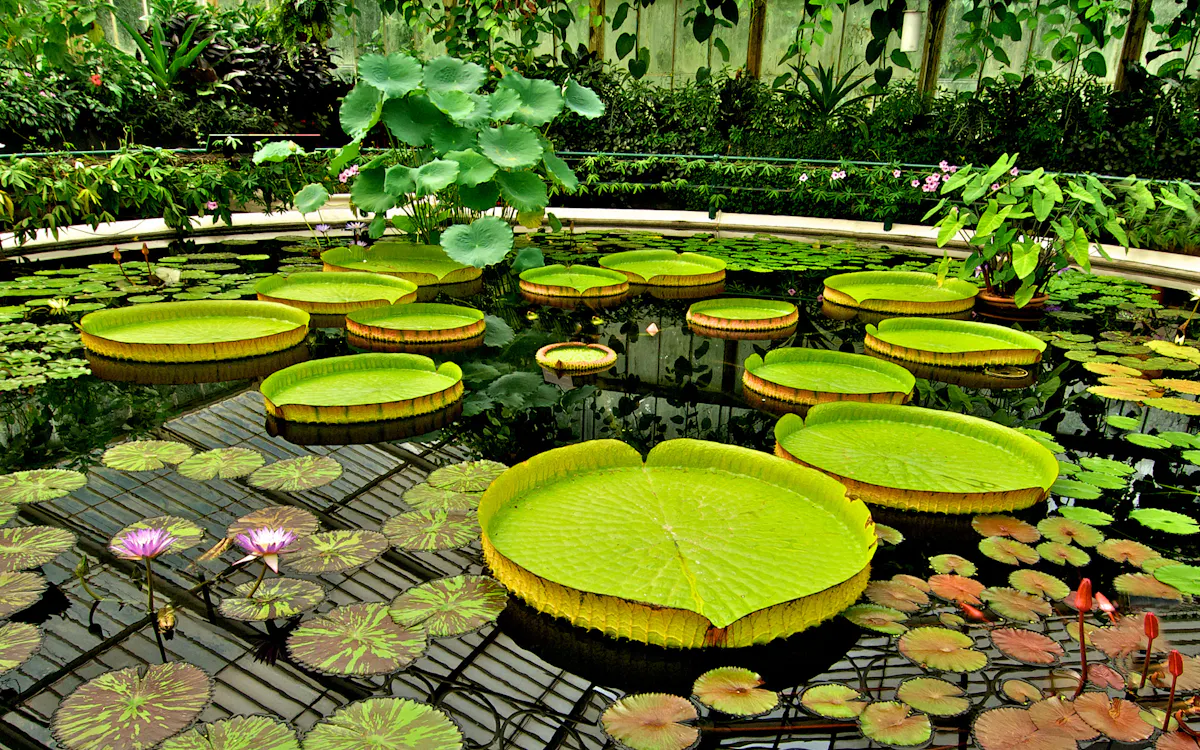
9 Davies Alpine House
Housing the Alpines, usually found in the mountaintops or the earth’s poles, these plants grow in extreme cold. The Davies Alpine House was designed to recreate these same extreme conditions, using two back-to-back arches to draw warm air out of the building. The glasshouse is known for its sustainable structure and energy efficient environment created using biomimicry techniques, inspired by the passive cooling found in termite mounds.
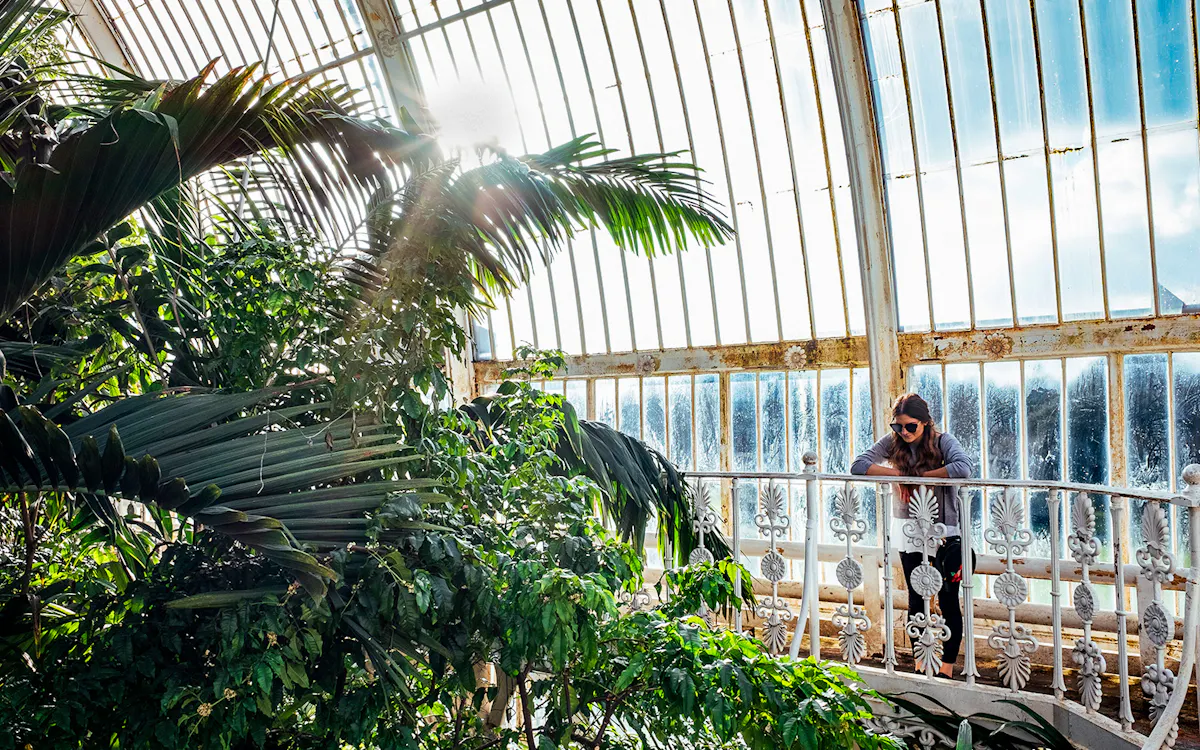
10 The Princess of Wales Conservatory
Opened in 1987 by Princess Diana, the conservatory boasts of 10 different climatic zones, taking you through a series of captivating ecosystems. Spanning over 4500 meters, the conservatory has recreated computer-controlled tropical rainforests to arid deserts in the glass structure. From Venus flytraps to bright bromeliads, the conservatory is home to all types of plant species.

Map of Kew Gardens
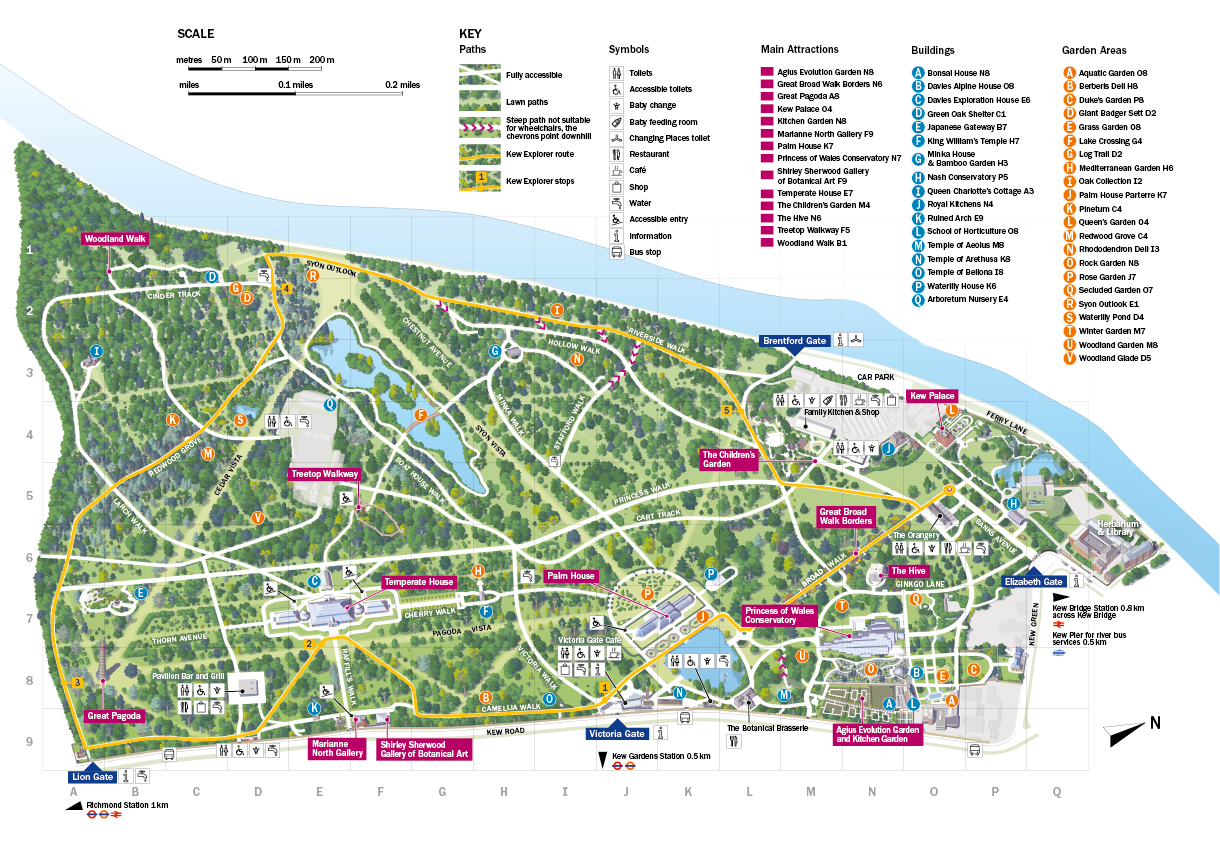
Facts you probably didn't know about Kew Gardens
- Kew Gardens contain a part of old London Bridge. The four granite blocks placed of the banks of the lake near the Sackler Crossing were once part of the 19th century bridge.
- The loneliest plant in the world, the Encephalartos woodii resides in the Kew Gardens. Found all alone in the Ngoya Forest in southern Africa by the botanist John Medley Wood, the tree was once munched by dinosaurs.
- The Kew Gardens are the most biodiverse place in the entire planet earth owing to its diverse collection of flora.
- Initially designed as a temporary exhibit for the UK Pavilion at the 2015 Milan Expo, the Hive found its final home in the Kew Gardens.
Best recommended tours to the Kew Gardens
Below are the tickets and tours to the Kew Gardens via the Headout app, for a seamless and stress-free booking experience.
Restaurants in Kew Gardens
Here are the top three places to eat at inside the Gardens.

Sporting the Charlie and the Chocolate Factory meets botanical lab looks, this restaurant is meant to make visitors feel as if they have shrunk into tiny creatures beside the fungi sculptures and giant apple seats. The whimsical restaurant offers stone baked pizza (customisable), salad bar, artisan sandwich station, ice cream booth and more. It is a fun place to hang out with kids and a definite visit for design junkies and sustainable interior enthusiasts.

Giving a sleek and modern feel, the steel frame along with the outdoor seating located amid the Arboretum, a unique landscape of 14,000 trees gives a calming picnic-in-the-trees vibe. The mid-range eatery features pork belly ribs, spatchcock chicken and vegan patties, all infused with the herbs from the Kew Garden itself. Though not cheap, they do offer a children’s menu and a family sharing platter. Find on Map >
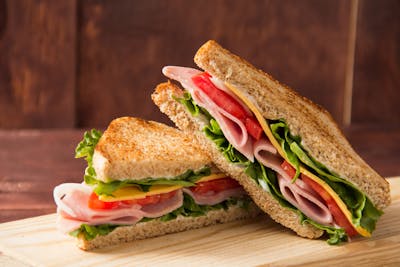
The 18th-century building is sure to captivate you with its high ceilings and arched windows, along with the view from the terrace. The restaurant offers pastries, selection of sandwiches, freshly squeezed juices and more. Built in 1761 by architect Sir William Chambers, the teahouse is perfect for the British afternoon tea experience.
Accessibility at Kew Gardens
- Kew Gardens are susceptible to overhead noise due to its proximity to the Heathrow Airport flight path. Those with sensory disorders, noise sensitivity, etc would be advised to carry earplugs or headphones to avoid disturbances.
- 8 disabled car parks are available near the Brentford Gate, and 2 to the right of the Elizabeth Gate.
- There are unisex accessible toilets in all the washrooms.
- Brentford and Victoria Gates offer mobility scooters for hire, but they should be booked in advance.
- Only the Temperate House and Alpine House are the glassdoors accessible via wheelchairs/mobility scooters.The Princess of Wales Conservatory is partially accessible to wheelchairs during the Orchids festival.
- Kew Palace is accessible for wheelchair users, however small wheelchairs are required due the narrow paths inside.
- Though most of Kew Garden’s landscape is accessible via ramps, the following areas are not accessible with buggies - Queen Charlotte's Cottage, The Waterlily House, Xstrata Treetop Walkway, Galleries in both the Temperate House and the Palm House, The Waterlily House, The Aquatic Display in the Palm House , Queen Charlotte's Cottage, Kew Palace.
Good to know before visiting Kew Gardens
- Unless accompanied by an adult, children under the age of 16 are not permitted inside.
- Only adults with children are allowed inside the Children’s Garden(with a valid ticket).
- Visitors with disability can get a concession ticket.
- Carers accompanying visitors with a disability, such as registered blind and partially-sighted visitors can get in for free.
- Guide or assistance dogs (including those in training) can enter. Though make sure to have a lead or harness to identify them.
Insider tips
- Wear airy clothing, preferably a removable jacket as it can get really warm in the greenhouse.
- Wear comfortable footwear, as the walks around can be long.
- Do not forget to carry a good quality phone camera or your camera equipment with an empty memory card or those with lots of space to click enough pictures, and you do not want to miss on it.
- Do not hold yourselves back from spending the whole day there, in fact it is highly recommended.
- Though there are enough eateries around, don’t skip carrying snacks for your toddlers (and yourself) to munch on as the long walk inside may be tiring after a while (Food and drinks should not be taken inside the galleries).
- Some of the best picnic spots inside the Kew Gardens are - Next to the River Thames (marked as a viewpoint on the map), near the Waterlily Pond and in front of Queen Charlotte's Cottage.
Amal Karadi
Amal has always been fascinated by people, culture, and languages. She hopes to one day become a polyglot, and travel the world in order to learn as much as she can about different cultures along the way. Amal enjoys exploring museums and trying out new things.
Be a smart traveler
The first to know about trending destinations, travel deals, tips and all things travel.
- Skip to primary navigation
- Skip to main content
- Skip to primary sidebar
- Skip to footer
TravelAwaits
Our mission is to serve the 50+ traveler who's ready to cross a few items off their bucket list.
8 Must-See Things At London’s Kew Gardens

elRoce / Shutterstock
- Activities and Interests
- Architecture
- Destinations
- History and Culture
- Outdoor Activities
- Sightseeing
- United Kingdom
The Royal Botanic Gardens, Kew, known simply as Kew Gardens , is located in Richmond, a suburban town in southwestern London. The garden, a UNESCO World Heritage site , dates to the 18th century, when it was established on the grounds of a royal palace.
Today, the garden is a globally renowned scientific institution for plant and fungal research. The original 9-acre area has expanded to include 300 acres containing more than 50,000 living plants. With its Victorian glasshouses, arboretum, and artwork, there is a lot to see.
Here are eight of the garden’s attractions that no visitor should miss.

Jeff Eden / RBG Kew
1. The Great Pagoda
The Great Pagoda was completed in 1762 as a gift for Princess Augusta, who founded Kew Gardens. When it was constructed, 80 dragons carved from gilded wood adorned the roofs of its 10 floors. The dragons were removed in 1784. There were rumors that they were sold to pay King George IV’s gambling debts, but it is more likely that they simply rotted over time. The Great Pagoda was restored in 2018, and the dragons are back . Eight of the first-floor dragons were produced in the traditional manner and hand-painted. The remaining 72 were 3-D printed in a robust polyimide material.
A circular staircase inside the pagoda allows visitors to climb to the top for spectacular views. There are a limited number of spaces available per time slot, and if you wish to climb the pagoda, you must pay an additional fee. There are 253 steps to the top.
If you choose not to climb to the top, you can look through the small room at the base of the pagoda at no additional cost. Here you’ll find information about the pagoda and its architect, Sir William Chambers. You’ll also find two automata . One shows the architect visiting Canton, China, where he studied pagodas. The other shows the royal family strolling through Kew Gardens. Handwheels at the bases of the automata allow you to control the moving parts.

2. The Japanese Landscape
Three garden areas make up the Japanese Landscape . The Garden of Peace, an area reminiscent of a traditional Japanese tea garden, features stone lanterns and a dripping water basin. Raked gravel and large rocks in the sloped Garden of Activity represent the movement of flowing water. The Garden of Harmony unites the two. All three combine to create a peaceful, manicured oasis.
At the center of the Japanese Landscape is the Chokushi-Mon, or Gateway of the Imperial Messenger. It was created for the Japan-British Exhibition of 1910 and is a replica of the Gate of Nishi Hongan-ji (Western Temple of the Original Vow) in Kyoto, Japan. Its finely carved wooden panels feature stylized flowers and animals that depict an ancient legend.

Gareth Gardner / RBG Kew
3. The Temperate House
The Temperate House , originally opened in 1863, is the world’s largest Victorian glasshouse. It has been an iconic landmark of Kew for more than 250 years. The Temperate House reopened in 2018 after a five-year renovation project. Filled with 10,000 individual plants, it is home to 1,500 species from Africa, Australia, New Zealand, the Americas, Asia, and the Pacific Islands, including some of the world’s rarest and most threatened temperate plants. All of the species require conditions above 50 degrees to survive.
Level pathways wind throughout the ground floor, and a balcony around the interior perimeter offers views from above. Note that the balcony is not wheelchair accessible.

4. The Treetop Walkway
You’ll find 14,000 trees in Kew Gardens. The Treetop Walkway provides an opportunity to get closer to those trees and offers views of the garden and the city beyond. Made of weathered steel that blends into the natural environment, the walkway stands 59 feet tall. It is 656 feet long and loops through the upper branches of beech, sweet chestnut, horse chestnut, and oak trees. The walkway offers a unique, ethereal perspective of nature. You’ll love watching bird and insect behavior at this height and hearing the breeze rustling the branches.
The 188 steps to the walkway are a manageable climb, since the steps are broken up into several flights and there’s a landing at the end of each flight. There is room on each landing to step out of the path of oncoming climbers to rest or simply take a few moments to admire the view. The walkway itself has chest-high railings, and several circular jut-outs along the way provide additional viewpoints. There is an elevator, but it was out of service on the day I visited. If you plan to use the elevator, check the Kew Gardens website for information about the elevator’s status. As I write this, the site says that the elevator is currently out of service.
There is no additional charge to access the Treetop Walkway. It closes an hour before the whole garden closes.

5. The Palm House
You can explore an indoor rainforest at the garden’s Palm House . The Palm House, which opened in 1848, was the first glasshouse to be built at Kew Gardens. Inside, you’ll find lush vegetation and dense, moist air. Many of the plants in the collection are endangered in the wild, and some are even extinct. Rainforest plants cover only 2 percent of the world’s surface but make up 50 percent of plant species. Look for the Madagascar periwinkle, now used to treat a number of different types of cancer; the rubber tree; the cocoa tree; and the cycads, or palm-like plants that were widespread more than 250 million years ago.

6. The Marianne North Gallery
With all there is to see at Kew Gardens, you might easily miss the attractive red brick building housing the Marianne North Gallery . But don’t hesitate to take a look inside — the exquisite interior, which incorporates different kinds of wood and stenciled floor tile, is home to more than 800 works of botanical art.
Marianne North was a wealthy, single Victorian woman who traveled the world solo in pursuit of interesting plants to paint. She was unconventional and ventured to some of the most remote places in the world. After 13 years of travel, she decided that she wanted to exhibit her vivid, detailed paintings in Kew Gardens, where her passion for plants began. She offered to build the gallery if Kew would display her work in it. The gallery was constructed in 1882, and a restoration of the building was completed in 2008.

7. The Princess Of Wales Conservatory
The Princess of Wales Conservatory is the newest glasshouse at Kew Gardens. It opened in 1987, and its 10 computer-controlled climate zones showcase a variety of ecosystems. In the carnivorous plant zone, you’ll find predatory plants such as Venus flytraps and pitcher plants. There are cacti and succulents in the dry tropical zone, orchids and bromeliads in the steamy zones, and a giant water lily in the wet tropical zone.

8. The Hive
The Hive , one of the most photographed spots in Kew Gardens, is an art installation located in the heart of a wildflower meadow. The 55-foot-tall structure depicts life inside a beehive. The mesh frame is constructed from 170,000 aluminum parts and 1,000 LED lights. The LED lights glow according to the vibrations of bees in the garden. You’ll hear the whirring of bees when you walk inside, as well as background music composed by musicians who improvised to a live feed of beehive sounds in the key of C.
There is something to see in every corner of Kew Gardens. Keep your eyes open as you walk from attraction to attraction. You’ll pass colorful border plantings, various styles of gardens, peaceful and majestic wooded areas, ornamental structures, and assorted garden art.
On the website , you’ll find more information on these and other attractions, as well as the park’s hours and fees. Note that the glasshouses close an hour before the garden closes.
London bound? Don’t miss these 10 free museums in the city . And when you’re ready for a break from the hustle and bustle, consider one of these eight amazing day trips from London .

Donna Janke is a writer based in Canada out of Winnipeg, Manitoba. She shares her travel discoveries on her blog, Destinations Detours and Dreams , using a combination of narrative, photography, and personal reflection, all with an eye for detail. Her interest in travel started as a child when books transported her around the world, and grew as she explored the world in person. Her life as a travel writer began after she retired from a professional career in IT. Donna loves discovering the unique character of places, near and far, and writing to inspire others in their travels. Her travel stories have been published in several outlets, and tend to focus on culture, history, nature, art, architecture, and food.

Kew Gardens Guide: Tree Top Walkway, the Hive & Cherry Blossoms
What was at the top of my list while visiting London? No, it wasn’t to see the Big Ben or to sit atop the London Eye. I was determined to see enchanting fields of cherry blossoms and cacti-filled conservatories.
Tucked outside of London’s city center, the Kew Gardens are an oasis of blooming flowers, exotic foliage, and fresh air. This UNESCO heritage is where beauty meets a longstanding commitment to conservation and climate action.
Safeguarded by locals and overlooked by masses of tourists, there’s no doubt that The Kew is London’s best-kept secret (garden).
Kew Garden Attractions

Though the park is located 9 kilometers outside of London, a short tube ride takes you away from London’s crowds and into the heart of a spacious sanctuary. It’s without a doubt one of London’s best hidden gems !
Here are the top highlights of the gardens:
The Cherry Walk

The Treetop Walkway

The Arboretum

The Palm Room

Princess of Wales Conservatory

A Commitment to Climate Action

First, Kew is actively committed to plant diversity as a way of cutting carbon emissions. Since plants, in particular trees, take in carbon, Kew Gardens are helping reduce London’s overall carbon footprint.
Secondly, Kew Gardens is also a global resource for plants, fungi, and climate. From numerous research initiatives to ambitious policy work, Kew’s scientific network spans over 110 countries and in loves over 400 worldwide institutions.
Clearly, Kew Gardens is paving the way for a more sustainable London, and an eco-conscious future.
If I could camp out and live in these gardens, I would.
When to visit Kew Gardens

I don’t think there’s a bad time to visit the Kew, as there are both outside and indoor attractions at any time of the year. However, I loved visiting in the springtime, because many of the flowers were blooming including the cherry blossoms.
How to get to Kew Gardens

The easiest way would be to take the Westward bound tube going towards the Richmond station, and get off at the Kew Gardens stop.
What to bring to Kew Gardens
- 15 pounds per person for an entrance fee (reasonable once you see how big it is).
- A pair of good walking shoes
- A blanket and a picnic lunch (optional)
- A map (you can get this at the entrance)
They also have pretty good food in the café. However, it is a bit pricey, so bring food or eat later if you’re budgeting. (I indulged in some gluten free chocolate cake from the café!)
How long you’ll need to Visit Kew Gardens

Just remember that the Gardens close at 6:30 , and some of them close at 5:30, so it’s better to come earlier in the day with enough time to spare.
Have you been to Kew Gardens? Dying to visit? Comment below!
Check out other related posts:

Chelsea and Notting Hill: A Colorful London Walking Guide

5 Best Brighton Attractions to See on a Day Trip

A Guide to Shoreditch High Street in East London
13 thoughts on “kew gardens guide: tree top walkway, the hive & cherry blossoms”.
Wow this place looks amazing! I’m in South East London and hadn’t thought to make the trip out!! Now I’m adding it to the list! Thanks for sharing x
You should check it out sometime! It was the highlight of my trip to London, without a doubt! Any cool London recommendations for me? Thanks!
This looks absolutely gorgeous!! I have never heard of it, but I’ve been wanting to plan a trip to Europe and will definitely be adding this to the must-sees!
It’s worth the trip when you’re in London! Thanks for reading!
Never heard of these gardens before, but I definitely would like to visit when I go to London again. I would love to see all the plants and that metal hive structure. Great shots with the cherry blossoms!
Thanks so much! the Hive is super awesome, as well as the treetop walkways and cherry blossoms and basically everything ! 💞
What a shame that I didn’t know about this before I went to London last month! Actually now that I think about it, a friend did rave about this place and especially the hive structure. Your photos are really nice and the flowers look beautiful.
Oh shoot! well it’s worth a visit next time you’re in town! Glad you liked the photos!!
I’ve been to Kew Gardens during my time in London this summer and absolutely loved it 🙂
http://www.pennyanddash.com
Ahh I’ve always wanted to go to Kew Gardens – my boyfriend at the time lived so close but somehow you never quite make all the plans you’re wanting to do, do you? Lovely photos! xx
It’s really worth the trip! I hope you do decide to visit!
I love Kew Gardens and been a couple of times. The first I was a kid and was dragged around by my parents, not appreciating it at all…although I do remember loving the pagoda. Then when I returned 20 years later, it was completely different to what I remembered as most things are between 9 and 29, lol… I spent all day at Kew and loved it! Would like to see the new installation The Hive – watched a programme about it when it was launched last summer and would relish to chance to see it in person. I feel a return trip is on the cards soon. Love your photos too by the way! Similarly, I love spring blossoms! Best time of year for garden visits!
Pingback: Cork City Chronicles: Becoming Resilient – The Mindful Mermaid
Leave a Comment Cancel Reply
Your email address will not be published. Required fields are marked *
Pin It on Pinterest
- Tour Account ›
- Travel Forum ›
- Travel Forum
- How long to allow...
How long to allow for Kew Gardens?
I know everyone is different. My DH and I love Botanical Gardens. Can those who have been give me a low average and a high average time? Trying to decide if I should plan something else for the day, or keep the rest of the day open.
I loved the garden! was there about three hours.
My wife likes gardens too, so we meandered around for 3 or 4 hours on our own with occasional stops for coffee. Might add that a tour of Kew Palace (George III) was an unexpected treat for us - we probably spent an hour there chatting with the extremely knowledgeable docents and strolling the grounds. All in all a visit to Kew makes for a delightful day out from London.
If you plan for a day and have time, head over to the Thames promenade in Richmond for some iconic views and a some refreshment.
You certainly can fill four hours easily. We always go for lunch, or at least pastries, at the Maids of Honour Tea Shop. Last time, we took the boat back to (maybe?) Westminster Pier, from Kew's riverbank. The Tube is a long ride to Kew, anyway, and the boat was very scenic. Boat books up in peak tourist months. I think on that visit, Kew had an exhibit of Dale Chihuly glass scattered around the property. We'd seen similar exhibits in Florida and later at the Bronx Botanical Garden in NYC.
I strongly advise taking the boat at least one way.
3 to 4 hours depending on how much you want to see and walking speed
This is the website for the boat to and from Westminster- https://www.thamesriverboats.co.uk/index.asp
It's not that long a tube ride- it is about half the distance it is to Heathrow- 10 stops from Victoria, on a District line train to Richmond
Well, my last visit was with my brother (retired forester) and SIL (retired extension educator in horticulture). As you can imagine we spent ALL day and didn’t get to half the garden. We, too, enjoyed the palace.
I think the boat is too slow for both ways. We took the tube out there are the boat back so it was nice to sit for a bit. I will admit to about 45 minutes being my max on a boat trip before I get bored and this took ~1.5 hours.
I’d recommend not boxing yourself in with firm plans for another site but having some back ups if you finish sooner.
We used to be members until a couple of years ago and would still be if it were more convenient to us (nearly 2 hours by car each way).
Kew Gardens is an absolute treasure, and for somebody who loves botanical gardens you will be in your element.
While it is possible to spend just a couple of hours there we find that we give it a whole day. The variety is fabulous, especially since almost all the trees are specimens. Redwood grove all the way to the alpines, and everything in between. For a 3 hour visit, that's our limit these days, we focus on a small section.
The little train, while slightly hokey, gives a decent overview for a first time, and shows just how big a portion of the Gardens is.
The sunken garden around Kew Palace is impressive. The Palm House and the Temperate House are worth 30 to 40 minutes minimum each. I have before spent a couple of hours in the Temperate House. All very well labelled and explained.
We love the paths over to the Chinese Pagoda. Oh I can't list it all.... let it just be said that as much time as you can give will happily be filled.
The walk over from the station is scenic too...
Wish we were there with you...
PM me for specific answers if you like
We spent almost the entire day. The boat ride back was fun and we got the needed schedule information from the folks in the gift shop.
Thank you everyone. Confirms that I won’t schedule anything else that day.
In the FWIW department, the RS guide suggests combining Kew with a visit to Hampton Court - allotting a half day to each as I recall - and suggests a taxi or Uber between the two.
When are you coming? If soon, the latest edition of BBC Gardener's World magazine has its usual 2for1 offer in the May edition and this includes Kew. This will save you £15 on an advance ticket and £19.50 on the on the day ticket (less the cost of the magazine of course).
We took a train from Earls Court area to Kew and then took a boat back to Westminster pier. We gave it all day. And still this wasn't enough time to see all we wanted. Kew Gardens is HUGE and the paths are not linear. Very easy to get lost with out the map. We got to Kew fairly early. We didn't plan out our walking pattern very well. I really wanted to walk the elevated tree top walk. Which we did as a last thing to see, but then realized we were on the wrong side of the gardens to catch the boat ride back. This caused us to do some "spirited" walking and slightly stressful path selection to get to the boat dock in time. Fortunately, we picked all the correct pathways. I would suggest for anyone, that the Kew is an all day site to visit. One thing we didn't plan for was how humid the hot houses are. If you wear glasses, they are going to fog up quickly, as will your camera lens. Bring lots of lens cleaner wipes.
Francis, thank you for those additional tips, especially about the camera wipes.
This topic has been automatically closed due to a period of inactivity.

Plan Your Visit to Kew Gardens
About essential information.
If you are a nature lover and are in London, then the world’s biggest and most varied collection of plants awaits you at the Kew Gardens . Located in southwest London, is the city’s largest UNESCO World Heritage Site and one of London’s most popular tourist hotspots. This world of science, which dates back to 1840, is home to more than 50,000 living plants brought in from all over the world. What's inside the Kew Gardens is the unique herbarium, which has millions of preserved fungal and plant specimens and is among the world’s largest collections. Visitors also get to explore the Kew Gardens library, which has more than 750,000 volumes, and over 175,000 prints and plant drawings.
Witness nature at its finest at the Princess of Wales Conservatory, which brings together ten of the world’s climatic zones. While the 59-foot-high Treetop Walkway offers bewitching views of the Gardens, the numerous glasshouses and zones are home to exotic plants and flowers that bloom all year long. Take a stroll as you witness more than 60,000 plants at the Great Broad Walk Borders and breathe in the enchanting scents of thousands of beautiful flowers.
There’s even a bit of the past living in the medieval-era Kew Palace and Palace Kitchens for the history enthusiasts. And if you need a break, head to the Orangery, Victoria Plaza Cafe, Pavilion Bar and Grill or other food outlets that promise a mesmerising dining experience for you and your loved ones. When you are done with your exploration, you can also shop for special Kew products like gardening equipment and natural beauty products that are unique to the Gardens at the numerous shops of Kew.
Know Before You Go To Kew Gardens
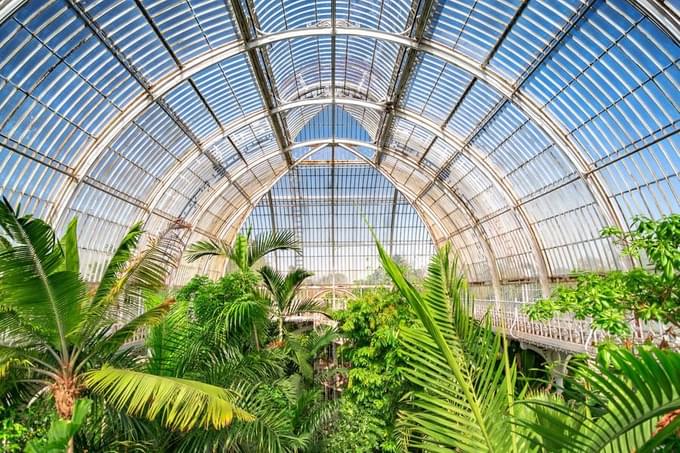
- Location : Kew Gardens is located in Kew, Richmond, London, TW9 3AE.
- Timings : Kew Gardens' timings are from 10 AM to 7 PM on weekdays, with the last entry at 6 PM. On weekends and bank holidays,Kew Gardens' timings are from 10 AM to 8 PM, with the last entry at 7 PM.
- Best time to visit : After you book the Kew Garden tickets , it is best to visit Kew Gardens London is in the early morning hours. You would encounter fewer crowds and will get ample time to explore all the attractions on the premises. The plants are also in full bloom during these hours, which lets you witness them at their best.
Must Checkout: London IFS Cloud Cable Car
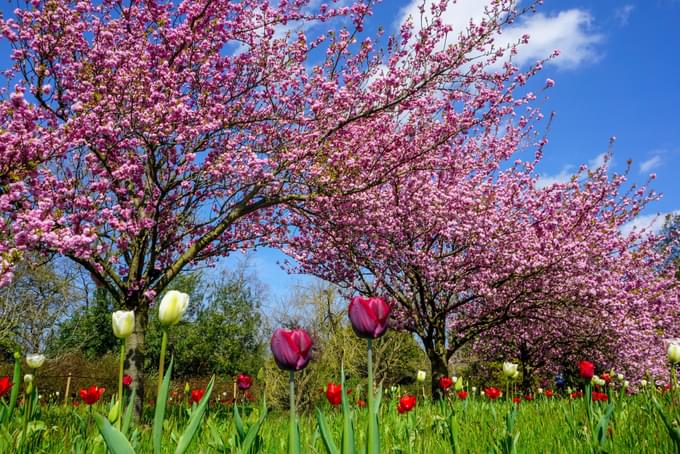
Here are the ways to reach Safari World Bangkok
- By Bike : If you want to know how to get to Kew Gardens by bike, then there are bicycle racks at the four gates of the Gardens. However, bicycles, tricycles, roller skates, skateboards, and scooters are not allowed inside the Gardens.
- By Bus: Curious about how to get to Kew Gardens by bus? No worries, there are a few bus routes that stop at the Gardens’ various gates. Route 65 stops near Lion Gate, Victoria Gate, and Elizabeth Gate. While Route 110 stops close to Kew Gardens station and Elizabeth Gate, Routes 237 and 267 stop at Kew Bridge station.
- By Tube : If the tube is your preferred mode of transport, here is how to get to Kew Gardens by it. Take the District Line or the London Overground, and hop off at the Kew Gardens station. The station is located 500 metres from Victoria Gate of Kew Gardens.
- By Car : Turn on the GPS and it will tell you precise directions on how to get to Kew Gardens by car from your location. Also, note that parking at the Gardens is minimal and is available for those who ask for it first. Parking is available at Kew Gardens Car Park, Kew Green, and Richmond Athletic Grounds. Disabled access parking bays and drop-off area is at Elizabeth Gate.
- By Boat : Visitors who wish to learn about how to get to Kew Gardens by boat can hop on the Thames River Boats that provide special services from Westminster Pier to Kew Pier. Sailing times from Westminster to Kew are from 11 AM and 2:30 PM, while those from Kew to Westminster are from 12:30 PM, 3:30 PM, and 5 PM.
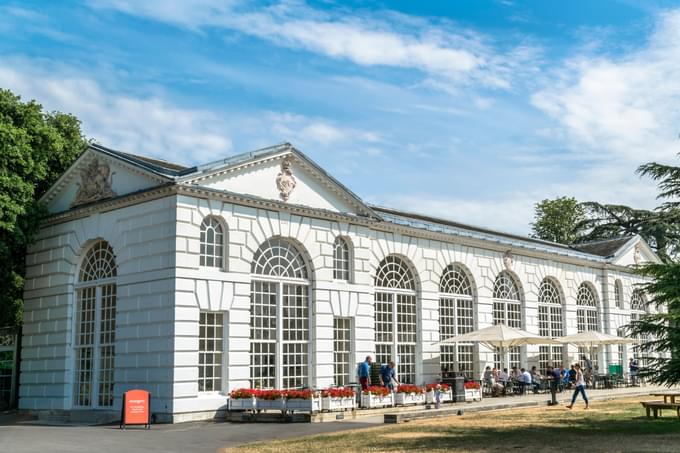
- Toilets : Unisex toilets have been provided within easy reach of all major Kew Gardens attractions. They can be found in Victoria Plaza, The Pond, Ruined Arch, Stable Yard, Kew Palace, Brentford Gate, White Peaks Café, Pavilion Bar and Grill, The Orangery, and the Botanical. The toilets are disabled-friendly and are attended to regularly. There are baby-changing facilities at all toilets except Stable Yard, while microwaves for warming milk bottles have been arranged for at White Peaks Café and The Orangery. There is also a special adult-changing facility at Brentford Gate.
- Wheelchairs : Kew Gardens is an accessible space for specially-challenged visitors. A limited number of wheelchairs are available when asked for on arrival at the entry gates for you and your essential caregiver. You would need to book in advance to avail yourself of mobility scooters, which are available at Victoria and Brentford Gates. If you have a pavement-use mobility scooter limited to 4 mph, you are welcome to bring it along.
- Shopping : Purchase a variety of Kew Gardens-inspired items after your memorable visit to the botanical paradise. The Family Kitchen and Shop is a brand-new space selling planting kits, toys, and books for curious children, while the Galleries Gift Shop at Shirley Sherwood Gallery has prints, gifts, and books inspired by Kew’s art collections. The Pavilion Shop and the Victoria Plaza Shop are perfect destinations for shopping for souvenirs like gift items, books, outdoor items, and lip-smacking food products. You can also shop from the Kew Online Shop and buy fantastic home décor, gardening gifts, and stationery.
- Restaurants and Cafes : When you need a break from exploring Kew Gardens, head to the numerous restaurants and cafes offering mouth-watering delicacies. The Family Kitchen and Shop, near Children’s Garden, has stone-baked pizza, salad bar, and ice cream servery and is perfect for family day-outs. The Orangery serves toasties, burgers, and even Lebanese Barbeque on its terrace, while Pavilion Bar and Grill offers iconic al fresco dining with views of the Temperate House and the Pagoda. Enjoy quick breaks at The Botanical Brasserie and the Victoria Plaza Café with their afternoon tea and barista coffee with snacks. All eateries have level access, and picnics are allowed throughout the Kew Gardens premises.
Also Explore: Activities at Kew Gardens in Autumn
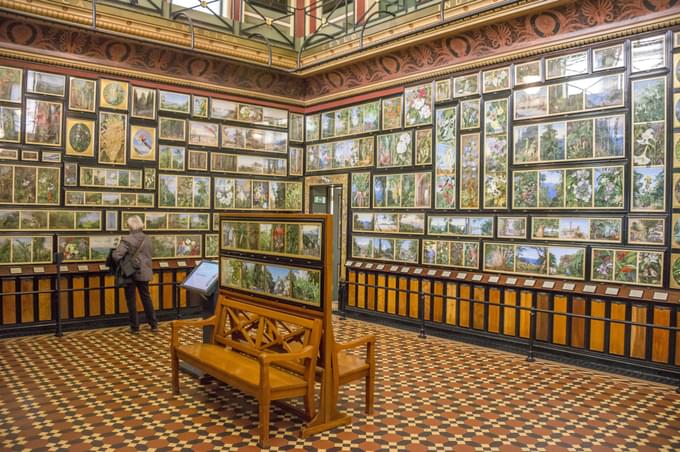
Explore the Kew Gardens Attractions
- Glasshouses : Of the numerous glasshouses at Kew Gardens, the Temperate House and the Alpine House are accessible by wheelchairs and mobility scooters. The other glasshouses are, however, unfortunately inaccessible. Also, during the Orchids Festival, the Princess of Wales Conservatory is partially accessible for wheelchairs.
- Galleries : Among the galleries of Kew Gardens, the Shirley Sherwood Gallery of Botanical Art is fully accessible by wheelchairs and also has a ramp at the entrance of the gallery. Another gallery with accessibility is the Marianne North Gallery, which can be accessed by a platform lift close to the Temperate House entrance. Marianne North can also accommodate larger electric wheelchairs as compared to Shirley Sherwood Gallery. These galleries are, however, not accessible for mobility scooters, and if needed, visitors can be provided with wheelchairs to use on arrival.
- Historic Buildings : The historic Kew Palace is accessible for wheelchairs and offers assisted wheelchair access and an accessible lift. The narrow corridors and doorways of the historical structure permit only small wheelchairs, with mobility scooters not allowed in either Kew Palace or the Royal Kitchens. Recognized guide, service, and assistance dogs, even assistance dogs in training, are allowed in the Kew Palace and Royal Kitchens. The Palace also offers two wheelchairs for those who need them to visit the historical premises.
Book Kew Gardens Tickets
Kew garden tickets, london, how long should one spend inside kew gardens.
To fully explore the vast Kew Gardens, one would require a minimum of three hours. The premises of the Gardens are huge and visitors need to walk a lot to visit all the attractions in store here. It is highly recommended that you explore all there is on offer at the Kew Gardens, and be warned, as you might even end up spending an entire day here
What is the best time to visit Kew Gardens?
The best time to visit Kew Gardens London is in the early morning hours. You would encounter fewer crowds and will get ample time to explore all the attractions on the premises. You would also get to experience the plants during their best hours in the daylight. It is recommended that you visit during the spring and summer months from March to October when the flowers are in full bloom.
Do Checkout: London To Stonehenge
Do we have to book in advance for Kew Gardens Tickets?
Kew Gardens London tickets can always be purchased at the walk-in ticket counters. However, it is highly recommended that you book your tickets in advance online to avoid the long queues. You will get the best value tickets online, and will also be able to book time slots as per your preference in advance
What is the minimum age required to book Kew Gardens Tickets?
Visitors of all age groups are welcome at Kew Gardens London. All those aged under sixteen need to be accompanied by adults at all times when inside the garden. Kew Gardens tickets are free of cost for children below the age of four. Those aged 16 to 24 get tickets at lower rates than older adults.
Are pets allowed inside Kew Gardens?
Registered disability assistance dogs are the only pet animals allowed inside the Kew Gardens . You would have to leave your pets at home while visiting Kew Gardens.
Inside Kew Gardens
About kew gardens, travel guide, attraction tickets, famous museums in london, cruises in london, famous theme parks in london, popular tours in london, historical places & museums in london, top experiences.

The content and images used on this site are copyright protected and copyrights vests with the respective owners.
© 2024 www.kewgardenstickets.com All rights reserved.
- Kew Tourism
- Kew Bed and Breakfast
- Kew Vacation Rentals
- Flights to Kew
- Kew Restaurants
- Things to Do in Kew
- Kew Travel Forum
- All Kew Hotels
- Kew Hotel Deals
- Things to Do
- Restaurants
- Vacation Rentals
- Travel Stories
- Rental Cars
- Add a Place
- Travel Forum
- Travelers' Choice
- Help Center
How long for visit to Kew Gardens ? And river walk to Ham - Kew Forum
- Europe
- United Kingdom (UK)
- England
- Greater London
- Richmond-upon-Thames
- Kew
How long for visit to Kew Gardens ? And river walk to Ham
- United States Forums
- Europe Forums
- Canada Forums
- Asia Forums
- Central America Forums
- Africa Forums
- Caribbean Forums
- Mexico Forums
- South Pacific Forums
- South America Forums
- Middle East Forums
- Honeymoons and Romance
- Business Travel
- Train Travel
- Traveling With Disabilities
- Tripadvisor Support
- Solo Travel
- Bargain Travel
- Timeshares / Vacation Rentals
- Richmond-upon-Thames forums

If possibly I’d also like to visit Kew Gardens. Could I be back in Kew for say 4 pm (allowing for a stop off for a drink, light lunch somewhere) would a couple of hours be long enough a Kew Gardens . I love nice gardens but I’m no Gardner so I don’t read all the info I just like the atmosphere and to wander. Is this too much in one day ? Any tips for visiting .. is the river near Ham as nice as I remember and worth doing ? Many thank for any advice
10 replies to this topic
The gardens are extensive. If you arrive at 4p.m you'll have until 7pm, 8pm on weekends and you'll need 3 hours. You'll need to book a time slot too.
Cant comment on the footpath, have not walked that way in ages but with that and the gardens you'd need to be fit.
I think you could do that walk in less than 3 hours depending on exact starting point at Ham.
The No 65 bus towards Kingston will take you near the river at Ham with a bit of an extra walk to the river.
When you arrive back at Kew you will be able to enter the gardens at Brentford gate next to the river and "zig zag" through towards Richmond.
Thank you. I’m hoping to eat around 8 pm so if 4-7 pm would be enough time that’s great. I do loads of walking so that’s no problem.
It is a very pleasant walk--just stay to the right and be aware that cyclists don't always announce their approach!
Probably didnt make myself clear - you could easily spend a day at Kew. However you can walk a reasonable part of it in 3 hours, less than that and it would be a waste of the entrance fee.
“Auld Jimmy” would that be one way ? I’ll be starting off dropping luggage at hotel in Kew. I was allowing a bit of time to stop on river for a drink / bite to eat. Should I take bus to Ham first & then walk back - sorry wasn’t totally understanding . Thank you so much 😊
"Auld Jimmy” would that be one way?
Should I take bus to Ham first & then walk back - sorry wasn’t totally understanding . "
Yes that is what I had in mind , that way you will arrive at Kew in the afternoon before they close.
Perfect . Thanks
For food Richmond is best, there is lots of choice and if you are too tired for more walking you have the option of taking the N65 bus back to Kew Gardens .
- Kew Gardens May 06, 2023
- Kew entry with vouchers May 05, 2023
- Christmas at Kew Apr 30, 2023
- Stuff to do/ eat near Kew gardens Jul 19, 2021
- How long for visit to Kew Gardens ? And river walk to Ham May 11, 2021
- planning a visit May 09, 2021
- Parking changes? Jul 29, 2020
- Kew Gardens Christmas season Dec 21, 2019
- Storage Sep 07, 2019
- Timed entry Aug 28, 2019
- Kew this Sunday Aug 28, 2019
- Parking at or near to Kew Gardens Aug 27, 2019
- Kew Jul 18, 2019
- Tickets Jul 03, 2019
Kew Hotels and Places to Stay
Today’s Events
Wednesday–Monday: 10:00 am–6:00 pm
Tuesday: Closed
Today’s Availability
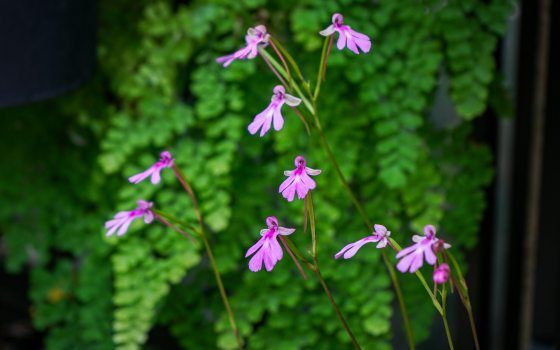
Cynorkis : A Jewel Box of Possibilities
What if there was a genus of orchid that was easy to grow, vigorous, nearly unkillable, only required active care for half the year, had attractive foliage, was incredibly floriferous, had beautiful flowers, and could (for the most part) easily fit on your windowsill? What if that genus was virtually unknown in cultivation, but was sitting right under our noses the entire time? That is precisely what we’ve discovered about the genus Cynorkis ! This genus, while in cultivation for at least 100 years, has been nearly unknown, ungrown, and has been hybridized very little—but we now are actively hybridizing them here at Longwood. It’s also potentially one of the greatest windowsill orchids you can grow at home—and our first hybrid Cynorkis — Cynorkis Longwood Pink Gem—is now on view for the first time in our Orchid House for the next week, and ready to delight.
The genus Cynorkis comes from Africa, with the greatest concentration of species in Madagascar and the southeast nations. It has about 190 species, although only perhaps a dozen are known in cultivation in the United States. Here at Longwood, we have six Cynorkis species in our collection, which—while not currently on view—have begun to form the building blocks of the Cynorkis hybrids in our collection.
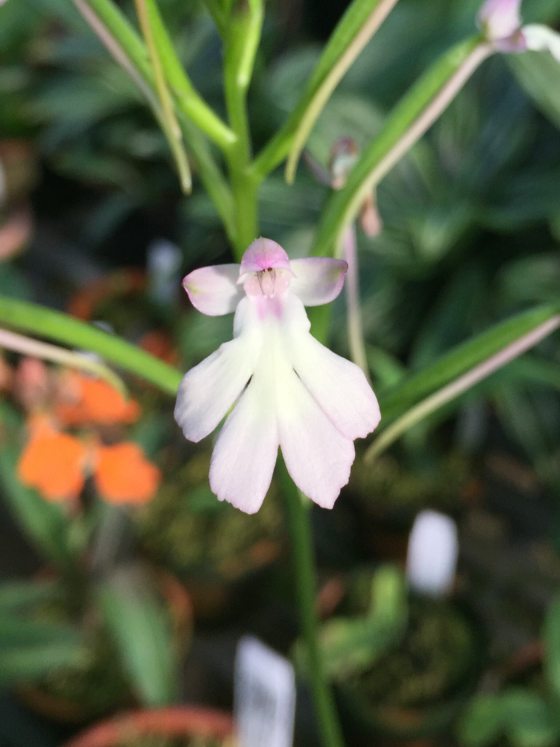
Among the most common of those species in cultivation is Cynorkis fastigiata , a miniature, self-pollinating species that grows at an incredibly fast rate, and of which you will have a few dozen seedlings appearing in every other pot around if the seedpods are left to open in a greenhouse or near other plants. Photo by Greg Griffis.
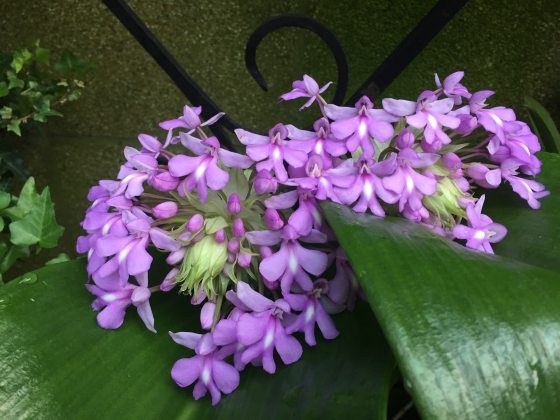
Cynorkis calanthoides ‘Peter’. Photo by Greg Griffis.
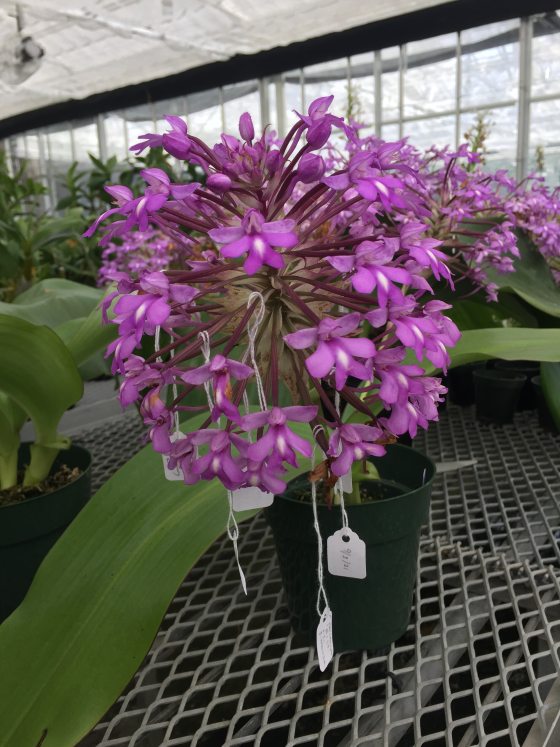
Cynorkis calanthoides ‘Longwood’s Best’ with pollination tags, a parent of many of our new hybrids. Photo by Greg Griffis.
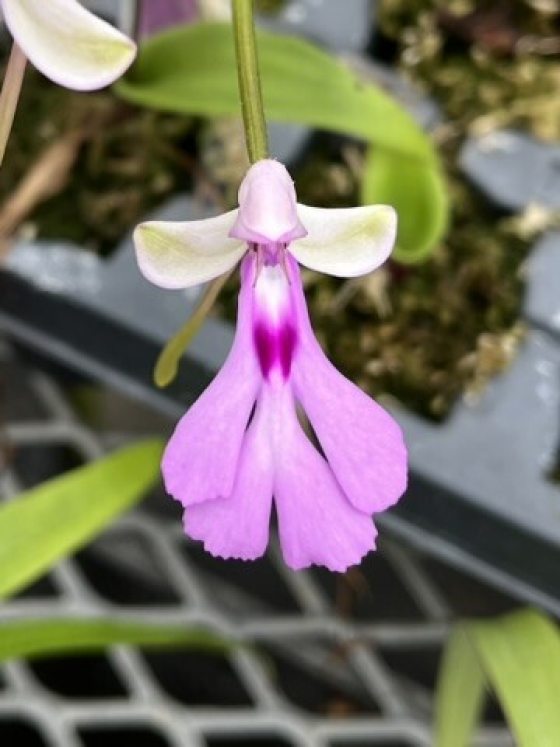
An attractive winter flowering species is Cynorkis lowiana , which is a small plant with large flowers, and with a purple lip with a dark purple splotch in the center of the lip. Photo by Greg Griffis.
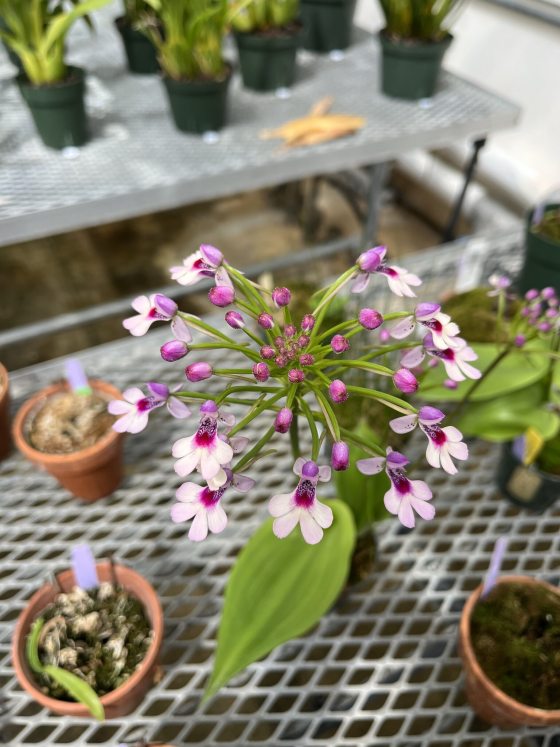
Cynorkis angustipetala is fairly common, and has tall umbels of numerous white to pale pink flowers, marked with a maroon splotch with typically purple or pink sepals. Photo by Greg Griffis.
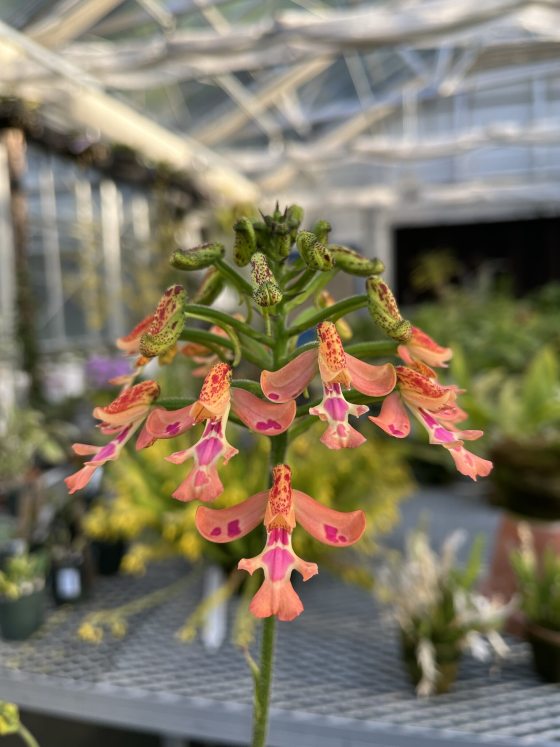
Perhaps one of the showiest species in cultivation, Cynorkis gibbosa has a striking orange flower with purple markings, and leaves that also have purple spots. Photo by Greg Griffis.
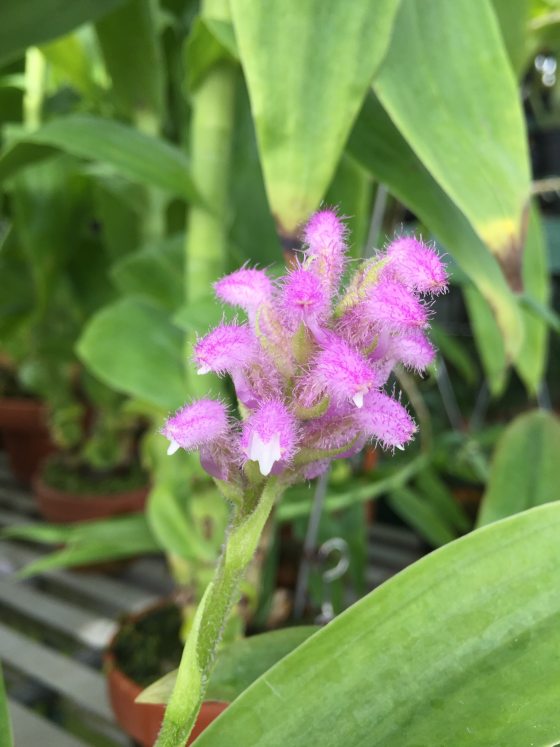
The last species we have here at Longwood is a little less common, but is quite interesting. Cynorkis villosa is named for its hairy flowers that are small and cupped, but it is a fascinating and beautiful sight to behold. Photo by Greg Griffis.

A good example of a typical lavender colored outcome of Cynorkis Longwood Pink Gem. Photo by Greg Griffis.
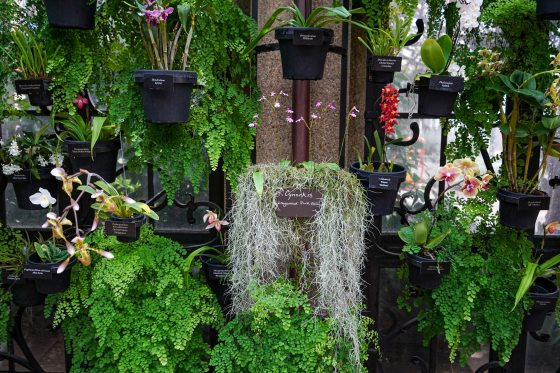
Cynorkis Longwood Pink Gem, on view now in our Orchid House. Photo by Carol Gross.
The potential for this group is only barely being uncovered now—we should flower another two or three hybrids this year, and in the future, who knows what is possible! These are truly lovely and fascinating little gems, and all the more precious because they are so easy to grow.
Categorized Under:
- DIY: Gardening, Recipes, and More ,
- Plants and Garden Design
Subscribe to the Longwood Blog
Related articles.
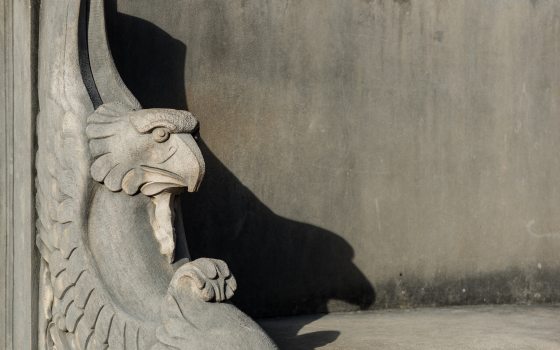
Do You Want to Know a Secret?
Our beloved Whispering Bench is not only a lovely place to sit and take in the view; it’s a place of physics, history, and curiosity, where secrets have been told—and fun has been had—for generations.
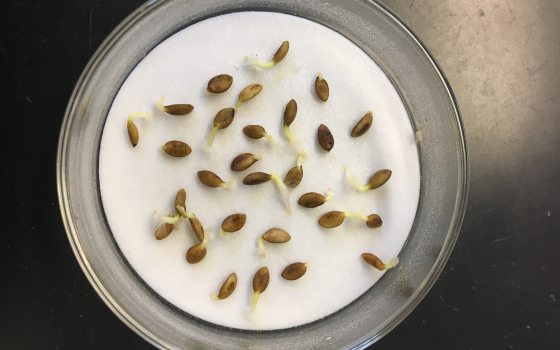
Seed Banking on the Future
With our recent award of a competitive grant from the Department of Conservation and Natural Resources as part of the Wild Resource Conservation Program, we are thrilled to be able to grow our efforts in preserving more species of conservation concern through the expansion of our seed bank.
Halloween at Kew
A trail filled with spooky fun for everyone.

Date and time
18 to 26 October 2024: 6pm to 10pm
27 October to 3 November 2024: 4pm to 10pm
Kew Gardens
Entrances at Elizabeth Gate and Brentford Gate only.
Member adult: Off Peak £15 / Peak £18
Non-member adult: Off Peak £17 / Peak £20
Family and child tickets available.
Tickets on sale 10am, Friday 10 May 2024
Brought to you by the producers of Christmas at Kew, this brand-new, after-dark Halloween trail is filled with so many hidden surprises.
Join family and friends to wander from dusk into darkness between one ghostly space to another. Watch out for flickering flames in a fiendish fire garden, daring fire artists and grinning pumpkins aglow. Wind your way through the illuminated haunted woods filled with creepy neon cobwebs, ghastly ghouls, wicked witches, larger-than life spiders and beastly bats. Could it be a trick of the light or do things really go “bump in the night”?
There’s a delicious twist to the sweetest of treats on offer. Enjoy a fiendishly good hot toddy* or devilishly decadent hot chocolate* and toast a marshmallow* with someone special.
Your very spookiest Halloween starts here. Limited capacity with timed entry. Plan now to secure the date and time of your choice.
*separate charges apply
Important information
- There will be limited capacity with timed entry to Halloween at Kew so make sure to plan now to secure the date and time of your choice.
- Daylight – sessions up to 6pm. Most suitable for very young ones who need to get back home to bed early!
- Twilight – sessions from 6pm-7.30pm. The scare level ramps up a notch.
- Moonlight – sessions after 7.30pm. As scary as it gets (but still suitable for all)
- The Gardens close at 10pm with last entry at 8.30pm and certain dates last entry is 8pm.
- Bicycles, tricycles, roller skates, skateboards, micro-scooters, balance bikes and other vehicles (except powered wheelchairs) aren't permitted at this event and must be left at the gates.
- Have a question about Halloween at Kew? Read our FAQs.

In partnership with RG Live and Sony Music.
Exclusive discount
Become a member now to get exclusive discounts to this and other Kew showstopping events, unlimited visits to the Gardens, 10% off in the shops and other benefits year round.
Become a member

- Facebook page Facebook
- Twitter page Twitter
- Instagram page Instagram
- YouTube page YouTube

IMAGES
COMMENTS
There is so much to see and do on a visit to Kew Gardens. Here's some essential information to help plan your trip. The Temperate House will be closed from 22 April to 2 May 2024 to install artworks for our upcoming exhibition Marc Quinn: Light into Life. We apologise for any inconvenience caused. Check our planned closures page before you ...
Take the District Line towards Richmond. Approx. Travel Times: 15 minutes from Earl's Court and 30 minutes from Westminster on the District Line to Kew Gardens Station (Zone 3). Top Tip: If steps are a problem for you, for example, if you are traveling with a child in a buggy, go to Richmond station (it's only one more stop) and come back on ...
KEW GARDENS ULTIMATE GUIDE. Open: Everyday: 10:00AM to 4:15PM. Time Needed: 3 hours. Price: £15. Don't let the word "gardens" fool you, because Kew's Royal Botanical Gardens are more than just collections of pretty flowers to snap photos of. As a matter of fact, the Kew Gardens are actually a living, breathing collection of some of the ...
Kew Gardens is situated in the South West of London, in the beautiful neighbourhood of Richmond upon Thames. Being the largest UNESCO world heritage site in London and more than 250 years old, Kew Gardens is the home of the Millennial Seed Bank, the biggest wild plant seed bank in the world. The Kew Estate occupies an area of 121 hectares home ...
Kew Gardens opening times. In peak season Kew is open from Monday to Friday, 10am to 7pm (last entry 6pm) and Saturday, Sundays & Bank Holidays, 10am to 8pm (last entry 7pm). There is early entry available for members. Times change during the year and the garden closes around 4pm in the winter.
If you love Kew, help us conserve the world's plants and fungi and protect the millions of lives that depend on them. Explore our wild botanic garden in Sussex, with 500 acres of ornamental gardens, woodlands and a nature reserve. Discover the world of science behind our botanical collections, with over 50,000 living plants to be found across ...
Kew Gardens in a Nutshell. 🪷 Overview: Nestled about 30 minutes from Central London, it's a UNESCO World Heritage Site that exists since 1759 and has over 30,000 different plant and seed species from around the world. 📍 Location: Conveniently located at Richmond (TW9 3AE), it's just a stone's throw away from the Kew Gardens station ...
This station is just 500m from the Victoria Gate entrance at Kew Gardens. You can take one direct tube, on the District Line, from London Victoria to Kew Gardens Underground Station. Tubes leave every 15 minutes and the journey takes approximately 30 minutes. Tickets cost between £2 - £5.
The nearest stations are Kew Bridge, Kew Gardens and Richmond. There are a variety of cafes and restaurants at Kew Gardens, each serving up delicious grub using seasonal and local produce. Kew Gardens is open daily from 10am - 5pm (last entry at 4pm). Ticket prices start from £4 per child and £12 per adult.
Royal Botanic Gardens, Kew, Kew: "How long do I need to allow to get around Kew..." | Check out 9 answers, plus see 9,219 reviews, articles, and 11,926 photos of Royal Botanic Gardens, Kew, ranked No.2 on Tripadvisor among 11 attractions in Kew.
History of Kew Gardens. Kew Gardens has a long history dating back to the 16th century when privately owned gardens were tended there. In 1731, ... If you would like to visit Kew Gardens by boat, Thames River Boats operate a special service from Westminster Pier to Kew Pier. Elizabeth Gate, the closest entrance to Kew Pier, is only a 0.2-mile ...
Best time to visit the Kew Gardens Spring (April to May) is when the garden start showing signs of new blooms and starts displaying its eye-catching flora collections. Summer (June to August) ... Standing 18 metres tall and 200 metres long, the walkway is designed to slightly sway in the wind to give a more immersive experience through the ...
Kew Gardens, located just a short subway ride from central London, is the world's largest collection of living plants in the world.. Founded in 1840, the garden hosts over a million visitors annually.. We have visited twice and thoroughly enjoyed both visits. Below we'll cover the main topics to make your visit delightful.
With its Victorian glasshouses, arboretum, and artwork, there is a lot to see. Here are eight of the garden's attractions that no visitor should miss. Jeff Eden / RBG Kew. 1. The Great Pagoda. The Great Pagoda was completed in 1762 as a gift for Princess Augusta, who founded Kew Gardens.
How long you'll need to Visit Kew Gardens. I thought I would spend an entire day at Kew Gardens, but surprisingly we only needed 3-4 hours. The entire area is huge, so it may take longer if you're committed to seeing every corner of the park. We arrived at around 2 and left at 6, and still had plenty of time to explore more of London in the ...
For a 3 hour visit, that's our limit these days, we focus on a small section. The little train, while slightly hokey, gives a decent overview for a first time, and shows just how big a portion of the Gardens is. The sunken garden around Kew Palace is impressive. The Palm House and the Temperate House are worth 30 to 40 minutes minimum each.
Westminster to Kew: 11am. 2.30pm. Kew to Westminster: 12.30pm. 3.30pm. 5pm. Sailing times may vary, check the Thames River Boats site for more information. Plan your journey to Kew Gardens with our suggested routes to our easy-to-reach gates.
Kew Gardens Temperate House from the Pagoda. Kew Gardens is a botanic garden in southwest London that houses the "largest and most diverse botanical and mycological collections in the world". Founded in 1840, from the exotic garden at Kew Park, its living collections include some of the 27,000 taxa curated by Royal Botanic Gardens, Kew, while the herbarium, one of the largest in the world, has ...
Location: Kew Gardens is located in Kew, Richmond, London, TW9 3AE.; Timings: Kew Gardens' timings are from 10 AM to 7 PM on weekdays, with the last entry at 6 PM.On weekends and bank holidays,Kew Gardens' timings are from 10 AM to 8 PM, with the last entry at 7 PM. Best time to visit: After you book the Kew Garden tickets, it is best to visit Kew Gardens London is in the early morning hours.
And river walk to Ham. 2 years ago. The gardens are extensive. If you arrive at 4p.m you'll have until 7pm, 8pm on weekends and you'll need 3 hours. You'll need to book a time slot too. Cant comment on the footpath, have not walked that way in ages but with that and the gardens you'd need to be fit. Reply.
Visit Royal Botanic Gardens, Kew. My fascination with plants is a result of watching countless documentaries by David Attenborough. The Kingdom of Plants is, in fact, my very favourite, a series of films created here, in the UK, at the Royal Botanic Gardens of Kew.. The Royal Botanic Gardens of Kew is a wonderful space for plant lovers who wish to spend their day meandering around one of the ...
With hybridizing Cynorkis, our goal is to create compact hybrids with short (12- to 18-inch) inflorescences that carry between one- to two-dozen flowers; are well arranged in an umbel; have full, round, flat shape; and bright, eye-catching colors.These plants would be mature and approaching specimen size in a 5- or 6-inch pot, and will grow easily and reliably, flowering at least once a year ...
Kew Gardens. Open today Open today: 10:00 am - 7:00 pm (last entry 6:00 pm) Kew, Richmond, London, TW9 3AE. 020 8332 5655. [email protected]. Book tickets to Kew Gardens. Tickets. Become a Kew member. Membership